« October 2005 | Main | December 2005 »
November 29, 2005
Million Dollar Homepage
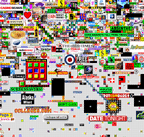
Anything Smaller Would Be Too Small
"...[E]veryone is welcome to buy my pixels, which are available in 100-pixel 'blocks' (each measuring 10x10 pixels). You will see the homepage is divided into 10,000 of these 100-pixel blocks (hence there are 1,000,000 pixels in total). The reason for selling them in 100-pixel blocks is because anything smaller would be too small to display anything meaningful.
You can buy as many pixels as you like, as long as there are some available on The Million Dollar Homepage (see the live stats in the top right corner of the page). When you buy some pixels, you can then display an image/ad/logo of your choice in the space you have purchased. You can also have the image click through to your own website. However, no obscene or offensive images are allowed.
The pixels you buy will be displayed on the homepage permanently. The homepage will not change. Using some of the money I make from the site, I guarantee to keep it online for at least 5 years, but hopefully much longer. I want it to become a kind of internet time capsule. So, in the long run, I believe the pixels will offer good value. You will have a piece of internet history!" [thanks Ratchet Up]
Posted by jo at 12:48 PM | Comments (0)
Don Ritter Performances
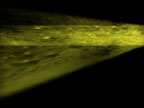
Digestion and Badlands
Don Ritter Performances in Budapest, December 4, 2005; Intro Festival Millinenáris Park, Budapest, Hungary.
Digestion:
Influenced by early 20th Century experimental animation, Digestion presents organic imagery--originating as boiling water--that is interactively transformed into a series of mechanical movements with synchronized sound emanating from the imagery. Using a pair of networked computers, viewers are presented with a hypnotic experience of multi-channel imagery that is controlled by sound. The seemingly unpredictable nature of the work provides an internal interactivity which can be observed by an audience, but not controlled.
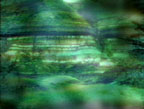
Badlands: Processed imagery of the Canadian Badlands are controlled and manipulated by live music. One or two networked computers use a musical analysis of live music to control clip selection, tempo and cinematic features of the video.
Since 1988, Don Ritter's interactive performances have been presented at festivals, museums, and galleries in North America and Europe, including the Art Institute if Chicago, New Music America (New York), Montreal Museum of Contemporary Art, and Steim (Amsterdam). [Related]
Posted by jo at 12:13 PM | Comments (0)
'Location is not enough!'
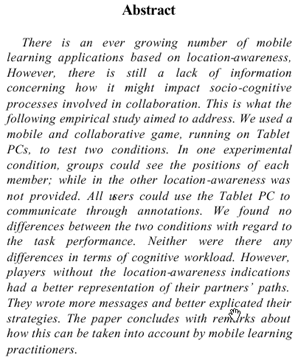
Nova, N., Girardin, F. & Dillenbourg, P.:'Location is not enough!': an Empirical Study of Location-Awareness in Mobile Collaboration" (.pdf). Full paper for IEEE International Workshop on Wireless and Mobile Technologies in Education, Tokushima, Japan. Nicolas' slides are here (.pdf). [blogged by nicolas on pasta and vinegar]
Posted by jo at 09:50 AM | Comments (0)
Spacerace
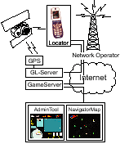
Virtual Crystals Treasure Hunt
Spacerace--by Stephan A. Drab and Gerald Binder--is a location based game for mobile phones designed to demonstrate the possibilities of an Assisted GPS empowered mobile phone:
"The goal of the treasure hunt game Spacerace is to collect as many virtual crystals as possible in a small outdoor area. In order to collect a crystal, the Captain has to get near the virtual position of the selected crystal. He is guided by an Assisted GPS phone which shows the current distance to it. He is supported by the Navigator who has an overview of the position of the Captain and all the crystals they have to collect.
The Navigator tells the Captain which crystal to go after and where it is located by giving him directions in terms of points of the compass. The captain selects the suggested crystal number and tries to find it using the Navigator’s directions and the distance displayed on the screen of the mobile phone. After getting close to the desired virtual destination the crystal is collected and the team scores an amount of points. Crystals have a lifetime after which they disappear. The amount scored by the team after finding a crystal is dependent on the remaining lifetime. The faster the team finds the crystal, the more points they get." [blogged by nicolas on pasta and vinegar]
Posted by jo at 09:33 AM | Comments (0)
Preemptive Media

Tokyo RFID map
Zapped!/Preemptive Media mapped the results of their investigation about RFID use in Tokyo. Preemptive Media are the guys who presented a video about the development of RFID technology, a display of "awareness" stickers and a cage of Madagascan giant hissing roaches at Thought Crimes: The Art of Subversion a few months ago. Preemptive Media attached reprogrammed RFID tags to the roaches that, if placed in a Wal-Mart store, will taint its RFID database. The group distributed the roaches at the show's opening, sending them home with gallery goers in Styrofoam coffee containers.
The idea is not to encourage paranioa, but rather participation and preparation! Via RFID in Japan. [blogged by Regine on we-make-money-not]
Posted by jo at 08:01 AM | Comments (0)
November 28, 2005
DISTANCE
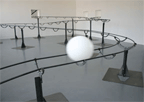
Introducing Disturbing Elements into Neutral Art Venues
Configured as a rollercoaster, Distance, created in 2004, explores Jeppe Hein’s interest in art as a game. Consisting of a set of rails roughly 1,000 feet in length, Distance dips and rolls, continually switching back on itself in loops. As the viewer enters the exhibition space, he/she activates a sensor that shoots a large white ball along the rails along which it will roll through twists and turns in the gallery space. The viewer is able to follow the ball’s course by foot, tracing its movement across the gallery and at the same time, becoming an active participant in the installation. Hein revels in exploiting the deceptive potential of his work. His installations can best be described as interventions since they introduce disturbing elements into neutral art venues or public spaces that destabilize the art viewing habits of the gallery visitor.
The pared-down geometrical objects in these installations obey the formal principles of minimal or c onceptual art, but in keeping with Duchampian tradition, they become real works of art when the viewer innocently activates them. Hein’s objective is to establish an incongruous dialogue between the art and the viewer and to use humor to broaden the limits of conceptual art. This project was originally created for the Ludwig Forum, Aachen, Germany, and later it was presented at Dunkers Kulturhus in Helsingborg, Sweden. The Moore Space version is the largest presentation of this work so far and it is the first solo exhibition of the artist’s work in the United States.
Born in 1974 in Copenhagen, Jeppe Hein studied at the Royal Academy of Arts of Copenhagen and in the Hochschule für Bildende Künste of Frankfurt. He lives and works in Berlin. He had a solo exhibition at the Centre Pompidou, Paris in the Fall of 2005. In addition, Hein has shown at the Venice Biennial in 2003 and at PS1 in New York.
DISTANCE, Jeppe Hein at The Moore Space. Guest Curator: Christine Macel, curator for contemporary art in charge of the Department of Prospective and Contemporary Creation, Musée National d’art moderne, the Centre Pompidou, Paris.
Posted by jo at 06:28 PM | Comments (0)
Walking from Thoughts: Not the Muscles Are Crucial, but the Brain Waves!
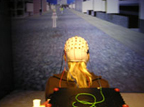
Thoughts wander in VR
"Devices that allow for direct brain-computer communications are advancing on two fronts: devices implanted in the brain, and external electrodes that pick up the brain's electrical signals. In general the external devices are safer and cheaper, but the implants provide more control.
Typically, users are able to control their brain waves in a way that moves a cursor up and down and side to side on a computer screen.
Researchers from Graz University of Technology in Austria, University College of London in England, Guger Technologies OEG in Austria and the University of Graz in Austria have expanded the amount of control available via external electrodes with a means of detecting changes in brain signals when users imagine moving their feet and translating the effect into walking motion within a virtual reality environment. Continue reading at TRN Research News.
Posted by jo at 06:06 PM | Comments (0)
Hydrophonics + Radiator Symposium
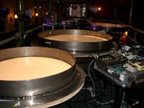
Exploring Different Approaches to the 'Live Event'
A live webcast of sound from the other side of the world to the surface of water. The innovative concept of Hydrophonics stems from Locke’s fascination with technology, waterflow, the idea of ‘seeing sound’, of visualising kinetic energy and exploring different approaches to the ‘live event’. Over the past four years she has experimented widely by sending a variety of sounds through water to see the different formations each sound makes on the water surface.
Locke has worked with musicians to compose music based on the sight of the composition, rather than the sound of it, and developed new designs for water tanks and speaker systems. The Sonic Arts Group at Monash University will be playing and developing music especially for the event. This will be sent across the world to the water tanks in the UK where the audience will experience the ripples and fountains on the surface of the water. Hydrophonics is part of the Radiator and Digital Cultures SYMPOSIUM.

2 - 4 Dec 2005 Nottingham / Fri & Sat 10am - 6.30pm / Sun 10am - 4pm: This three day international symposium aims to bring into focus artistic practices of live performance that make use of digital technology in the form of lens-based, networked or locative media.
On a global stage, artists from different geographies can enter transcontinental collaborations raising the question of how the digitisation of the arts has transformed cultural traditions and practices. The symposium will bring together leading practitioners, developers, scientists and theorists from the disciplines that make up new media performance including live art, locative and pervasive media, telematics, performance and dance, wearable, sensor based and cybernetic technologies. CONTACT: Nina on Tel +44(0)115 840 9272 info[at]radiator-festival.org
Posted by jo at 12:47 PM | Comments (0)
Dance Unlimited (DU) Amsterdam
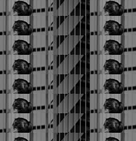
Choreography/New Media Program
Established in 2002, Dance Unlimited (DU) Amsterdam is a unique two-year masters program* supporting the study of the relationship between choreography, performance and new media technologies. The program takes the development of choreographic work as its starting point, and new media technologies and practices are approached from this perspective. We are looking for artists with a solid educational and professional dance background who wish to engage in a study of the relationship between choreography, performance, and new media technologies.
DEADLINE: 29 January 2006; CONTACT: Ellen van Haeringen: e.vanhaeringen[at]ahk.nl
Posted by jo at 12:41 PM | Comments (0)
Kodak Lecture Series:

DAVID ROKEBY
WEBCAST LIVE & ARCHIVED--The Kodak Lecture Series is pleased to announce that Toronto artist David Rokeby will present a talk about his work on Friday, December 2, at 7:30 pm at Ryerson University in Toronto, Canada.
David Rokeby has won acclaim in both artistic and technical fields for his new media artworks. A pioneer in interactive art and an acknowledged innovator in interactive technologies, Rokeby has achieved international recognition as an artist and seen the technologies which he develops for his work given unique applications by a broad range of arts practitioners and medical scientists.
Born in Tillsonburg, Ontario in 1960, Rokeby studied at the Ontario College of Art where he began to use technology to make pieces that directly engage the human body, or that involve artificial perception systems. His best known work, Very Nervous System (1986-90), premiered at the Venice Biennale in 1996, won the first Petro-Canada Award for Media Arts (1988) and is permanently installed in several museums around the world. Rokeby has twice been honored with Austria's Prix Ars Electronica Award of Distinction (1991 and 1997). He has been an invited speaker at events around the world, and has published two papers that are required reading in the new media arts faculties of many universities. He received a Governor General's Award in Visual and Media Arts in 2002. [Related 1, 2]
Posted by jo at 12:20 PM | Comments (0)
Tampopo
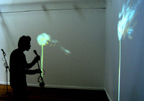
Predictable and Non Predictable Patterns
"TAMPOPO is Japanese for dandelion, and in Japan, as is in New Zealand, dandelions occupy a sphere of folklore. A simple action of blowing creates a space amongst the bustle of human doings, it creates a direct relationship with nature, and it acts as a trigger of memories and nostalgic journeys. Perhaps it triggers memories of wishes made and long since forgotten.
The subject in TAMPOPO is a giant looming dandelion, an interactive digital work that lets you blow on the head of the dandelion and watch its spores gently drift away. Yamada is interested in creativity in computer programming, and how creative code has opened up new possibilities for new worlds. He creates environments using computer-programming techniques, and generates a simulation of the natural environment in a digital realm. Yamada sees programming as a structure that is not the antithesis of nature, but also as a responsive environment in itself. Both the programming environment and the natural environment are full of conditions and variables, of predictable and non predictable patterns."
Posted by jo at 12:07 PM | Comments (0)
Intelligent Agent Vol 5 No 1 Update
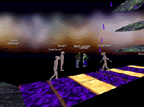
Aesthetics of Play and Empathy
"What is cyberspace? Like most important questions, the answer depends very much on whom you ask. Cyberspace seems to be highly mutable; it wears different guises for divergent questioners, depending very much on what type of glasses they are wearing. And the computer certainly qualifies as a strange kind of mirror -- the more deeply they scry its virtual depths, the more enthralled many theorists become by its digitized mutual gaze. So vast is the quantity of information available on the Internet that attempts to master the big picture cannot help but become highly self-selecting. Yet most can agree that one of the standout characteristics of the new digital paradigm which fascinates theorists and practitioners alike is its apparent revolutionary character, its fundamental newness..."
"The aesthetics which I propose can aid us to see something fresh are an 'aesthetics of play and empathy.' These terms have longstanding associations in a psychoanalytic context, as well as in other cultural contexts including art history, Buddhist studies, feminism and the post-colonial, among others." From Building a Bridge to the Aesthetic Experience: Artistic Virtual Environments and Other Interactive Digital Art by Tobey Crockett, Intelligent Agent, Vol 5 No 1.
Posted by jo at 11:54 AM | Comments (0)
intelligent agent Vol. 5 No. 1 Update

Heightening Tension and Drama in 3D Interactive Environments
"Abstract: Heightening tension and drama in 3D interactive environments is a hard, but important problem. It is important for its potential utility in increasing motivation, involvement, engagement, and providing an overall pleasing aesthetic experience. These constructs are not only useful for entertainment applications, but can also impact training and edutainment applications due to the impact of emotions on learning. To stimulate emotional engagement, many researchers have explored several techniques, including enhancing the story content, developing new algorithms for dynamically creating stunning visual effects, and enhancing 3D sound. In this paper, I describe a set of new design techniques based on a study of film and theatre theories, including acting and screenwriting. These design techniques are integrated within a multi-agent interactive drama architecture. In this paper, I will discuss this architecture elaborating on the implementation of the theories studied and discussed from film and performance arts." Applying Principles from Performance Arts for an Interactive Aesthetic Experience by Magy Seif El-Nasr, Intelligent Agent, Vol 5 No 1.
Posted by jo at 11:35 AM | Comments (0)
November 23, 2005
TechnoLust

Zones Light Up via Electronic Caresses
Interesting concept of wearable gaming device. TechnoLust blends technological lust with a program to reawaken carnal lust. The gaming device takes advantage of wireless Internet technology. Players wear it as an undergarment to travel out of the virtual world of the computer to find and play with opponents
TecnoLust is a game of body erotic zones that are lit up by electric caresses. Upon entering the game players select the mode they want to play within, this sends out a frequency which attracts other players set on the same game and frequency. When a participant encounters another a game of electronic caresses begins where pulses are sent back and forth electronically to arouse the senses. Designed in 2002 by Peter Allen and Carla Murray, KnoWear. [blogged by Regine on we-make-money-not]
Posted by jo at 06:51 PM | Comments (0)
RealReplay
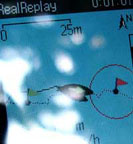
GPS Racing on your Mobile Phone
Paul has updated his list of mobile phone games using GPS or cell towers signals. Here's one of the latest additions: With RealReplay, you can choose the track you want to race on, select your opponent and start playing with everyone, without being dependent on their time.
Whether you're in a car, on a bike, or a sailing boat, all you have to do is tell your mobile phone to start recording. The phone will capture your every movement using GPS. Set checkpoints to define the key parts of your track. Your future opponents will have to pass them and get information on their intermediate time.
Others will find your track and race against you – even without you being present! If you'd like to pit your strength against your friends, inform them about the area where your race starts. They can then accept your challenge whenever they want.
On the display of your mobile phone you will always see your current position and route, as well as the one your opponent took when he recorded his race, which is played back as a replay. Developed by Mopius. [blogged by Regine on we-make-money-not]
Posted by jo at 06:46 PM | Comments (0)
4th Telematic Forum

Call For Papers: IS - Internet e Storia (Internet and History)
Call For Papers: IS - Internet e Storia (Internet and History) 4th Forum 15 January - 15 March 2006.
The topics for the 4th telematic forum are Internet, History and all subjects related to the application of multimedia technology to History and, in general to Human Studies. Each speaker presents an abstract through the specifically prepared mailing-list. Essays will be placed on the official site, which could be consulted by signed members. Acts will be published in «Storiadelmondo» ISSN 1721-0216, public access electronic journal dealing with world-wide History and Human Studies. Papers will be published also in CD-ROM edition.
Submission Information: Speakers participate on invitation or by self-candidature through the official site pages. Website (English, Italiano, Español) Submissions in electronic form (DOC; RTF; TXT) are strongly preferred. Scholars at all stages of their careers are equally welcome (required short bio-bibliography). The candidature must arrive within the January 9, 2006 for papers and/or review of: books, websites, softwares.
For application instructions and further information about the IS - Internet
e Storia, contact:
Secretary's office
Medioevo Italiano Project
E-mail: posta[at]medioevoitaliano.it
Web: http://www.medioevoitaliano.it
Fax: +39.06.23319240
V.le O. Sinigaglia, 48
I-00143 Rome, Italy
Posted by jo at 06:27 PM | Comments (0)
The Port
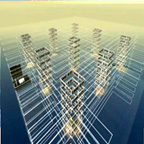
Arena for Experiments
The Port is a place, a community and an arena for experiments. It is a 16-acre virtual island located inside the online world Second Life. The island is a 3d-model, collaboratively shaped by its users. The Port is open and accessible to all Second Life inhabitants and potentially to all internet users. Regarding The Port as a piece of land renews questions of spatiality in an online context.
Members of The Port Community belong to an international network of artists, architects, thinkers, researchers and programmers collaboratively exploring (1) the notion of value-creation in an online environment, (2) the nature of immaterial production and ownership, (3) the interlacing of an online and off-line reality, (4) possibilities for virtual worlds to function as public space and (5) the concept of communality in a trans-local sphere.
Projects already initiated include developing new musical instruments, an expanded white board for discussions, architectural structures and a garden, an alternative currency with backing in virtual land as well as continually producing in-world TV reports and staging live music and dance performances.
Posted by jo at 01:25 PM | Comments (0)
Objects of Virtual Desire
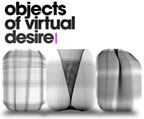
Highlighting the Materiality of the Immaterial
Objects of Virtual Desire explores immaterial production in a virtual world, and if and how this can be transferred into an economy of material production. We have collected a series of objects produced and owned by inhabitants in the online world Second Life and will sell physical reproductions of these objects via our web shop.
Each chosen object has a strong sentimental value for the avatar (a persons virtual identity) who made or owned it. We have acquired (copies of) these objects, along with their owner’s personal story, within the in-world economy of Second Life. At www.objectsofvirtualdesire.com we present 3D modeled reproductions of these objects. The objects are made available in physical form on demand. When buying the materialised object one will also receive an image of the immaterial object with its original Second Life owner.
Our interest lies in exploring the concept of product design in a virtual world and what kind of interpersonal value objects carry in this context. Further questions are raised by transferring these objects to physical space and a "first life" economy. What is immaterial value-creation and can it be materialised? What does it mean to use a virtual world as a site of production?
The issues raised are relevant in a wider context, as value-production in the "post-fordist" era has become increasingly immaterial. Nike, for example, exploits the physical function of a shoe to create and market immaterial values, so pervasive that the shoe itself becomes almost virtual.
Objects of Virtual Desire exploits the augmented value of immaterial objects to create and market tangible products, thereby reversing the process and highlighting the materiality of the immaterial.
Posted by jo at 01:21 PM | Comments (0)
FLACK ATTACK ON AUTONOMY:

CALL FOR SUBMISSIONS
We invite you to contribute to Flack Attack, a new magazine coming out of The Port, a community-driven space initiated by Sim on Goldin & Jakob Senneby inside the online 3D world Second Life (http://secondlife.com/). The production process of Flack Attack will be continually featured on artport, the Whitney Museum's portal to Internet Art, as a gate page during the month of December 2005. Using The Port as a point of departure we are pursuing a series of investigations into the potential of networked public spheres and the organization of participatory production.
Production: The production model of Flack Attack magazine is based on the wiki concept and the workflow starts with the set-up of the wiki.
Theme: The theme of the first issue is "Flack Attack on Autonomy": Autonomy as a complex concept in any governed situation. What does it mean to be autonomous within predefined social codes? Does the notion of autonomy contradict a common language and shared references?
In the specific case of online worlds the challenge is readily illustrated by the fact that all interaction takes place inside someone else's programmed code. But the same basic dilemma can be applied to any institution we find ourselves in, be it a nation, a family or an economy.
Submissions: The wiki is open to all, and we encourage a wide range of contributions on the topic of autonomy: everything from the structural and analytical to the personal and anecdotal.
Contributions can take the form of:
+articles
+comments
+images
+alterations/remixes of other contributions
Please submit your contributions between now and December 19 at http://www.flackattack.org
Editorial Meetings: An editorial office is being set up at The Port (inside the online world Second Life). Open meetings for discussing and editing the wiki contributions will be held at the office three times a week during December. All final decisions about the magazine and what will be included in the printed version will be made at the editorial meetings. The more you engage, the more you will be able to influence the outcome.
The editorial office will also function as design studio, community center, and place for further reflection.
The editorial meetings will take place every Tuesday, Thursday, and Sunday in December, starting on Thursday, December 1 (editorial offices will be closed on Sunday December 25). Meeting times will be as follows (depending on your time zone):
Tuesdays (December 6, 13, 20, 27):=20
1 AM West Coast USA
4 AM East Coast USA
9 AM UK
10 AM Central Europe
6 PM Japan
Thursdays (December 1, 8, 15, 22, 2):
5 PM West Coast USA
8 PM East Coast USA
Friday 1 AM UK
Friday 2 AM Central Europe
Friday 10 AM Japan
Sundays (December 4, 11, 18)
1 PM West Coast USA
4 PM East Coast USA
9 PM UK
10 PM Central Europe
Monday 6 AM Japan
Directions: For those who will visit The Port and Second Life for the first time, please proceed as follows: Go to http://secondlife.com/ to get a free acount anda personal avatar (you need to give credit card details for security). Simply follow the instructions, download the customized software on your computer, and design your avatar. Allow yourself approx. 2 hours for this. Then click "Find" and search for "The Port" under "Places" (checking the "include mature areas" box). Click "Teleport" and you will arrive at The Port!
If you need help or have any questions when in Second Life, please send IM (Instant Message) to VoyeurOne Baron or Sorgaard Jacques.
The process of working with Flack Attack will be continually mediated through artport, the Whitney Museum's portal to Internet Art between 1 and 31 December.
Publication: By the end of December the first issue of Flack Attack will be published. We are planning to distribute it as PDF and print-on-demand via artport. (In addition, free printed copies might be distributed through the bookstore of the Whitney Museum in New York).
Simon Goldin & Jakob Senneby, Initiators of The Port & Flack Attack
The Port: http://www.theport.tv/
Flack Attack: http://www.flackattack.org
Second Life: http://secondlife.com/
Artport: http://artport.whitney.org/
Posted by jo at 01:16 PM | Comments (0)
Living Wall

Network of Sonic Memories
Living Wall--by Åsmund Gamlesaeter and Alexander Berman--is an installation collecting, recomposing and playing sonic memories. The computational processes that take place are displayed on 3000 white LEDs. Microphones record fragments of human interaction. Each fragment is then analysed using an adaptive sound categorization technique, determining its relation to previously stored clips.
The network of sound clips is reorganized in real time as new fragments are recorded and connections between previously stored clips are elaborated. Fragments with similar perceptual qualities are grouped in clusters and dissimilar clips are separated from each other. As time goes by the network evolves into a rich mass of information with complex interconnections.
Recomposed sequences of sound are played back into the space by walking through the network of sonic memories. The sounds are distributed into the space based on a mapping from the network position to a position in the room. For the developers, this behaviour is parallel to the behaviour of how we associate ideas. Living Wall is a permanent installation at Studentersamfundet in Trondheim, Norway. [blogged by Regine on we-make-money-not]
Posted by jo at 11:18 AM | Comments (0)
Viral Counter Attack
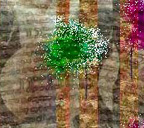
Art Viruses Need Paintings
In Viral Counter Attack--by Joseph Nechvatal and Music2eye--colonies of "art viruses" are slowly destroying digital paintings. They "eat" the images to survive and generate offspring. Players compete or cooperate to control artifial viral colonies. They have to move their bodies to guide the movements of the virus on the screen.
Overhead cameras capture the direction and the intensity of players' movements. The data is automatically translated in real time on the activity of the viruses. Each gamer can control one colony (identified by a colour) and they have to survive as long as possible by guiding the colony towards areas "rich with nutritious resources". But they can also attack other colonies. More images. Video. [blogged by Regine on we-make-money-not]
Posted by jo at 11:13 AM | Comments (0)
Circuit City:
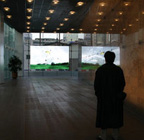
Tom Vanderbilt on Pixelated Architecture
"...The screen, along with the skyscraper, has for some time been one of the particular features of Asian modernity. The screen-centric vision of Los Angeles famously depicted by Ridley Scott in Blade Runner (1982) was, the director has noted, inspired by his time in 1960s Hong Kong, a paradoxical city whose pulsating electronic skyline overlooked a harbor, as Scott has described, filled with nineteenth-century fishing junks. But those screens were merely static vehicles for the transmission of commercial messages, mechanical upgrades of an older public-advertising tradition. What is most interesting about the screens I found in Seoul was that they were not merely architectural appendages broadcasting messages but architecture itself; not simply vehicles for delivering one-way information to a passive public but an active layer of the city's matrices of networks. To stand on a street was to stand on a street of a hundred screens, and by "screens" I mean the external manifestation—the collective user-interface—of the unseen digital flow pulsing down that same street, invisible but as much a part of the city experience as the concrete of the sidewalks..." From Circuit City: Tom Vanderbilt on Pixelated Architecture, Artforum.
Posted by jo at 10:51 AM | Comments (0)
San Francisco Film Society

Wireless Media Call for Entries
This is an invitation to submit work to the San Francisco Film Society for consideration to be included in the 49th San Francisco International Film Festival taking place April 20 May 4, 2006. In specific, this call is for a program that will focus on a series of visual works made by and/or for wireless media devices and signals. Roughly this breaks down into three categories: 1. Works made by mobile devices 2. Works made to be specifically viewed on mobile devices. 3. Works that use wireless signals a new aesthetic medium.
SUBMISSIONS: Telephonic communication has always been a two-way street. You send messages, you receive messages. Now, a myriad of wireless communications devices also record and playback text messages, still images, sound and video. But the transmission principle is the same. These recordings are sent or received and cover distance. What's changed is the multi-use functions of telecommunications hardware. Mobile devices have become special tools for interacting with the mediated world. The question this program will explore is how do these mobile devices enable new methods of production, distribution and/or exhibition. We invite you to submit your work to help us form an answer.
Submissions due: January 3, 2006
Final Decisions: February 17, 2006
The San Francisco International Film Festival will present a multi-varied program of "mobiley" inspired work.
We especially encourage works that use mobile technologies, wireless signals, text or animation as new type of recording tool or medium, and/or articulate the difference and urgency of exhibiting on tiny, portable screens.
CALL: If you have questions or would like more information, please email: programming[at]sffs.org.
Sean Uyehara
Programming Associate
suyehara@sffs.org
Direct 415.561.5011
San Francisco Film Society
Presenter of the 49th San Francisco International Film Festival, April 20 - May 4, 2006
Enter your film at http://www.sffs.org
Final film entry deadline, December 9, 2005
Final wireless media entry deadline, January 3, 2006
Interested in hearing about San Francisco Film Society screenings and events?
Sign up for our monthly enewsletter
Posted by jo at 10:41 AM | Comments (0)
Nuisance

"Still Warm" Everyday Art Project
PLEASE CONTRIBUTE! Melanie is currently developing an art project that is based on digital photographs taken by people of their beds and pillows first thing in the morning - while (as the title suggests) they are 'still warm'. Her aim is to collect over a hundred photographs in order to stage an exhibition/database about 'waking up'. She is therefore calling (in a pleading way) for submissions. If you would like to contribute/help, please email Melanie a photograph (preferably 1000px although smaller is ok) to misses[at]yeeking.net. Her only requirement is that the photo is taken while your bed is literally still warm with the time and date of your snap. It would only take a few minutes and your anonymity will be protected if you so wish.
This will be be part of a larger art practice-based research project about the way people relate to everyday objects and spaces. This involves making drawings, films, bibliographies, databases and much of it involves the participation and collaboration of others.
Posted by jo at 10:35 AM | Comments (0)
Spin

Liquid (tele)vision Mediation
The tv medium's deconstruction is often based on a radical intervention on its essential mechanism: continous and hypnotic entertainment based on frequent light and color changes. TV has the universally acknowledged role of awareness' persuader, through the allurance of senses, obtained with a narcotic bulimia of contents. Now more than ever there are tools and approached that can dismatle and exploit this role as an input for different purposes. Spin by Liz Nofziger is a work that simply add another visual level between the screen and the viewer, beaming the tv contents onto an enormous 'disco ball', endless rotating in the restricted space of a gallery, reflecting the same contents on the walls, and so illuminating them. The above mentioned mechanisms are then liquified in the ball's facets, and the same ball evolves from a funky knick-knacks to a visual mediator, splitting pictures in pieces that are (dis)composed on the wall. Then the stratagems to direct the viewer's attention on the screen are exploited to generate marvellous effects and transform the visual information fluxes in abstract sequences. [via neural.it]
Posted by jo at 10:27 AM | Comments (0)
Slowscan Soundwave (III)
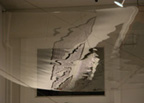
Sonic Presences
The sound has always been 'immaterial' (well before the digital data), and it has always fascinated our perceptive apparati, because of its fleeting 'presence'. The sonic presence, in fact, organically is revealed through the eardrum vibrations and in the consequent electric signals sent to our brain. This is a common theme the sonic artists love to play with, till its essence, that is the remaining senses' perception of the sounds around us. Slowscan Soundwave (III) by Douglas Irving Repetto is an installation made with long semi-transparent polyester (mylar) strips that moves accordingly to the environment sounds, through a system made out of motors, strings and pulleys. These strips are illuminated by soft lights and so they generates shadows and reflections, moving unanimously, emulating a complex system moved by frequencies. The ethereal transparency and the strips' vibrations in waves materialize the abstract representation made by sinewaves in audio software. The atavic processes of the sounds' transmission through the air are reproduced with analogic mechanic tools, after being made public through the digital interfaces. [via neural.it] [Related]
Posted by jo at 10:22 AM | Comments (0)
SOUNDplay Festival & AGM06

International Call for submissions
New Adventures in Sound Art and AGM 06 is currently accepting submissions for inclusion in both the 2006 SOUNDplay festival and AGM 06 (October 2006) that will feature video/sound art works that place equal artistic importance on image and sound and emphasizes non-narrative elements and abstraction. Both emerging and established artists will be featured in the festivals. We encourage artists to submit works that are less than 20 minutes in length.
SOUNDplay, produced by New Adventures in Sound Art, is a meeting point for experimentation in new media and sound art, encouraging new fusions of image, sound & text. New Adventures in Sound Art is a non-profit organization that produces performances and installations spanning the entire spectrum of electroacoustic and experimental sound art. Included in its Toronto productions are: Deep Wireless, Sound Travels, Sign Waves and SOUNDplay.
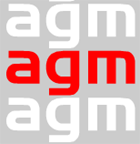
AGM, based in Copenhagen, builds annual artistic collaborations and develops new connections among participating artists and audiences around Europe and other parts of the world. AGM 06 will feature Canadian new media works and screenings among a selection of international works for the 2006 event in Berlin and Copenhagen.
Please submit the following for consideration:
- VHS or DVD copy of the work
- a description or program note of the work
- biographies of the principle creators of the work.
Deadline: Received by December 16, 2005 at 5pm EST.
Note: we will request permission from the artist before any works are screened and at that time will request a screening master of the work. Unless otherwise requested, NAISA would like to retain copies sent for consideration in future festivals.
Please send submissions to:
New Adventures in Sound Art
401 Richmond Street West #358
Toronto, Ontario
Canada
M5V 3A8
phone: (416) 910-7231
e-mail: naisa[at]soundtravels.ca
ORF Kunstradio
Argentinierstrasse 30a
A-1040 Wien
Posted by jo at 10:12 AM | Comments (0)
What is code?
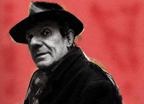
A conversation with Deleuze, Guattari and code
What is code? A conversation with Deleuze, Guattari and code by David M. Berry & Jo Pawlik.
--Code--
The two of us wrote this article together. Since each of us was several, there was already quite a crowd. We have made use of everything that came within range, what was closest as well as farthest away. We have been aided, inspired multiplied [1].
JP: Code is described as many things: it is a cultural logic, a machinic operation or a process that is unfolding. It is becoming, today's hegemonic metaphor; inspiring quasi-semiotic investigations within cultural and artistic practice (e.g. The Matrix). No-one leaves before it has set its mark on them...
DB: Yes, it has become a narrative, a genre, a structural feature of contemporary society, an architecture for our technologically controlled societies (e.g. Lessig) and a tool of technocracy and of capitalism and law (Ellul/Winner/Feenberg). It is both metaphor and reality, it serves as a translation between different discourses and spheres, DNA code, computer code, code as law, cultural code, aristocratic code, encrypted code (Latour).
JP: Like the code to nourish you? Have to feed it something too.
DB: Perhaps. I agree that code appears to be a defining discourse of our postmodernity. It offers both explanation and saviour, for example, the state as machine, that runs a faulty form of code that can be rewritten and re-executed. The constitution as a microcode, law as code. Humanity as objects at the mercy of an inhuman code.
JP: True and it gathers together a disturbing discourse of the elect. Code as intellectual heights, an aristocratic elect who can free information and have a wisdom to transform society without the politics, without nations and without politicians. Code becomes the lived and the desired. Both a black box and a glass box. Hard and unyielding and simultaneously soft and malleable.
DB: Code seems to follow information into a displaced subjectivity, perhaps a new and startling subject of history that is merely a reflection of the biases, norms and values of the coding elite. More concerning, perhaps, code as walls and doors of the prisons and workhouses of the 21st Century. Condemned to make the amende honorable before the church of capital.
JP: So, we ask what is code? Not expecting to find answers, but rather to raise questions. To survey and map realms that are yet to come (AO:5). The key for us lies in code's connectivity, it is a semiotic-chain, rhizomatic (rather like a non-hierarchical network of nodes) and hence our map must allow for it to be interconnected from anything to anything. In this investigation, which we know might sometimes be hard to follow, our method imitates that outlined by Deleuze & Guattari in Anti-Oedipus (2004). It will analyse by decentering it onto other dimensions, and other registers (AO:8). We hope that you will view this article as a 'little machine' (AO: 4), itself something to be read slowly, or fast, so that you can take from it whatever comes your way. It does not ask the question of where code stops and the society starts, rather it forms a tracing of the code-society or the society-code.
DB: Dystopian and utopian, both can cling like Pincher Martin to code. Code has its own apocalyptic fictions; crashes and bugs, Y2K and corruption. It is a fiction that is becoming a literary fiction (Kermode). We wish to stop it becoming a myth, by questioning code and asking it uncomfortable questions. But by our questioning we do not wish to be considered experts or legislators, rather we want to ask again who are the 'Gods' of the information age (Heidegger). By drawing code out and stretching it out, we hope to make code less mysterious, less an 'unconcealment that is concealed' (Heidegger).
JP: Perhaps to ask code and coders to think again about the way in which they see the world, to move from objects to things, and practice code as poetry (poeisis). Rather than code as ordering the world, fixing and overcoding. Code as a craft, 'bringing-forth' through a showing or revealing that is not about turning the world into resources to be assembled, and reassembled forever.
DB: And let us not forget the debt that code owes to war and government. It has a bloody history, formed from the special projects of the cold war, a technological race, that got mixed up with the counter-culture but still fights battles on our behalf. He laid aside his sabre. And with a smile he took my hand.
--Code as concept--
DB: A stab in the dark. To start neither at the beginning or the end, but in the middle: code is pure concept instantiated into the languages of machines. Coding is the art of forming, inventing and fabricating structures based on these languages. Structures that constrain use as well as free. The coder is the friend of the code, the potentiality of the code, not merely forming, inventing and fabricating code but also desiring. The electric hymn book that Happolati invented. With electric letters that shine in the dark.
JP: And what of those non-coders who use code, or rather are used by code instead of forming it? Code can enable but it can also repress. Deleuze believes that we live in a society of control and that code is part 'of the numerical language of control' requiring of us passwords, user names, and the completion of form fields to either grant or deny access to information, goods and services (1992).
DB: Yes, code becomes the unavoidable boundary around which no detour exists in order to participate fully in modern life. It is ubiquitous. Formatted by code, harmonised with the language of machines, our life history, tastes, preferences and personal details become profiles, mailing lists, data and ultimately markets. Societies of control regulate their population by ensuring their knowing and unknowing participation in the marketplace through enforced compatibility with code. Watch over this code!... Let me see some code!
JP: But there is no simple code. Code is production and as such is a machine. Every piece of code has components and is defined by them. It is a multiplicity although not every multiplicity is code. No code is a single component because even the first piece of code draws on others. Neither is there code possessing all components as this would be chaos. Every piece of code has a regular contour defined by the sum of its components. The code is whole because it totalises the components, but it remains a fragmentary whole.
DB: Code aborescent. Plato's building agile, object-oriented and postmodern codes under the spreading chestnut tree.
JP: But computers are not the only machines that use code. Deleuze believes that everything is a machine, or to be more precise every machine is a machine of a machine. By this he means that every machine is connected to another by a flow'whether this flow is air, information, water, desire etc'which it interrupts, uses, converts and then connects with another machine.
DB: I agree that human beings are nothing more than an assemblage of several machines linked to other machines, though century's worth of history have us duped into thinking otherwise.
JP: But, does every machine have a code built into it which determines the nature of its relations with other machines and their outputs? How else would we know whether to swallow air, suffocate on food or drink sound waves? There is even a social machine, who's task it is to code the flows that circulate within it. To apportion wealth, to organise production and to record the particular constellation of linked up flows that define its mode of being.
DB: Up to this point, code is verging towards the deterministic or the programmatic, dependent upon some form of Ur-coder who might be synonymous with God, with the Despot, with Nature, depending on to whom you attribute the first and last words.
JP: But Deleuze delimits a way of scrambling the codes, of flouting the key, which enables a different kind of de/en-coding to take place and frees us from a pre-determined input-output, a=b matrix. Enter Desire. Enter Creativity. Enter the Schizo. Enter capitalism? You show them you have something that is really profitable, and then there will be no limits to the recognition of your ability.
--Code as Schizo--
DB: Deleuze & Guattari warned us that the Schizo ethic was not a revolutionary one, but a way of surviving under capitalism by producing fresh desires within the structural limits of capitalism. Where will the revolution come from?
JP: It will be a decoded flow, a 'deterritorialised flow that runs too far and cuts too sharply'. D & G hold that art and science have a revolutionary potential. Code, like art and science, causes increasingly decoded and deterritorialised flows to circulate in the socius. To become more complicated, more saturated. A few steps away a policeman is observing me; he stands in the middle of the street and doesn't pay attention to anything else.
DB: But, code is bifurcated between a conceptual and a functional schema, an 'all encompassing wisdom [=code]'. Concepts and functions appear as two types of multiplicities or varieties whose natures are different. Using the Deluezean concept of Demon which indicates, in philosophy as well as science, not something that exceeds our possibilities but a common kind of these necessary intercessors as respective 'subjects' of enunciation: the philosophical friend, the rival, the idiot, the overman are no less demons that Maxwell's demon or than Einstein's or Heseinberg's observers. (WIP: 129). Our eyes meet as I lift my head; maybe he had been standing there for quite a while just watching me.
JP: Do you know what time it is?
HE: Time? Simple Time?... Great time, mad time, quite bedivelled time, in which the fun waxes fast and furious, with heaven-high leaping and springing'and again, of course, a bit miserable, very miserable indeed, I not only admit that, I even emphasise it, with pride, for it is sitting and fit, such is artist-way and artist-nature.
--Code and sense perception--
DB: In code the role of the partial coder is to perceive and to experience, although these perceptions and affections might not be those of the coder, in the currently accepted sense, but belong to the code. Does code interpolate the coder, or only the user? Ideal partial observers are the perceptions or sensory affections of code itself manifested in functions and 'functives', the code crystallised affect.
JP: Maybe the function in code determines a state of affairs, thing or body that actualises the virtual on a plane of reference and in a system of co-ordinates, a dimensional classification; the concept in code expresses an event that gives consistency to the virtual on a plane of immanence and in an ordered form.
DB: Well, in each case the respective fields of coding find themselves marked out by very different entities but that nonetheless exhibit a certain analogy in their task: a problem. Is this a world-directed perspective'code as an action facing the world?
JP: Does that not consisting in failing to answer a question? In adapting, in co-adapting, with a higher taste as problematic faculty, are corresponding elements in the process being determined? Do we not replicate the chains of equivalence, allowing the code, to code, so to speak, how we might understand it?
DB: Coders are writers, and every writer is a sellout. But an honest joy/Does itself destroy/For a harlot coy.
JP: We might ask ourselves the following question: is the software coder a scientist? A philosopher? Or an artist? Or a schizophrenic?
AL: For me the only code is that which places an explosive device in its package, fabricating a counterfeit currency. Which in part the knowing children sang to me.
Dr. K: This man is mad. There has been for a long time no doubt of it, and it is most regrettable that in our circle the profession of alienist is not represented. I, as a numismatist, feel myself entirely incompetent in this situation.
DB: For Deleuze, the ascription of these titles exceeds determining whether the tools of the trade in question are microscopes and test-tubes, cafes and cigarettes, or easels and oil-paints. Rather they identify the kind of thinking that each group practices. Latour claimed that if you gave him a laboratory he could move the world. Maybe prosopopoeia is part of the answer, he should ask code what it thinks.
JP: But not just the kind of thinking, but the kind of problems which this thought presupposes, and the nature of the solutions that it can provide. To ask under which category the coder clicks her mouse is to question whether she is creating concepts as opposed to dealing in functives like a scientist, or generating percepts and affects like an artist.
DB: If you're actually going to love technology, you have to give up sentimental slop, novels sprinkled with rose water. All these stories of efficient, profitable, optimal, functional technologies.
JP: Who said I wanted to love technology?
DB: The philosopher loves the concept. The artist, the affect. Do the coders love the code?
JP: If we say that code is a concept, summoning into being or releasing free software as an event, the coder is cast first and foremost as a philosopher. The coder, as philosopher, could neither love nor covet her code prior to its arrival. It must take her by surprise. For the philosopher, or more specifically the conceptual personae through whom concepts come to pass and are given voice, (Deleuze does not strictly believe in the creativity of an individual ego), Deleuze reserves a privileged role in the modern world which is so woefully lacking in creation and in resistance to the present. He writes: 'The creation of concepts in itself calls for a future form, for a new earth and people that do not yet exist' (1994, 108). Deleuze would hope this future form would be recognizable by virtue of its dislocation from the present.
DB: If the software coder really is a philosopher, what kind of a future is free software summoning and who are the new people who might later exist?
JP: Thanks to computers, we now know that there are only differences of degree between matter and texts. In fact, ever since a literary happy few started talking about 'textual machines' in connection with novels, it has been perfectly natural for machines to become texts written by novelists who are as brilliant as they are anonymous (Latour). But then is there no longer any difference between humans and nonhumans.
DB: No, but there is no difference between the spirit of machines and their matter, either; they are souls through and through (Latour).
JP: But don't the stories tell us that machines are purported to be pure, separated from the messy world of the real? Their internal world floating in a platonic sphere, eternal and perfect. Is the basis of their functioning deep within the casing numbers ticking over numbers, overflowing logic registers and memory addresses?
DB: I agree. Logic is often considered the base of code. Logic is reductionist not accidentally but essentially and necessarily; it wants to turn concepts into functions. In becoming propositional, the conceptual idea of code loses all the characteristics it possessed as a concept: its endoconsistency and its exoconsistency. This is because of a regime of independence that has replaced that of inseparability, the code has enframed the concept.
--Code as science--
DB: Do you think a real hatred inspires logic's rivalry with, or its will to supplant, the concept? Deleuze thought 'it kills the concept twice over'.
JP: The concept is reborn not because it is a scientific function and not because it is a logical proposition: it does not belong to a discursive system and it does not have a reference. The concept shows itself and does nothing but show itself. Concepts are really monsters that are reborn from their fragments.
DB: But how does this relate to the code, and more specifically to free software and free culture? Can we say that this is that summoning? Can the code save us?
JP: Free software knows only relations of movement and rest, of speed and slowness, between unformed, or relatively unformed, elements, molecules or particles borne away by fluxes. It knows nothing of subjects but rather singularities called events or hecceities. Free software is a machine but a machine that has no beginning and no end. It is always in the middle, between things. Free software is where things pick up speed, a transversal movement, that undermines its banks and accelerates in the middle. But that is not to say that capital does not attempt to recode it, reterritorialising its flows within the circuits of capital.
DB: A project or a person is here only definable by movements and rests, speeds and slowness (longitude) and by affects, intensities (latitude). There are no more forms, but cinematic relations between unformed elements; there are no more subjects but dynamic individuations without subjects, which constitute collective assemblages. Nothing develops, but things arrive late or in advance, and enter into some assemblage according to their compositions of speed. Nothing becomes subjective but haecceities take shape according to the compositions of non-subjective powers and effects. Maps of speeds and intensities (e.g. Sourceforge).
JP: We have all already encountered this business of speeds and slowness: their common quality is to grow from the middle, to be always in-between; they have a common imperceptible, like the vast slowness of massive Japanese wrestlers, and all of a sudden, a decisive gesture so swift that we didn't see it.
DB: Good code, Bad code. Deleuze asks: 'For what do private property, wealth, commodities, and classes signify'? and answers: 'The breakdown of codes' (AO, 218). Capitalism is a generalized decoding of flows. It has decoded the worker in favour of abstract labour, it has decoded the family, as a means of consumption, in favour of interchangeable, faceless consumers and has decoded wealth in favour of abstract, speculative, merchant capital. In the face of this, it is difficult to know if we have too much code or too little and what the criteria might be by which we could make qualitative distinctions between one type of code and another, such as code as concept and code as commodity.
JP: We could suggest that the schizophrenic code (i.e. the schizophrenic coding as a radical politics of desire) could seek to de-normalise and de-individualise through a multiplicity of new, radical collective arrangements against power. Perhaps a radical hermeneutics of code, code as locality and place, a dwelling.
DB: Not all code is a dwelling. Bank systems, facial recognition packages, military defence equipment and governmental monitoring software is code but not a dwelling. Even so, this code is in the domain of dwelling. That domain extends over this code and yet is not limited to the dwelling place. The bank clerk is at home on the bank network but does not have shelter there; the working woman is at home on the code but does not have a dwelling place there; the chief engineer is at home in the programming environment but does not dwell there. This code enframes her. She inhabits them and yet does not dwell in them.
--Code as art--
JP: You are right to distinguish between code as 'challenging-forth' (Heidegger) and code that is a 'bringing-forth'. The code that is reterritorialised is code that is proprietary and instrumental, has itself become a form of 'standing-reserve'.
DB: So how are we to know when code is a 'bringing-forth'? How will we know if it is a tool for conviviality. How will we distinguish between the paranoiac and the schizophrenic?
JP: We know, that the friend or lover of code, as claimant does not lack rivals. If each citizen lays claim to something then we need to judge the validity of claims. The coder lays claim to the code, and the corporation, and the lawyer, who all say, 'I am the friend of code'. First it was the computer scientists who exclaimed 'This is our concern, we are the scientists!'. Then it was the turn of the lawyers, the journalists and the state chanting 'Code must be domesticated and nationalised!' Finally the most shameful moment came when companies seized control of the code themselves 'We are the friends of code, we put it in our computers, and we sell it to anyone'. The only code is functional and the only concepts are products to be sold. But even now we see the lawyers agreeing with the corporations, we must control the code, we must regulate the code, the code must be paranoiac.
DB: This is perhaps the vision offered by William Gibson's Neuromancer, a dystopian realization of the unchecked power of multinational corporations which, despite the efforts of outlaw subcultures, monopolize code. Through their creation of AI entities code becomes autonomous, it exceeds human control. If indeed it makes sense to retain the term human, which Gibson pejoratively substitutes with 'meat'. The new human-machinic interfaces engendered by software and technological development demand the jettisoning of received categories of existence as they invent uncanny new ones.
JP: This is the possibility of code. The code as a war machine. Nomadic thought. The code as outsider art, the gay science, code as desiring-production, making connections, to ever new connections.
DB: Code can be formed into networks of singularities into machines of struggle. As Capital de-territorializes code there is the potential through machines to re-territorialize. Through transformative constitutive action and network sociality'in other words the multitude'code can be deterritorializing, it is multiplicity and becoming, it is an event. Code is becoming nomadic.
JP: This nomadic code upsets and exceeds the criteria of representational transparency. According to Jean Baudrillard, the omnipresence of code in the West'DNA, binary, digital'enables the production of copies for which there are no originals. Unsecured and cut adrift from the 'reality' which representation has for centuries prided itself on mirroring, we are now in the age of simulation. The depiction of code presents several difficulties for writers, who, in seeking to negotiate the new technological landscape, must somehow bend the representational medium of language and the linear process of reading to accommodate the proliferating ontological and spatio-temporal relations that code affords.
DB: This tension is as palpable in Gibson's efforts to render cyberspace in prose (he first coined the term in Neuromancer) as it is on the book cover, where the flat 2D picture struggles to convey the multi-dimensional possibilities of the matrix. The aesthetics of simulation, the poetics of cyberspace and of hyperreality are, we might say, still under construction.
JP: Perhaps code precludes artistic production as we know it. Until the artist creates code and dispenses with representational media altogether, is it possible that her work will contribute only impoverished, obsolete versions of the age of simulation?
DB: Artists have responded to 'code' as both form and content. As form, we might also think of code as 'genre', the parodying of which has become a staple in the postmodern canon. Films such as 'The Scream' series, 'The Simpsons', or 'Austin Powers'; flaunt and then subvert the generic codes upon which the production and interpretation of meaning depends. More drastically, Paul Auster sets his 'New York Trilogy' in an epistemological dystopia in which the world does not yield to rational comprehension as the genre of detective fiction traditionally demands. If clues are totally indistinguishable from (co)incidental detail, how can the detective guarantee a resolution, how can order be restored? As Auster emphasizes, generic codes and aesthetic form underwrite ideological assumptions and can be described as the products of specific social relations.
JP: And what of code as content? Like the 'Matrix'. Here is a film which has latched onto the concept of code and also its discussion in contemporary philosophy, almost smugly displaying its dexterity in handling both.
DB: Or 'I' Huckabees' with its unfolding of a kind of existential code that underlies human reality. Are our interpretations shifting to an almost instrumental understanding of code as a form of weak structuralism? Philosophy as mere code, to be written, edited and improved, turned into myth so that our societies can run smoothly.
JP: The hacker stands starkly here. If code can be hacked, then perhaps we should drop a monkey-wrench in the machine, or sugar in the petrol tank of code? Can the philosopher be a model for the hacker or the hacker for the philosopher? Or perhaps the hacker, with the concentrations on the smooth, efficient hacks, might not be the best model. Perhaps the cracker is a better model for the philosophy of the future. Submerged, unpredictable and radically decentred. Outlaw and outlawed.
DB: Perhaps. But then perhaps we must also be careful of the fictions that we both read and write. And keep the radical potentialities of code and philosophy free.
Wet with fever and fatigue we can now look toward the shore and say goodbye to where the windows shone so brightly.
- --Notes--
[1] We were, in fact, at least four, and we think you can guess who
the others were.
- --Bibliography--
Deleuze, G. (1990). Postscript on the Societies of Control. L'autre
Journal, Nr. 1.
Deleuze, G. (2004). Foucault. London: Continuum.
Deleuze, G., & Guattari, F. (1994). What is Philosophy? London: Verso.
Deleuze, G., & Guattari, F. (2004). Anti-Oedipus: Capitalism and
Schizophrenia. London: Continuum.
Deleuze, G., & Guattari, F. (2003). A Thousand Plateaus: Capitalism
and Schizophrenia. London: Continuum.
--License--
(c) 2005 David M. Berry, Jo Pawlik
This article is made available under the "Attribution-Share-alike" Creative Commons License 2.0 available from http://creativecommons.org/licenses/by-sa/2.0/.
--About the authors--
David Berry is a researcher at the University of Sussex, UK and a member of the research collective The Libre Society. He writes on issues surrounding intellectual property, immaterial labour, politics, free software and copyleft.
Jo Pawlik is a doctoral student at the University of Sussex researching the interaction between the American counterculture and French poststructuralism, focusing in particular on the deployment and political purchase of the concepts of madness and schizophrenia.
Originally published in Free Software Magazine. PDF
Posted by jo at 09:30 AM | Comments (0)
November 22, 2005
European Media Art Festival

Smart Art
The European Media Art Festival is one of the most important current media art forums world-wide. For the 19th time, the festival will present a comprehensive overview spanning the whole range of this young genre of art.
Under the motto Smart Art, we will present works that question social conventions, take familiar things out of their context and subtly track down the absurdities of individual and social everyday life. The approaches range from popular subjects to provocative statements that go down new paths of artistic debate in film, installation and expanded media, making playful and intelligent use of various media.
With their critical, cheeky and smart works, both young talented artists and recognised masters of their field present new positions in contemporary media art in Osnabrück.
// CINEMA Experimental shorts and feature films, music videos, new forms of narration and documentation, retrospectives and special programmes.
// EXHIBITION Current film and video installations, new nonlinear projects from 10 May to 18 June 2006 at the Kunsthalle Dominikanerkirche.
// LIVE ART Multimedia performances, veejaying and current concepts of expanded cinema.
// CONGRESS Expert speakers, curators and artists present their experiences and stances towards current media art in theoretical discourses, using practical examples. An international conference on art and image studies will take place in collaboration with the University of Osnabrück following the EMAF. www.medienkunst-konferenz.de
// INTERNATIONAL STUDENT FORUM New tendencies and developments from the labs of European media institutions of higher education, as well as training concepts and projects.
WE WARMLY INVITE YOU TO SUBMIT YOUR CONTRIBUTIONS TO THE EMAF 2006 BY 15 DECEMBER 2005.
// CONCEPT AND FESTIVAL-BOARD Hermann Noering, Alfred Rotert, Ralf Sausmikat
// SPONSORS nordmedia - Die Mediengesellschaft Niedersachsen/Bremen mbH Stadt Osnabrueck Auswaertiges Amt, Berlin Bundesministerium für Bildung und Forschung, Berlin EU Commission - MEDIA Programme as well as donations from further sponsors. The EMAF is a member of the European Coordination of Film Festivals E.C.F.F.
Posted by jo at 11:50 AM | Comments (0)
Hello World
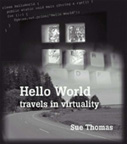
Travels in Virtuality
Hello World, travels in virtuality by Sue Thomas, Raw Nerve Books, ISBN 0953658562: The net is, by definition, a place of different connected realities, and it's also a singularities whole. These singularities are mostly consuming the data on the screen in solitude. This multitude of experiences has emerged as it is, only after the advent of blogs and their immediate writings characteristic. This text has been written as an ante-litteram blog, being an internet travelogue, taking advantage of abstract facts and similitudes, and diluted in a period of three years (from 2000 to 2002). The reflections cross the medium's peculiarities, juxtaposed as pieces of a puzzle with the pioneer's visions, and are expressed through a sociological reconstruction of the processes. The standpoint is not the one immersing into the complicated relationships of real time signs and meanings, but it's the result of take a break and ponder what happens into the screen being firmly behind the desktop. It seems that often Sue diverts the glance from the monitor and starts to reflect, inspired by some flashy emotional or logic connections. Her visions about the global working network and a personal everyday life that are mutually influenced and constitute an intimate perspective of the online/offline relationship. [via neural.it]
Posted by jo at 11:35 AM | Comments (0)
rafael lozano-hemmer
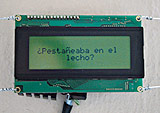
3 Expos
33 QUESTIONS PER MINUTE IN BERLIN: Installation at Postdamer Platz, Berlin, Germany; Presentation: 29 November 15:00 at Postdamer Platz 10; Show: 13 December 2005 to 8 January 2006.
33 QUESTIONS PER MINUTE consists of a computer program which uses grammatical rules to combine words from a dictionary and generate 55 billion unique, fortuitous questions. The automated questions are presented at a rate of 33 per minute --the threshold of legibility-- on 21 tiny LCD screens encrusted on the support columns of the exhibition hall or mounted on a wall. The system will take over 3,000 years to ask all possible questions. A keyboard allows participants to log on to the building and add their own questions to the automatic flow. With the assistance of Will Bauer, Conroy Badger, Ana Parga, María Velarde Torres, Luis Jiménez-Carlés, Luis Parga and Gabriela Raventós. English version with the assistance of Rebecca MacSween.
In the upcoming exhibition, a matrix of 1,800 fluorescent lamps will cover an eleven storey-high building in Berlin, a creation of architects realities:united. On this facade will be displayed 55 billion unique and grammatically correct questions; a new German version of the software "33 Questions per Minute". People will be able to input their own questions by typing them in at an outdoor kiosk.
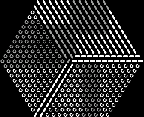
33 Questions per Minute is part of SPOTS LIGHT- AND MEDIA FACADE. For a period of eighteen months, the eleven-storey glazed main facade of Potsdamer Platz 10 in Berlin will host one of the world’s largest media facades. The installation comprises a computer controlled light matrix of 1,800 fluorescent lamps transforming the facade into a communicative membrane displaying works by internationally renowned artists in changing exhibitions. The first exhibition "The City Has Eyes" is being curated by Andreas Broeckmann and will feature art projects by Carsten Nicolai, Rafael Lozano-Hemmer, Jim Campbell and John Dekron in collaboration with realities:united.
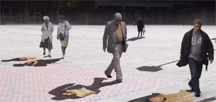
UNDER SCAN: A large-scale public art commission for the East Midlands region in England; 25 November to 4 December 2005: Brayford Campus, Lincoln; niversity; 12 January to 22 January 2006: Humberstone Gate, Leicester; 3 February to 12 February 2006: Market Square, Northampton; 24 February to 5 March 2006: Market Place, Derby; 17 March to 26 March 2006: Canal Side at Castle Wharf, Nottingham--Under Scan is an interactive video installation for public space. In the piece, passers-by are detected by a computer tracking system that activates video-portraits projected within their shadow on the ground. Over one thousand uncensored portraits of local people are activated by the shadows.
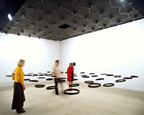
SUBSCULPTURES: Solo exhibition at Galerie Guy Bartschi, Geneva, Switzerland; 5 November 2005 to 14 January 2006--Exhibition featuring kinetic sculptures, video, photography and interactive environments. A catalog is available with texts in English and French. Includes the premiere of "Entanglement", an installation with two neon signs that write emails to each other so that they are both simultaneously on or off. NB: In early December, "Entanglement" will also be shown at Art Basel Miami at OMR Gallery and at the transitio_mx festival in Mexico City.
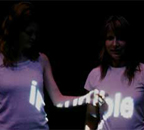
Also: SUBTITLED PUBLIC--Subtitled Public consists of an empty exhibition space where visitors are tracked with a computerized infrared surveillance system. As people enter the installation, texts are projected onto their bodies: these “subtitles” consist of thousands of verbs conjugated in third person and they follow each individual everywhere they go. The only way to get rid of a subtitle is to touch someone else: the words then are exchanged between them. The piece invades the supposed neutrality of the space that museums and galleries set-up for contemplation, underlining the violent and asymmetric character of observation. Subtitled Public also highlights the danger of surveillance systems that typecast and try to detect different ethnic groups or suspicious individuals, as in the latest computer-vision devices that are being deployed in public spaces around the world. Finally, the installation is an ironic commentary on our era of technological personalization, literally branding all spectators and converting them into “thematic individuals”. With the assistance of Conroy Badger, Will Bauer, Ana Parga, Maria Parga, Tara DeSimone and Matthew Marino. Produced by the BBVA-Bancomer Foundation in Mexico City. [video]
Posted by jo at 10:23 AM | Comments (0)
ISEA2006 SYMPOSIUM

CALL FOR PAPERS AND PRESENTATIONS
ISEA2006 seeks paper and presentation proposals responding to the Symposium themes of Transvergence, Interactive City, Community Domain or Pacific Rim. This is the only call for papers and presentations that there will be for ISEA2006.
What tactics, issues and conceptual practices expose or inform the distinctions of these subject terrains relating to contemporary art practice? What theoretical analyses illuminate art practice engaged with new technical and conceptual forms, functions and disciplines; provide for innovative strategies involving urbanity, mobility, community and locality; examine the role of corporations, civic cultural organizations and their relationship to strategic planning; serve to expose new portals of production and experience; and provide for provocative analysis of contemporary political and economic conditions?
The ISEA2006 Symposium is discussion and conversation based. This orientation is intended as a break from the tradition of reading academic papers and the formalities of panels and is the result of a month-long online discussion with 21 international participants (see list below). All sessions are moderated, include respondents and are designed to encourage audience participation. Session formats will emphasize questioning, debate and provocation. Papers, abstracts and poster texts will be pre-published on the web and in print. There will be a pre-symposium online public forum designed to encourage interaction between symposium presenters and the public to provide for discussion and debate.
We are seeking proposals for papers, artist and poster sessions.
SUBMISSION PROCEDURE FOR OPEN CALLS
You must login and create a submission using the official ISEA2006 submission tool.
Open: November 15th, 2005
Closed: January 15th, 2006
Submissions will be evaluated by the ISEA International Program Committee.
On the Submissions Call Page be sure to:
Select "Symposium" from the CALL pull down menu
Select the theme your are responding to from THEME pull down menu
SYMPOSIUM THEMES
INTERACTIVE CITY:
http://isea2006.sjsu.edu/thematic.html#interactive
http://www.urban-atmospheres.net/ISEA2006/
There is an invisible city growing among the growth of the megacity, and it is the electromagnetic, hertzian spectrum that flows ceaselessly with data about and from and between us, but which is always activated by the interfaces of commerce and government-cell phones, surveillance cameras, marketing databases, navigation systems that will alert us to a nearby sale. We imagine the city itself as an interface, which accesses the future, the past, the distant, the present, the communal, the individual in marvelous ways that allow us to enjoy the 'opaque and fictitious thickness' of an invisible city made visible.
PACIFIC RIM:
http://isea2006.sjsu.edu/thematic.html#pacific
http://isea2006.sjsu.edu/prnmscall2/
The political and economic space of the Pacific Rim represents a dynamic context for innovation and creativity framed by issues of economic globalization, isolationist nationalism, regional integrations and environmental change. The concept of a Pacific Rim is that of a complex geo-political-economic framework that necessarily includes a vast network of city-states, regions and their associative relationships that exist beyond the mere geographic location or assignment of populations. Artists, designers, theorists, cultural producers, researchers, urban planners and creative strategist responsive to the rapidly transforming cultural ecology of Pacific-Asia conditions are invited to submit proposals that serve as platforms for discussion and debate.
TRANSVERGENCE:
http://isea2006.sjsu.edu/thematic.html#trans
http://isea2006.sjsu.edu/transvergence/index.html
Transvergence goes beyond the disciplinary. Creative interplay of disciplines to catalyze artistic, scientific, and social innovation is evidenced by decades of multi-/ pluri-, inter-, and trans-disciplinary discourse and practice. The models of the think-tank, media lab and research centre have shown their limits since the 80s and 90s, as have tactical media activism tied to the logic of events, and NGOs facing the donor system's arduous accountability requirements; university
research is often encumbered by best-practice driven managerial culture, and 'creative industries' clusters are subject to economies of scale and uneven divisions of labour. ISEA seeks new visions of organizational and participatory models as structures of possibility for transvergent practice.
COMMUNITY DOMAIN:
http://isea2006.sjsu.edu/thematic.html#community
http://isea2006.sjsu.edu/communitydomain1
The Community Domain theme stands in relation to contemporary debate about 'Public Domain 2.0' (Kluitenberg, 2003), but emphasizes the idea of domain from a grass roots perspective and the idea of community starting with the individual rather than the demographic. In other words, the goal is not to train people to become artists but to use digital and networked technologies to allow people to participate in the creation of their own stories - to become producers rather than only consumers.
SYMPOSIUM STRUCTURES AND CALLS
There are three types of Calls for Participation:
Papers
Posters
Artist Presentations
There will be a limited number of Panel presentations shaped in relation to the Symposium themes. Panels may be proposed or the organizers may curate these based upon Paper, Poster and Artist Presentation proposals.
CALL FOR PAPERS:
Papers submitted will be pre-published on-line with presentations limited to 10 minutes. Paper presenters will be grouped thematically to encourage discourse that presents divergent perspectives and views that serve as a catalyst for conversation.
Submission of proposal abstracts: January 15th, 2006
Notification: February 28th, 2006
Final manuscripts: June 10th 2006
Accepted abstracts will be posted online. Final manuscripts will be pre-published online beginning July 1st. A one month online pre-symposium public discussion forum will feature accepted Papers in one week sessions dedicated to each symposium theme. Authors must commit to having papers available for publication by June 10, 2006.
CALL FOR POSTERS:
Poster Sessions are scheduled throughout the Symposium to provide opportunity for the presentation of individual or group projects or research. Poster Sessions represent a significant opportunity for the presentation of creative, scholarly or community based initiatives. Sessions are moderated. Posters will be on display continuously with scheduled author attendance.
Submission for Posters: January 15th, 2006
Notification of acceptance: March 15th 2006
Posters submissions must be presented in a standardized format. Posters are 4 x 5 ft. and must be in a form that can be attached to presentation boards at the Symposium. A limited number of standard, networked computer stations will be available to complement the posters.
CALL FOR ARTISTS PRESENTATIONS:
Artists Open Mic sessions provide an opportunity for explication of artistic achievement responsive to the Symposium themes. Presentations are limited to 5 minutes and will be grouped together by the organizers as appropriate to subject matter. An assigned moderator will coordinate presentations and audience questions. We recognize, of course, that the Artist Presentations are inadequate to fully present one's work, and we encourage artists to present paper and poster proposals as well as work (see http://isea2006.sjsu.edu/calls.html). We especially encourage artists whose work has been accepted to the Symposium and Festival to submit a presentation proposal.
Artists submissions should include a brief description of the proposed work to be presented along with appropriate documentation.
Submission of proposals for artist presentations: January 15th, 2006 Notification: March 15th, 2006
All Panels and Artist Presentations will be Webcast live and also available as podcasts immediately following presentation.
OTHER CATEGORIES OF PARTICIPATION
There are five additional categories of Symposium presentations that contribute to the overall scope of Symposium proceedings: Keynotes, Emergent Topics, Summit Presentations, Organizational Meetings, Chat Rooms. These are described below. Presenters in these categories will be determined by the IPC. They may be selected from submissions for Papers, Artist Presentations, and Poster Sessions, but please it is not possible to submit directly in these categories:
Keynotes: Keynote presentations are invited featured speakers. Sessions include a respondent/moderator and have extended opportunities for audience interaction.
Emergent Topics: Dedicated sessions on day 3-4 of the Symposium that are a direct response to the discourses, topics and interactions stemming from days 1-2. Speakers and topics will be identified through a ballet system involving all Symposium participants and audiences.
Summit Presentations: There are four pre-symposium Summits focused on special topics: The Pacific Rim New Media Summit hosted by San Jose State University; Interactive City hosted by Intel Berkeley Lab; Creative Communities Forum hosted by the City of San Jose; Artists, Corporation and Policy hosted by Montalvo Arts Center; and Technology Ethics and Environment hosted by Santa Clara University. Each will have a dedicated session for presentation of research, projects and analysis outcomes.
Organizational Meetings: Provision for meeting times and spaces for international cultural organizations, institutes and programs to host meetings specific to their constituency.
Chat Rooms: Chat Rooms are for break out discussions and emergent conversations stemming from Symposium interactions. These are self-organizing sessions based on Symposium interactions and trajectories.
Other Calls: Please note that there are several calls for art projects still open. Also, there will be a separate call for workshops. See http://isea2006.sjsu.edu/calls.html.
SYMPOSIUM DISCUSSION FORUM
Joel Slayton
Steve Dietz
Alex Adriaansens
Peter Anders
Andreas Broeckmann
Danny Butt
Steve Cisler
Nina Czegledy
Sara Diamond
Ken Goldberg
Honor Harger
Doug Kahn
Patrick Lichty
Kim Machan
Amanda McDonald Crowley
Gunalan Nadarajan
Marisa Olson
Christiane Paul
Julianne Pierce
Trebor Scholz
Ana Serano
Rejane Spitz
Carol Stekenas
Mark Tribe
SYMPOSIUM LOCAL HOST COMMITTEE
Joel Slayton
Steve Dietz
Jonathan Berger
Natalie Bookchin
Geoffrey C. Bowker
Danny Butt
Laura Esparza
Peter Lunen Feld
Ken Goldberg
John Kreideler
Margaret Morse
Gunalan Nadarajan
Sally Jane Norman
Marisa Olson
Narendra Pachkhede
Christiane Paul
Eric Paulos
Huan Sauss
Trebor Scholz
Carol Stakenas
Eddo Stern
Mark Tribe
Rob van Kranenburg
Victoria Vesna
Steve Wilson
INTERNATIONAL PROGRAM COMMITTEE
Symposium Committee and members to be added.
Co-Chairs: Steve Dietz and Joel Slayton
IMPORTANT DATES
Submissions Due January 15
Notification of Papers February 28
Notification of Posters + Artist Session March 15
Abstracts April 1
Online Forum April 15 - May 15, 2006
Papers due June 15
Papers published August 1
Summit August 7 - 8
Symposium August 9 - 13
For help or questions: iseahelp[at]cadre.sjsu.edu
Posted by jo at 10:07 AM | Comments (0)
November 21, 2005
Dots And Lines

Online Sound Composition: What's Become of the Score?
The online Dots And Lines exhibition uses the networked space of the web to interrogate the subjects of the score, notation and visual data as core elements in the process of composition.
A great deal of sound art work using new technologies uses programming environments and algorithmic systems to generate compositions. Generative sound approaches have allowed musicians and programmers to develop new interpretations of duration and construction. The evolving processes and surfaces made possible by algorithmic sound softwares form new concepts of both the composer and the score. The primacy of the composer is often obscured in favour of a symbiotic relationship between the musician and the software. In this context, what has become of the score?
-Can a score be said to exist within a software driven music environments?
-Are the visual interfaces examples of a new scoring system?
-Is the code used to programme generative sound software the new score?
Artists/Works:
Laura Baxter & Simon Yuill (UK) - PET_00 (2004)
As with many of the selections in Dots & Lines, PET_00 is a visual music system, which allows users to compose new pieces of music. Users are confronted with a simple set of visual objects which can be moved around in order to stimulate musical compositions...
boredomresearch (UK) -Springtails (2002)
Springtails is a colony of 'electronic insects' that react when touched by a user's cursor. As they catapult around their environment, the insects strike chimes, and in effect, compose an incidental sound piece...
Alessandro Capozzo (Italy) -Ad Libitum (2004)
This project is an online sound environment which uses a series of visual patterns - dots and lines - to represent, or notate, an automated music composition.
Joe Gilmore & Tom Betts (UK) - rand()% (2003)
rand()% is an automated net.radio station streaming generative music created by audio artists, musicians and software programmers. The name is taken from the code of the computer language C++.
rechord (UK) - Cubop (2002)
Cubop is both instrument and composition environment, allowing users to construct music from sounds recorded from rare instruments, including the world's only electric kora, a delicate-sounding African lute.
rigasZieds (Latvia) - daarzs (2002)
Daarzs presents us with a highly original visual notation system. These animated visual and sonic works appear like fusions of science diagrams and artistic doodles.
Stanza (UK) - genomixer RNA (2003)
RNA is part of a larger series of online works, which also include junker , geno , genomixer , and mutator . These works enable online visitors to intermix or breed their own works, using visual and sonic interpretations of DNA sequences.
tinhoko (Austria) - rhapsody (2005)
Part interactive story, part audiovisual tool, Rhapsody is a new work created for Dots & Lines by Austrian artist, Tinhiko. In this work the artist presents us with the concept of non-linear story telling as the score.
U-Sun (UK/Australia) - Segment Yield (2002)
Segment Yield is comprised entirely of microscopic particles which manifest visually and sonically. These particles follow the movement of the user's cursor creating patterns of dotted lines. The simplicity of the visual system belies its metaphoric dimensions.
Posted by jo at 04:05 PM | Comments (0)
Social Networking 3.0

Content as Much as Contacts
"If there were a competition for "Internet Buzzword of the Year," last year's winner would have been "social networking," as a cohort of companies such as Ryze, Tribe, LinkedIn, Friendster, Spoke, and Visible Path, rolled out new or improved services that let Web users create online mirrors of their circle of real-life acquaintances. The idea was mainly to let users build online profiles that advertised their interests and to help them connect with friends and friends-of-friends around one of those interests -- whether it be finding a job, making a sale, or repairing an old motorcycle.
But with the exception of Friendster and Myspace, the initial response to these services among average Internet users was sluggish. Many users signed up for one or more services, created online profiles, formed connections with a few acquaintances, and drifted away, uncertain about how to use the networks." Continue reading Social Networking 3.0 by Wade Roush, Technology Review.
Posted by jo at 03:40 PM | Comments (0)
Data Portraits

Social Maps of Time & Space
a series of aesthetic data visualization sketches as insightful 'portraits' of how people use data about them, through a visual representation of information patterns created during mobile conversations. one of the sketches investigates the spatial distribution & relationships between the places & users. the graphic shows the representation of the cities for each user based on how many times they were called & the total amount of time spent on during the conversations. currently, these graphics are seen as 3D environments that can be implemented as interactive visualizations, enabling users the control of a camera to browse the scene from a desired point of view (i. e. as if traversing a visual narrative). see also ispots wireless network visualization. [mit.edu] [blogged on information aesthetics]
Posted by jo at 02:58 PM | Comments (0)
UN predicts 'internet of things'
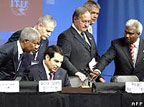
Ubiquitous Network Connectivity
""Changes brought about by the internet will be dwarfed by those prompted by the networking of everyday objects, says a report by a UN body. The study looks at how the use of electronic tags and sensors could create an "internet of things". The report by the International Telecommunications Union was released at the UN net summit in Tunis.
Thousands of delegates are discussing ways of narrowing the technology gap between rich and poor. "It would seem that science fiction is slowly turning into science fact in an 'Internet of Things' based on ubiquitous network connectivity," said the report. "Today, in the 2000s, we are heading into a new era of ubiquity, where the 'users' of the internet will be counted in billions and where humans may become the minority as generators and receivers of traffic."" Continue reading UN predicts 'internet of things' by Elizabeth Biddlecombe, BBC News. [via julianbleecker on eyebeam reblog]
Posted by jo at 02:19 PM | Comments (0)
Beryl Graham
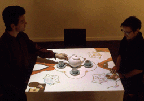
A Study of Audience Relationships with Interactive Computer-Based Visual Artworks
"Thesis Abstract: Contemporary interactive computer-based artworks are examined, with particular reference to the problems and opportunities presented by their relationship to their audience in conventional gallery settings. From an anecdotal starting point, the research uses a series of observational case studies of exhibited works, the production of an interactive artwork, and the curation of an exhibition of interactive artworks, to explore pragmatic questions of the artwork/audience relationship in real-world situations.
A range of existing taxonomies for kinds and levels of interactivity within art are examined, and a 'common-language' taxonomy based on the metaphor of 'conversation' is developed and applied. The case studies reveal patterns of use of interactive artworks including the relation of use-time to gender, aspects of intimidation, and social interaction. In particular, a high frequency of collective use of artworks, even when the artworks are designed to be used by one person, is discovered.
This aspect of collective versus individual use, and interaction between audience members is further explored by several strands of research: The development of an interactive artwork specifically intended to be enhanced by collective usage and interaction between users; the application of a metaphor of 'conversation/host' to the making of the artwork; further, more specific, case studies of such artworks; and the further development of the taxonomy into a graphic form to illustrate differences in artwork-audience, and audience-audience relationships.
The strands of research work together to uncover data which would be of use to artists and curators working with computer-based interactive artworks, and explores and develops tools which may be useful for the analysis of a wide range of artworks and art production." From A Study of Audience Relationships with Interactive Computer-Based Visual Artworks in Gallery Settings, through Observation, Art Practice, and Curation by Beryl Graham. [via julianbleecker on eyebeam reblog]
Posted by jo at 02:13 PM | Comments (0)
Sign of Hex168
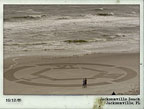
Burning Man, meet E3
"I'm in the Mojave desert this weekend for the gamer festival that marks the launch of the XBox 360. Think: Burning Man meets E3.
While I'm playing GUN at 2 am in the desert with thousands of other gamers, you can watch me on MTV and MTV2 all week on A Gamer's Paradise, which is a special 1/2-hour show all about the Hex168 game that 42 Entertainment produced as a lead-up to the desert festival.
My role on the Hex168 project was to design an experience that would get hard-core videogamers out into the real world doing playful things with their friends. Over 2500 stunts across the U.S. later... well, you'll see: The show premieres tonight on MTV at midnight, again at 6:30 on Monday, and repeats 1o more times across the two networks throughout the week." [posted by Jane on Avant Game]
Posted by jo at 02:00 PM | Comments (0)
fibreculture #6
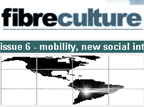
Mobility, New Social Intensities, and the Coordinates of Digital Networks
From stirrups to satellites, the invention of new forms of technical mobility has always created new intensities within the social. Each invention has also required a new idea of what it might be to be human, along with new tensions as older cultural practices and social forms are challenged. The contemporary mobility of digital networks is no exception. This issue of the Fibreculture Journal--edited by Andrew Murphie, Larissa Hjorth, Gillian Fuller and Sandra Buckley--is concerned with documenting, and beginning to think through, the new mobile intensities allowed by digital networks. "Intensity" here refers not just to the ubiquitous nature of mobile networks, or to the frequency of use of mobile communications. New intensities are like new forces erupting within the old - taking the social somewhere it has not perhaps been before. At the least, these intensities give established orders new energies to either resist or attempt to fold into established social practices and modes of thinking.
All of the articles in this issue deal with these new intensities. Much of this issue develops key ideas and documents new social practices involving mobile telephony. Dong-Hoo Lee documents the experiments with self-image and expression now allowed young Korean women by camera phones. Angel Lin affirms the continuation of older social practices amongst Hong Kong college students using SMS (in the use of SMS to maintain social ties with friends and family, for example). However, she also notes the increased possibility of political participation, and some interesting shifts concerning biligual textual practices - perhaps even a specific emerging bilingual identity within the community of SMS users. Lin also finds that there are gender differences concerning the way that young people in Hong Kong use mobiles (males tend to use SMS to meet females and new friends, for example). Lin wonders if, however, this will lead males into more 'social grooming' via mobile communications. This seems to be the case in the study of Norwegian young people, provided by Lin Prøitz. She finds a surprising amount of gender mobility within the frame of SMSing, even when the rhetoric outside of this frame maintains reasonably strict concepts of gendered behaviours. Lee, Lin and Prøitz all outline the role of desire in promoting proficiency and subtleties within SMS use.
Judith Nicholson gives an extensive account of the brief but influential 'flash mob' phenomenon, at the same time describing the political potential of mobile networks in terms of new "mobs". Here Nicholson draws attention to the use of mobile phones to coordinate the political momentum in the Spanish election of 2004, echoing 1981's 'night of the transistors'. Larissa Hjorth argues for the enfolding of older forms of communication within SMS and MMS use. Specifically she contemplates the shifting fragile intensities of the border between public and private in both SMS/MMS and the postcard. If there are new intensities of intimacy to be found in mobile networks, they are often mutations of older intensities.
Several articles move beyond mobile telephony, to discuss broader issues regarding networked mobility. Scott Sharpe, Maria Hynes and Robert Fagan consider the Internet as a forum for coordinating resistance to globalisation. As they point out, the Internet is already compromised as such a forum, as it is itself the forum of globalisation par excellence. They suggest rethinking what is possible in such a context. They give a detailed analysis of an older-style approach, that of the IUF 'superunion' educational web site, and a newer approach, that of activists, the Yes Men. In a surprising challenge to much analysis of globalisation and its discontents, Sharpe, Hynes and Fagan turn to Gilles Deleuze's analysis of masochism to point out the limits of the IUF approach. Rather than buy into the hegemony of representations as outlines by global powers (and some of their opponents), they argue for a humorous creation of new possibilities via the Internet. The latter involves an active seeking after new, more creative modes of thought, via which to nudge the new network intensities away from the monolithic nature of global Capital.
Nearly all of the articles in this issue are as contemplative and they are descriptive. The final three articles are centrally concerned with a thinking through of mobile intensities. Ingrid Richardson poses the concept of the 'mobile technosoma' - a return to thinking through the new kinds of bodily intensity associated with new technical intensities, and both bodily and technical intensities together. In the process she argues for a new medium specificity. Far from a convergence of media, Richardson comments that new mobile media forms, and their specific embodied contexts, require more in the way of specific analyses of their divergences.
Notions of stability, identity and place keep recurring in the discussion of convergent mobile media. Mobility, in particular the tactility and telepresence of mobile telephony, brings about an intense focus on the specificity of place and bodies. 'Where are you, now?' seems to be a refrain for many authors in this issue. The expansive yet normalising architecture of networks produces paradoxically an ethography of innovation and intimacy as shown in the four qualitative case studies from Seoul (Lee), Hong Kong (Lin), Melbourne (Hjorth) and Norway (Prøitz). In a delicately argued article grappling with this new sense of place, Rowan Wilken discusses a sense of place profoundly transformed by mobile networks, but not completely dissolved into them. Wilken points out that we simply cannot do without place, that place has always been a complex experience, and that, although there is no doubt that mobile networks transform place, this only makes it the more urgent to consider a new concept of mobile place - what he calls 'mobilitis loci'.This new place - a shifting place, a more intense and uncertain place, requires a new and more subtle politics - a central theme in many articles in this issue. This new politics of place is one that will have to consider the mutually infolding of virtual and actual at every moment of mobility. Wilken turns to some architectural/media experiments emerging from the events of the 1960s, such as those of the group Ant Farm, in order to give such infolding some historical context.
Felicity Colman and Christian McCrea take all these questions - very old and very new technics, new intensities and new fragmentation, new relations, the infinite deferral of networks and the way this deferral ties everything into a web - in the direction of what they call the 'digital maypole'. For Colman and McCrea, 'the maypole expresses the network’s torsion balance chart of power. The maypole topology is order through rhythmic tension and torsion, and in this sense its continuous binding of power makes the concept the paradoxical apostate of the network’s labyrinthine structure. The instinctual and biological ties of the etymological maypole enable us to focus upon specific power combinations of the network’s prescience'. There could perhaps be no better description of the problems and possibilities given to us by new mobile intensities, whether for those who are trying to mediate the shifts in social practices and cultural cohensions occasioned by mobility, or those attempting merely to analyse them.
We hope that it will be noted that there is a mix of approaches in this issue. In particular, the articles here range from the purely speculative to the mainly empirical. We are very happy that things have turned out this way. We began with a commitment to sparking conversation between different modes of analysis and response to these important issues. Such diverse studies exemplify the kinds of methodological constellations gathering around mobile phone use - and perhaps as importantly, examine the new relations between new, more mobile social intensities (such as biligualism in Hong Kong, gender fluidity in Norway) and mobile technologies as engaged with these intensities.
Biographies.
Posted by jo at 10:26 AM | Comments (0)
November 18, 2005
MuscleBody
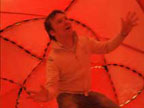
Translucent Skins
The MuscleBody is a full-scale prototype of an interior space. Its continuous skin incorporates all its architectural properties and makes no categorical distinctions such as floor, wall, ceiling, door. The interaction between the MuscleBody and its players (the people that have entered the interior space) causes the MuscleBody to change its shape, its degrees of transparency and the sound that it generates.
The structure of the MuscleBody is based on a spiralling tube that is bent in 3D. 26 industrial Festo muscles control the movement of the MuscleBody. The skin is made of Lycra, and its translucency depends on the degree of stretching. Speakers integrated into the skin generate sound samples that are combined and transformed according to the behaviour of the players.
The game starts when from the moment the visitor enters the MuscleBody. Information is abstracted from the behaviour of the players in real-time by pressure and proximity censors that are imbedded in the skin. The game-software VirTools organizes the relations between the input received by the sensors and the output consisting of the behaviour of the muscles and the generated sound. [blogged by Regine on we-make-money-not]
Posted by jo at 06:32 PM | Comments (0)
1:1 Track
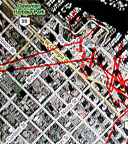
a locative media project
1:1 Track, by Anna Scott & Brenda Cleniuk, is a performative research project in locative media. The project is process-based and open to audience interaction and will be realized in two parts; the second of which will take place in the spring of 2006. The work takes as its starting point, the geospatial architecture of the Hotel Vancouver as tracked by the global positioning system (GPS) in an attempt to uncover meaningful coincidences in the relationship between technology and the supernatural. The artists invite interested persons to join them in a demonstration of their protoscientific methodologies in obtaining data. Embarking on a walk through Greater Vancouver, the artists respond to spikes in the GPS readings allowing haptic or random visual clues to navigate and determine their movements throughout the City. Peripatetic walks will commence Friday November 18 at 11:00 am and Saturday November 19, at 11:00 am and 3:00 pm starting outside the main entrance of the Hotel Vancouver on Georgia Street.
Walks are from 1 - 2 hours in length and may involve short boat trips or excursions to public parks and other landscapes. Special Media Consultant: Jen Hamilton.
Posted by jo at 06:11 PM | Comments (0)
a Pro Helvetia and Xcult project
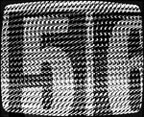
bastard channel
bastard channel is a cross between a television and a web project, a platform in the Internet that tells the story of itself as a television channel. The channel works with the lowtech and financial means of network art and has collaborators on three continents. Its programme can be received all over the world.
On 18 November 2004, bastard channel has been celebrating its start with six programmes within the framework of the Viper Media Festival in the Basel Kunsthalle. By the winter of 2005, seven new programmes will have been added. The participants are artists from Bangalore, Basel, Berlin, Geneva, Los Angeles, Mexico, Paris, Seoul, Tokyo and Zurich, as well as collaborating text writers, translators, programmers and graphic artists.
It will not be possible to receive all the bastard channel programmes at all times, for our online project operates according to the television programme structure. Trailers will provide information about the times of day and night when you will be able to receive the next programmes in your part of the world. Whereas the terrestrial television stations are working on making it possible for programmes to be broadcast online independently of times and dates, bastard channel is set on limiting consumption: we do not want our programme to be available all the time, and we take the opportunity of wagging a cautionary medial forefinger at the "zap & surf attitude".
bastard channel is intended to reflect the web as a time medium. This is a cross between the babbling TV promises and the hesitant web response of a 56k modem. Some of our programmes are run like films, animating the screen at a breakneck pace, others step intentionally on the brake, tempting and frustrating at one and the same time. Still others bring streams of data onto the screen or make interaction offers where the public can spend 30 minutes or 30 seconds. At bastard channel, even the TV test pictures are interactive, and viewers receive personal answers to existential problems from the Television Sphinx - without, however, knowing whether they will receive a written or spoken answer from the Sphinx herself or her intelligent robot within two to three days.
56kTV - bastard channel has its own programme magazine. International authors from the worlds of the film, art and the media sciences comment on the TV project and the individual programmes, thus enriching the audio-visual online offer by a print & read version. We are investing in a good visual concept and leaving the print-on-demand to our public, since the TV magazines can be printed on every home printer.
Posted by jo at 06:01 PM | Comments (0)
I tag ----> I own
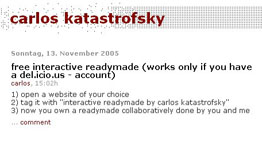
interactive readymade for free
It all began a couple of weeks ago with the post "on blogging as curating". Quickly the discussion about it turned into "tagging as curating". Katastrofsky took it one step further, proposing in his personal blog (in accordance to what he had explored in his "the original" project) tagging as owning.
The idea is simple, and it would make Duchamp proud of this new pupil of his. In a set of three simple rules the artist asks us to choose one site whatsoever (the more you like it, the better), then to tag it as an "interactive readymade by Carlos Katastrofsky" and it's done. You become the owner of an online readymade done by you and Katastrofsky himself.
The simple act of signing, so characteristic of readymade works of art (and from a conceptual point of view, the work itself) is replaced by a tag defined by the artist, the creator of this "performative" piece. The interesting thing here is that it is not the artist who signs (tags) the existing object. The artist only allows us to do it for him, and by doing so he completely looses control of what becomes one of his works of art. In the end it doesn't matter if noone else recognises what you just did as a readymade done by both of you, but then again they might.
Using del.icio.us, and defining a priori the readymade-iser tag, Katastrofsky allows for a community, or a net of readymades of his authorship to exist. Tagging something as a Katastrofsky's collaborative readymade opens the door to the club. You get to know what are his readymades, how many of them there are and who owns them (and most important of all, if yours is better than the rest).
By recurring to del.icio.us or the Flock browser he is creating a "one tag" network centred around the ideas of tagging as signing (he allows others to tag in his name) and tagging as owning (what you tag in his name becomes your own katastrofsky piece). If in "the original" it wasn't possible to choose what you could own, the decision belonging solely to the artist, now it depends on you entirely. Now everyone can have whatever "interactive readymade by carlos katastrofsky" they desire.
free interactive readymade
2005
Carlos Katastrofsky
http://blog.subnet.at/carlos/stories/1814/
Posted by luis at 07:20 AM | Comments (0)
November 17, 2005
Cell Phone Culture Forum

TONIGHT @ MIT
Thursday, November 17, 2005, 5:00 - 7:00 p.m., Bartos Theater, MIT, Cambridge, Massachusetts.
Cell Phone Culure: Abstract--No contemporary cultural artifact embodies the genius and the disruptive excess of capitalism as clearly as the cell phone. Ubiquitous in most developed societies in Europe, the Americas and Asia, the cell phone has become a laboratory – some would say an asylum – for testing the limits of technological convergence. Less a telephone today than a multi-purpose computer, cell phones are game consoles, still cameras, email systems, text messengers, carriers of entertainment and business data, nodes of commerce. Particular age cohorts and subcultures have begun to appropriate cell phones for idiosyncratic uses that help to define their niche or social identity. Today’s Forum will examine the cell phone as a technological object and as a cultural form whose uses and meaning are increasingly various, an artifact uniquely of our time that is enacting, to borrow the words of a contemporary novelist, “a ceaseless spectacle of transition.”
Speakers
James Katz is professor of communication and director of Rutgers University's Center for Mobile Communications Studies, which he founded in 2004. Katz' research focuses on how personal communication technologies, such as mobile phones and the Internet, affect social relationships and how cultural values influence usage patterns of these technologies. His books include Machines That Become Us: The Social Context of Personal Communication Technology (Transaction, 2003, editor) and Perpetual Contact: Mobile Communication, Private Talk and Public Performance (Cambridge, 2002, co-edited with Mark Aakhus). He is also the author of Social Consequences of Internet Use: Access, Involvement and Expression (MIT Press, 2002, with Ron Rice).
Jing Wang is professor of Chinese cultural studies, and the head of Foreign Languages & Literatures at MIT. Her research interests are focused on contemporary Chinese popular culture and its relationship to marketing and advertising. She worked at Ogilvy in Beijing for two summers as a consultant for the Planning Department, and is currently finishing up a book manuscript [Brand New China: Advertising, Media, and Commercial Culture]. Wang's presentation on cell phone branding and youth culture in China is based on some of her work at Ogilvy. [blogged by Martin on Mobile Audience]
Posted by jo at 03:03 PM | Comments (0)
Take Heart and flickr colr pickr
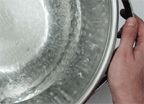
Two Visualization Tools
In Take Heart--by Monika Hoinkis--a bowl is filled with water. By taking hold of it by the handles, it becomes literally moved by the rhythm of your heart. Water becomes storage for discrete information and makes it visible. It starts pulsating with your heartbeat. When you touch the object with only one hand, the water stays calm. When holding both handles, the water starts vibrating. Your heartbeat is calculated through the handles' measurement of your skin-resistance and then assigned to the water's pulsation. The heartbeat is now stored and the water will 'beat' with this rhythm until the pulsation slowly abates. At the end the water is calm and discharged again, unless the bowl is touched by a new person to whom whose heartbeat it would set itself to. It then beats with another's heart. [via infosthetics]
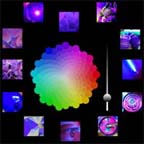
an online application showing a circular color chart out of which users can pick a descriptive color category, plus a specific color & brightness. the application then shows an according collection of Flickr color-matched images. see also tagged colors & flickrland visualization for similar conceptual approaches. [krazydad.com] [blogged on infosthetics]
KrazyDad is Jim Bumgardner. He's a programmer/hobbyist with a passion for making cool graphics software, and software toys. All the software presented on his site was written by him, at home, on nights and weekends. Ditto for the website itself. Jim works programming software for the Interactive TV industry. He is also a part time instructor on various subjects, including interactive art, multimedia, various programming languages, chess for kids, lego robotics.
Posted by jo at 01:03 PM | Comments (0)
Nick Montfort
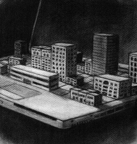
Opening Book and Volume
I’m pleased to announce the release of Nick Montfort’s new interactive fiction: Book and Volume. It’s been more than five years since Nick burst on the IF scene with the release of Winchester’s Nightmare (1999) and Ad Verbum (2000). His new piece, which I’ve had the privilege of playing in pre-release versions, is an addition to the field that will appeal to veterans and newcomers alike.
As a sysadmin in Book and Volume’s nTopia, it’s easy to know what to do. Your computer, your pager, and your boss are constantly telling you. And you must spend your Sunday night running around rebooting servers whether you like it or not (there’s a big demo coming up!) or get fired. But there’s more to B&V than what the voice from your pager commands. In fact, part of what this story and game explores, over time, is the potential for performing actions beyond those made available most obviously.
This is Nick’s first full-length IF since the publication of his scholarly book on IF, Twisty Little Passages. Given this, I’m sure I won’t be alone in finding myself thinking about B&V in terms of that book’s most influential formulation: seeing the structures of interactive fiction as analogous to those of the long tradition of the literary riddle. And, in fact, this angle reveals a particularly elegant view of B&V’s design. For while satisfying its early demands is much like puzzling through a riddle that is asked outright, delving more deeply into the work could be seen almost as a process of finding a formulation for a riddle implicit in the work’s shape but never directly posed to the reader. And, having not yet succeeded in finishing Book and Volume myself, I can say that it’s a non-trivial process that doesn’t quickly lose its intrigue. [blogged by noah on grand text auto]
Posted by jo at 12:49 PM | Comments (0)
WJ-s Web Performances Tonight
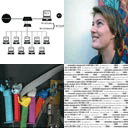
Agnès de Cayeux, Anne Laforet & KRN
Centre Pompidou, Paris, Les Plasticiens du Web, Thursday, November 17th 2005; Salle de cinema 2 / 7pm / 3 euros / Metro Rambuteau.
WJ-s is a software and a flexible, high speed connexion public device for web performances which allows actors of the Internet--sound and image artists, netartists, bloggers, graphic designers, flashers, programmers, curators, hacktivists, newmedia theorists, pioneers and web mutants--to play live with the full scope of contents available in the wideness of the Web.
Agnès de Cayeux, Anne Laforet & KRN endlessly explore and experiment with the changing and fluctuating territories of the Internet. They subjectively articulate its intimate contours and zones. With "WJs", the artists play with the erotic and heated atmosphere of video chat rooms, with the world of artistic algorithms and computer art, and with an exacting choice of plastic, sensitive, aesthetic and narrative works in the realm of webart.
Agnès de Cayeux, network artist, conception and programming of network interfaces and tools. Research on distance relations and network interactions.
Anne Laforet is a specialist of net art, particularly on preservation, researcher, co-organizer of conferences and public discussions, soundartist.
KRN, network artist, curator, moderator, artistic and cultural event organiser, researcher into the relations between interactivity and desire, art and technology. Technical expertise: development of web sites and interfaces.
WJ-s/ystem : the whole technical device
WJ-s/oftware : the software part of WJ-s/ystem
WJ-s/erver : the device server
WJ-s/tudio : the computer used as a webdeck to control the WJ-s/tations
WJ-s/pring : a network of laptops that controls the WJ-s/tations during the performance
WJ-s/tation : one of the WJ-s/pring laptops (polymedia capture and diffusion)
WJ-s/pace : the venue in which the device is hosted
WJ-s/et : a WJ-s performance
WJ-s/ession : a series of WJ-s/ets
WJs project author, production: Anne Roquigny
Software programming: Stephane Kyles
Technics: Olivier Bernon
Realisation: Marc Bellini
Thanks: Christophe Becker, Thierry Bernard, Nadine Bonnefoi, Ferdinand Corte, Stephane Degoutin, Emilie Fouilloux, Anne Gagnebien, iddem.com, Emmanuel Jamin, Christophe Leclerqc, Sandrine Maricot, Denis Santelli, Sigolene Valax. Partner: ars longa
CONTACT / INFOS anne roquigny ar (at) wj-s.org
Posted by jo at 11:43 AM | Comments (0)
Urban Eyes at V2_
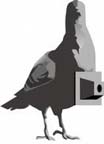
Pigeons as Chaotic Agents and Messengers
On Thursday 24 November, Marcus Kirsch and Jussi Ängeslevä will present their award winning cross-media project Urban Eyes at V2_. Urban Eyes wants to provide an alternative view on the city by using pigeons as the messengers of camera and other imagery overlooking the main streets and back alleys.
Location: V2_, Eendrachtsstraat 10, Rotterdam (tram 4 or 5 / metro Calandlijn, Eendrachtsplein station); Date: Thursday 24 November 2005, 19:30 hrs; Entrance: free; Participants: Marcus Kirsch (UK) and Jussi Ängeslevä (D). Urban Eyes is made possible with support of: Datamars S.A., Sokymat, Motz-Computer, Arts Council England and V2_Lab.
The urban rock dove (columba livia) is part of every cityscape. More hated than loved due to malnourishment based on fast food left-overs, the "flying rat" is very likely here to stay in our urban scenario. The urban pigeon population can be seen as an indicator of the city's atmosphere. Bottomline is, just as every other behaviour pattern and network in the city, we are connected to it as we share the same space.
In a mixture of revived shamanism and panoptic view that might challenge the artificial network of CCTV cameras, the pigeon population's unpredictable movement patterns offer a set of eyes that could offer a unique view onto unknown places. Based on the Bavarian Pigeon Corps from 1903, where homing pigeons were equipped with tiny cameras to take aerial shots from behind enemy lines, Urban Eyes uses RFID and wireless technology to turn the once able urban pigeon into a chaotic agent and messenger of visual impressions from the road you never took.
Perceived as a critical design concept and public art installation, Urban Eyes accesses the live network of pigeons to expand what you know about your own city and reclaim the exploring stage of citylife. In 2004 the project proposal of Urban Eyes won 3rd price at Fusedspace, an international competition for innovative applications for new technology in the public domain. [related post]
Posted by jo at 10:39 AM | Comments (0)
The Elizabeths + Post-traumatic Institute for Social Satisfaction
![]()
Participatory Performance
November 18 | 7 PM The Elizabeths: ELIZABETH SPEAKS--The Elizabeths are proud to present the pemiere performance of Elizabeth Speaks. In a provocative and revolutionary act of oration, translation and interpretation, the Elizabeths will present political speeches both past and present. In an engaging, audience participatory forum, the Elizabeths' new performance will underscore the correlations between historical political rhetoric and the governmental agendas that are often camouflaged with doublespeak. Amplifying the need for continued free speech, public debate, and individual contributions, the Elizabeths will also give voice to any audience member who wishes to participate in this public address. Let the Elizabeths be your megaphone! The Elizabeths consist of: Kristin Elizabeth Calabrese, Elizabeth Tremante, and Micol Elisabeth Hebron.
![]()
Post-traumatic Institute for Social Satisfaction: COOKIES--Renown for its motivational seminars in Psychic Disobedience™, Evangelical Onanism™ and Ontological Diuretics™ as well as it's expertly-choreographed public demonstrations, the Post-traumatic Institute for Social Satisfaction is widely considered a leading force for research into the neoliberal sublime and its accompanying networks of Religio-Corporate-Renal Control. The Institute can fairly claim prescience and influence in the global renal arena, and a proven track record in disseminating Urologic™ to both influential and popular audiences. Representatives will be on hand to provide an intensive introduction to the Institute, its operatives, its aspirations and the arsenal of techniques it aims to employ in the ongoing struggle for Social Satisfaction. P.I.S.S. consists of Natalie Zimmerman, Michael Wilson, Jennifer Nelson, Melissa Longenecker, M.T. Karthik and others anonymous.
The Elizabeths, Post-traumatic Institute for Social Satisfaction are part of the Voiceovers program at Los Angeles Contemporary Exhibitions (LACE). Voiceovers is a series of performances, readings and screenings exploring the voice as a physical utterance and carrier of meaning rather than a tool of language to be learned and controlled.
Posted by jo at 09:55 AM | Comments (0)
November 16, 2005
Robot Clothes:

Automated Biography
At Eyebeam, Nov. 19: 12-2pm - Exhibition and presentation of work by Robot Clothes and panel participants; 2-3:30pm - Public critique/ design review of work; 4-6pm - Panel hosted by Robot Clothes. Panelists: David Hanson, David Kindlon, Harvey Pekar, Sal Resitov, Hosted by Robot Clothes.
During their residency at Eyebeam the artists collaborative Robot Clothes, comprised of James Powderly and Michelle Kempner, developed Inside Out Life Story, an artwork that combines robotics, art music, theatrical sets, animated toys and artificial intelligence to tell their personal story about a sick person and their partner, life in the hospital and the process of shifting back and forth between two disparate worlds. Elements of the robotics and sets will be on view and an ancillary panel – Automated Biography - bringing together the DIY super stars from all walks of life will take place Nov. 19, 12-6m. The panel is open to the public with a suggested donation of $5.
The concepts and tools of AI, human-computer interaction and situationally-aware machines continue to move further from the realm of science-fiction and into the hands of artists, musicians, writers, scientists and DIY enthusiasts. As this happens robots and new media are being used to redefine artistic mediums and create highly-personal expressions. Automated Biography is a creative technology symposium exploring the role of technology in the creation of autobiographical and biographical artworks. This panel and group discussion will introduce several examples of alternative uses of technology and media to explore illness, identity, politics and life in the margins of culture.
Biographies of participants:
Robot Clothes is an art and commercial research and development partnership, specializing in robotic systems, interaction design and product prototyping. This partnership, formed in 2002 by Michelle Kempner and James Powderly, utilizes a hybrid fine art and commercial design and engineering approach to support innovative science and technology development efforts for clients including fortune 100 companies, NASA and internationally renowned artists, such as Diller + Scofidio and Miranda July. In addition to contracted research and development efforts, Robot Clothes internally supports fine art projects ranging from a robotic public sculpture for Central Park to an animatronic story about Crohn’s Disease.
Since graduating from RISD, David Hanson has worked as a designer, sculptor, and robotics developer in the entertainment industry for clients including Walt Disney Imagineering, Universal Studios , and MTV. His robotics have won numerous awards and his technical papers have been published internationally. To see high resolution images of Hanson’s robots, please turn to Human-Robot.org.
Starting his career as a mechanical designer of puppets, David Kindlon has since moved onto animatronics. Working in the film industry Kindlon has worked on such major features as Predator, A.I, I, Robot, Godzilla and Day of the Dead. For the last two years he has been working with artist Paul McCarthy, building robust robotic mechanisms to animate McCarthy’s work. His diverse robotic skill set includes remote control animatronics to toy prototypes and industrial design.
Cleveland, Ohio native Harvey Pekar is best known for his autobiographical slice-of-life comic book series "American Splendor", a first-person account of Pekar’s downtrodden life. The series has been published on an approximately annual basis since 1976. Pekar self-published the series until the early 1990s, when Dark Horse took over publication. In 1987, Pekar was honored with the American Book Award for the series. Dark Horse celebrated the 25th anniversary of "American Splendor" in 2001 with a special issue. In addition Pekar has worked as a book and music critic and well as radio commentator.
Dr. Sal Restivo is Professor of Sociology and Science Studies in the Department of Science and Technology Studies at Rensselaer Polytechnic Institute in Troy, New York. Trained and educated in sociology, anthropology, social psychology, and _history, he is a "social theorist" and specializes in social studies of science, _mathematics, and mind. For the most part, his research has focused on problems _in the sociology of mathematics. He has done sociological studies of the history _of mathematics in various cultures, anthropological studies of laboratories, _science policy analysis, and research on science and engineering education. He _is currently constructing a sociological theory of mind and thinking. He has won numerous awards and fellowships for his research.
For more information on Robot Clothes, Inside Out Life Story or to view their lab blog or work on their DIY Humanoid Robot Kit, please visit: http://www.robotclothes.com/projects_insideout2.html
Posted by jo at 12:58 PM | Comments (0)
blubox + fotobox
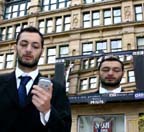
networked public art
"my current research title explores public art as a playful mediated urban environment. to clarify my terminology, I use >playful< to refer to a game-based situation. playing is fun, interactivity can be playful, playfulness mostly experienced by two or more people. i was cautious not to use the word >game-based< or as to describe my art practise as game design. i am however interested in addressing the notion of >game-play<, a term which was mainly used within the context of gaming during the development of video game design in the early 1980’s.
whereas the term >mediated< is not only referring to a space that has been modified such as by the installation of a variety of media tools but also in establishing a mode of >social interaction< that can be generated by such tools. referring to >public art< in the title is aiming to drive forward the debate of >new genre public art<. this development comes out of the more traditional practise of public art, concerning itself not only with the site-specificity of a public place but addresses the significance of audience in the development of the artwork. the emphasis is to widen and define a more >inclusive< mode of public art practice.
my >blubox< artwork is piloting an example of the above mentioned terms and practises and sits amongst 4 other case studies of artists using mobile and wireless media devices. >blubox< which is a systems-based art project, enables the public to network together via bluetooth to play with various designed mobile applications in a coordinated city environment. i am now inclined to change my research title to outline exactly what my art practise is researching: public art as a wireless network." [blogged by Maria N. Stukoff on mobilebox]
Via Locative:
"blubox is a unique bluetooth software and hardware application designed and developed by Maria N. Stukoff and Jon Wetherall for the creative use of mobile phones via bluetooth. as part of this development we are invited to trail the first phase of blubox technology - called fotobox an interactive installation with a public LED screen display - at the 3rd Salford Film Festival in
salford/manchester tonight...
...the next phase of blubox will platform a 3D game environment controlled and played via bluetooth technology. we aim to release the framework for this mobile phone game by march 2006..."
Posted by jo at 08:15 AM | Comments (0)
November 15, 2005
ULTRASOUND Workshop/Creative Labs
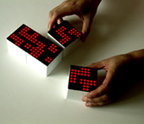
TileToy
ULTRASOUND Workshop/Creative Labs: TileToy--A Modular Electronic Game Prototype by Tuomo Tammenpää & Daniel Blackburn, Finland/UK. Dates: Mon 21 - Thur 24 November 2005. Venue: University of Huddersfield, Technology Building, Queensgate Campus, Huddersfield, HD1 3DH. Fee: £20
TileToy is a modular, electronic game prototype which brings the flexibility inherent in software to a physical tile that people can touch and interact with. By arranging multiple tiles, players engage in various kinds of game play, from fast paced arcade style games to puzzle or learning games. TileToy employs changing-state strategies, animation and play; individual tiles affect the state of adjoining tiles.
The re-programmable and constantly updated graphical information is displayed on an LED dot matrix system. The screen is an endlessly versatile surface for displaying visual data. Tiles are controlled individually and can be used to transmit information singly or in groups. The assembled tiles wirelessly transmit their individual position in relation to each other and, based on that changing information, a central computer, or a dedicated tile runs the different applications.
The source code and the hardware will be made available via open licenses. The aim of TileToy is to create a platform that anyone can use to create unique content. Making the software open will allow people to create their own
applications and games and feed these back into the community to spark further innovation. The open hardware schematics will allow people to
make their own TileToys cheaply without paying a third party.
The initial PicBasic code used to control the tiles will be released under the GPL or LGPL [see http://www.opensource.org for more details]. The first open hardware version will inlcude a list of components, initial circuit design schematics and instructions for building the tiles. Details of the release will be posted on the TileToy Blog by the end of November 2005.
Tuomo Tammenpää is an active media artist and designer. During the last ten years he has participated in several exhibitions in Scandinavia, Central Europe, Asia and North America presenting video and media installations.
Daniel Blackburn has ten years experience working in the games industry. He is a creative technologist and has worked on a number of new and innovative computer games.
TileToy is supported by the Digital Research Unit, Huddersfield.
www.tiletoy.blogspot.com
www.needweb.org
www.carbonbasedgames.com
Workshop Schedule
+ Visitors are asked to first report to
+ University Reception, Harold Wilson Building,
+ Queensgate.
DAY ONE: Registration and Introduction
Monday 21st November
14:15 - 17:00
DAY TWO: Construction
Tuesday 22nd November
09:15 - 18:00
DAY THREE: Testing and Software
Wednesday 23rd November
09:15 - 18:00
DAY FOUR: Game Development
Thursday 24th November
09:15 - 14:15
Directions
Car Parking: Limited car parking at the University's Wakefield Road car park on the Queensgate Campus is available to registered participants on request.
Directions: http://www.hud.ac.uk/uni/maps.html
For further information or to book please contact Clare Danek
Email: info[at]ultrasound.ws
Tel: +44 [0] 870 990 5007
Posted by jo at 09:30 AM | Comments (0)
Aspect - the Chronicle of New Media Volume VI:
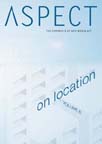
On Location
Aspect - the Chronicle of New Media Volume VI: On Location--Synopsis: Without a fixed physical or temporal locus, Aspect Magazine maximizes the fluidity of its ephemeral site in Volume 6: On Location. Extending from the momentary to the monumental, terrestrial to celestial, micro to macro, and personal to cultural, this issue explores the vast concept of location. Where beyond the genre of new media art could so many different interpretations of location exist? Included in this issue:
KENSETH ARMSTEAD: in_authentic_b (an invisible cities excerpt) with audio commentary by Andrew Perchuk * C5: The C5 Landscape Initiative with audio commentary by Christiane Paul * RICHARD CLAR: COLLISION II with audio commentary by Jean-Luc Soret * SHELLEY ESHKAR AND PAUL KAISER: Pedestrian with audio commentary by George Fifield * PETE GOMES: Stedelijk Drawing with audio commentary by Jelle Bouwhuis * MTAA (M.RIVER & T.WHID ART ASSOCIATES): 1 Year Performance Video (aka samHsiehUpdate) with audio commentary by Marisa Olson * DOUGLAS WEATHERSBY: GSG Office Project with audio commentary by James Hull.
Catalog No. MC-490
2005, 110 minutes
DVD, Region: 0 (All Regions)
TV System: NTSC
ISBN: 0-9749657-3-1
UPC: 837101115414
SRP: $25.00 (includes PPR)
Street Date: December 6, 2005
Prebook Date: November 14, 2005
To order/more details:
http://www.microcinema.com/programResult.php?program_id=490
orders[at]microcinema.com
or fax: 509-351-1530 phone: 415-864-0660
or send PO to:
Microcinema International
1706 Church Street, #1222
San Francisco, CA 94131, USA
Posted by jo at 09:18 AM | Comments (0)
StartleCam

Affective Wearables
"Abstract: StartleCam is a wearable video camera, computer, and sensing system, which enables the camera to be controlled via both conscious and preconscious events involving the wearer. Traditionally, a wearer consciously hits record on the video camera, or runs a computer script to trigger the camera according to some pre-specified frequency. The system described here offers an additional option: images are saved by the system when it detects certain events of supposed interest to the wearer. The implementation described here aims to capture events that are likely to get the user's attention and to be remembered.
Attention and memory are highly correlated with what psychologists call arousal level, and the latter is often signaled by skin conductivity changes; consequently, StartleCam monitors the wearer's skin conductivity. StartleCam looks for patterns indicative of a ``startle response'' in the skin conductivity signal. When this response is detected, a buffer of digital images, recently captured by the wearer's digital camera, is downloaded and optionally transmitted wirelessly to a webserver. This selective storage of digital images creates a ``flashbulb'' memory archive for the wearable which aims to mimic the wearer's own selective memory response. Using a startle detection filter, the StartleCam system has been demonstrated to work on several wearers in both indoor and outdoor ambulatory environments." From StartleCam: A Cybernetic Wearable Camera by Jennifer Healey and Rosalind Picard.
Posted by jo at 09:05 AM | Comments (0)
Cultural Futures:
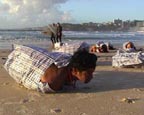
Place, Ground and Practice in Asia Pacific New Media Arts
Cultural Futures: Place, Ground and Practice in Asia Pacific New Media Arts runs in Auckland from December 1-5 - the first significant event of its kind taking place in Aotearoa/New Zealand. The ground-breaking symposium aims to develop international awareness of locally produced work and link off-shore practices to conversations around New Zealand's shifting cultural and creative identities.
"New media" artists explore the new opportunities for artistic and cultural expression in the wake of the personal computer, mobile devices and digital networks. A key message from many of the artists is that the new media environment is not necessarily opposed to traditional artistic and cultural practices.
"The most interesting work in new media isn't always located in the US or Europe - it's right under our noses in the Asia Pacific rim," says co-ordinator Danny Butt.
"There is a huge pool of creativity and innovation in this region, especially in New Zealand, that is already creating waves internationally.
"Some of the questions that arise around biculturalism for example, aren't only happening within New Zealand. All countries are made up cultures with diverse histories and languages that have changed through colonisation and globalisation. How do we deal with that history? That is a key question in the arts right now. The vibrant international networks of indigenous artists show us that there's nothing about belonging to a particular place that stops you collaborating with other places and cultures.
"This event is really about bringing great artists and curators from overseas to engage with local artists and the local environment. The benefits go both ways," he adds. "It's also significant that we are holding this on Hoani Waititi marae - it's a great opportunity for people to engage with the Maori cultural context."
Cultural Futures draws together practitioners from as far afield as Delhi, India, home to the celebrated Raqs Media Collective, and from Australia, Canada and the Philippines. Aotearoa New Zealand is well-represented, too, with Albert Refiti, Charles Koroneho, Chaz Doherty, Lisa Reihana, Rachael Rakena, and members of Creative Combat.
Full venue, registration and programme available online at:
http://www.culturalfutures.place.net.nz
Cultural Futures receives sponsorship from Creative New Zealand, Asia New Zealand Foundation and AUT. Creative partners include the University of Auckland, Artspace, the Moving Image Centre and The Lumière Reader.
For more information:
Media enquiries: Alistair Kwun, ak698[at]free.net.nz , +64 27 233 8680
All other enquries, please email: info[at]culturalfutures.place.net.nz
Posted by jo at 09:01 AM | Comments (0)
Sine Wave Orchestra

Audience Synchs Waves of Sines
Utilizing sine waves - sound without any distortion and representing a single frequency - the members of the Sine Wave Orchestra carry out performances in which the public participate.
Anyone can take part to it if he/she can produce a sine wave. The performance is carried out in a place with all the participants concurrently. Each participant produces only one sine wave. The sine waves, which are the simplest elements of sound, arise from each speaker and are interfered in the real space. Then, the sea of sine waves will appear.
So far, people were mainly using laptops. During the Yokohama Triennale, TSWO will hold participatory performances six times during the Triennale. Each participant is asked to hold an i-pod that is emitting the sound based on sine wave. Depending on where each performer is standing in the space, the sound will be in various degrees of synch. After the performance, i-pods are installed inside the warehouse. [blogged by Regine on we-make-money-not]
Posted by jo at 08:50 AM | Comments (0)
Somewhere between here and there
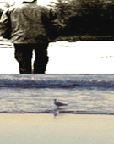
narrativas contadas narrativas vividas
"Storytelling relies on the combined human strengths of memory, imagination, and communication. The forms and methodologies of storytelling allow us to sift through and make sense of happenings in our own lives and in the lives of others. Whether drawn from representations of reality or shaped as fantasy worlds, stories tap into and represent the collective psyche of our culture. For the human being, story-making and story-listening are both a pleasure and a privilege." -- "Desire versus Destiny: the question of payoff in narrative," Glorianna Davenport, Barcelona, Spain, January 29, 2005
somewhere between here and there narrativas contadas narrativas vividas--by Alicia Felberbaum--is an interactive video installation, designed to be shown as a live, presentation in a gallery environment as well as for Internet viewing and interaction.
Somewhere between here and there, narrativas contadas narrativas vividas experiments with aesthetic and theoretical forms assigned to the documentary genre and also focuses on the potential of ’soft-linked’ stories (stories that are linked through software devices) when computers are added to the storytelling process, through algorithms applied to an array of elements [images, audio and video segments] stored in a database.
Different people were interviewed and videoed, their stories were then fragmented and embedded within the interactive work. It features people from diverse contexts, investigating spaces, experiences and struggles surrounding migration and exploring their psychological and physical journeys, and portrays the perception of the migrant experience by migrants themselves as a complex and multidimensional phenomenon. Migrants become the historians of their own lives with their own voice.
As well as documenting stories, the work allows to create associations within those stories and other visual material combined ‘on the fly’, generating a range of alternative frameworks. These frameworks are dynamically generated based on the interaction between the author’s definitions, the choices of the navigator and the matching algorithm embedded in the program. Unlike a traditional documentary, there are deviations in story directions. The author does not solely control “what happens next”; instead, that task is for the machine and the audience to navigate together.
Developed by an interdisciplinary team from London and Buenos Aires; directed, written and produced by Felberbaum [UK] and an Argentinian IT team lead by José Broide in Buenos Aires.
Jose Broide, is an IT project manager who holds a Master in Electronic Engineer from Buenos Aires University Argentina. As an IT project manager he has participated in industrial and educational software projects. He has also has been involved in software developments for art installations designing and directed the development of the software platform for this work.
Biography
Alicia Felberbaum is a new media artist living and working in London, she was born in Buenos Aires, Argentina. In 2001 she was honoured with the prestigious NESTA’s Fellowship. http://www.nesta.org.uk/ During the first two years of the Fellowship she was affiliated to the Goldsmiths Digital Studios, Goldsmiths College, University of London. MA graduate of Goldsmiths College, with honours in 1996, she has exhibited art works internationally; Midlands Art Centre, Birmingham, UK; IMA, Institute of Modern Art, Brisbane, Australia; Piece Hall Art Gallery, Halifax, UK; Pitshanger Manor Gallery and Museum, London; Angel Row Gallery, Nottingham, UK; De Oude Kerk, Amsterdam: Axis, Foundation, Netherlands; transmediale 99 - international media art festival, Berlin, Germany; Conseil des Arts textiles du Québec, Toronto, Québec and Montréal, Canada; 1998, Studio XX's 2nd Annual International Festival of Web Art, Montréal, Canada; Lovebytes Digital Arts Festival, Sheffield, UK; International Triennale of Tapestry, Lodz, Poland; U.C. Davis Design Gallery, California, USA; Camden Arts Centre, London; On Gallery, Poznan, Poland; and earlier in 1997 UNCUT-Interaction, ICA, London. _ She participated in numerous conferences including Viper Basel, 2004, International Festival for Film Video and New Media, Switzerland; 2001 DAC International Digital Arts and Culture Conference Brown University Providence, Rhode Island, USA; CADE 2001 Digital Creativity Glasgow, Scotland and Ordinatrices/Computers-International Conference, 1999, McGill University Montreal, Canada. _ She has received all levels of grants, awards and artist residence to support her work including from Nesta, National Endowment for Science, Technology and the Arts; Award for the Research Exchange Scheme from the Arts and Humanities Research Board in collaboration with Science Communication Group, Imperial College of Science, Technology and Medicine, London; transmediale 99 Award - international media art festival for Internet projects, Berlin, Germany; Awards to Individual Artists, London Arts Board, UK; in 1998 she was commissioned for a collaborative public Internet project, as part of the Photo 98 Public Sightings Program; she was Artist in Residence at Artec, Arts Technology Centre, the first independent centre in the UK dedicated to creative applications of digital technology and in 1997 she was artist in Residence, Camden Arts Centre, London. [via Rhizome]
Posted by jo at 08:15 AM | Comments (0)
Postmedial Condition

Interdisciplinary Processes
Postmedial Condition: Back in the 1920s, painters, sculptors, photographers and avant-garde filmmakers first opened up the field of media art and declared all materials to be equal. Since the 1960s, the first generation of Austrian media artists, represented by names such as Adrian, Bechtold, Export, Gappmayr, Kriesche, Petzold, Rühm, Weibel, etc., has been making a very specific contribution to international art. What makes it so specific is the fact that the analytical traditions of the past – from the language analysis of the Vienna Circle to Sigmund Freud’s psychoanalysis – opened up discourses that made the critical analysis of the media possible and offered adequate reflection on the emergence of new medial forms, such as video, Expanded Cinema, or digital images.
Taking up themes and/or questions relating to socio-culture, social analysis and media analysis, Austrian media art forms an independent unit. Ever since the emergence of the Wiener Werkstätte, Austria has held on to its tradit ion of merging the borders between free and applied art, architecture and design, sculpture and stage design, and this, together with the country’s strong media tradition that reaches from avant-garde films to virtual reality, has led to a pronounced orientation towards the postmedial in Austria.

The term “postmedial”, based on Rosalind Krauss’s “Art in the Age of the Post-Medium Condition”, the subheading of her famous essay “A Voyage on the North Sea” from 1999, strikes us as particularly apt for characterizing the artistic practice that forms the conceptual basis of this exhibition. Artists operate between different media, materials, and functions; they adapt new production processes, mix different media characteristics, and create new reference systems. This process is not dominated by one single medium – instead, the different media influence and shape, and at the same time, reflect one another.
Interdisciplinary processes that take place between the fields of drawing, painting, sculpture, photography, film, video, literature, architecture, design, Net Art and computer language are becoming the methodic principle. On the basis of 41 artistic positions, the exhibition wants to draw attention to a present development in Austrian art that will certainly constitute one more important contribution to the evolution of international art.
Curators: Elisabeth Fiedler, Christa Steinle
Scientific advisor: Peter Weibel
This exhibition, supported by the State Secretary of Arts and Media in Austria, is a co-operation with Centro Cultural Conde Duque, Medialab in Madrid, where it will be shown from 8 February – 26 April 2006 during the artfair ARCO 2006 with Austria as guest country.
Contact:
Neue Galerie Graz am Landesmuseum Joanneum
Sackstrasse 16, A-8010 Graz / Austria
T +43-316-82 91 55 / F +43-316-81 54 01
neuegalerie[at]museum-joanneum.at
Opening times: Tue–Sun 10am–6 pm, Thu 10am–8pm
Posted by jo at 08:02 AM | Comments (0)
November 14, 2005
VGMap
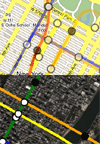
Vector Overlays for Google Maps
VGMap is a new library created by Eyebeam R&D that allows designers, developers, and mapping geeks to overlay data on top of Google Maps in a richer way than is possible using their standard system. It is called VGMap because it adds vector-drawing capability to the already-awesome GMap API.
The Google Maps API enables point and line data on their maps in the form of markers, and polylines. This has yielded a lot of great applications, such as Housing Maps and the GMaps Pedometer (see more at Google Maps Mania). What it does not allow for is vector graphics, which precludes the use of Google Maps for more sophisticated GIS applications. Flash provides for vector drawing, as well as a well-worn interactive and animation functionality. This VGMap library is simply the glue between GMap and Flash, as well as a handful of Flash ActionScript libraries and sample code to simplify the process of drawing over the map correctly.
Posted by jo at 09:00 PM | Comments (0)
Shoot me if you can
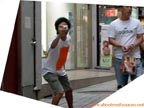
Replace a gun with fun
Shoot me if you can is an urban game inspired by first person shooting online video games. Replace a gun with fun, and shoot the opposing team with a cellular phone equipped with a digital camera. Participants; shooters are given a team color and phone number printed on the sticker. Shooters have to take a picture of the opposing team. If successful, she/he sends the picture to the opponent team member, via multimedia SMS system. Different rules exist for variations in game. Tactics are an important part as well as team work and understanding of the urban environment. This work is a commentary on abundance of digital image in our culture, desire to photograph and violence of surveillance camera. Active public participation in encouraged through website and the game. [via pasta and vinegar]
Posted by jo at 06:02 PM | Comments (0)
Dave Miller
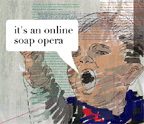
It's an Online Soap Opera
Corrugation Street--by Dave Miller--is an experiment in collaborative storytelling and networked narratives. It’s a soap opera that you can help write. Get involved in making the story. Be a co-author, co-illustrator or a researcher. Change the subject of the story, the mood, or the look and feel. Create your own unique version of the story, told in your own personal way.
Your selections decide how each scene in the story will look. The subjects and search terms you choose decide which pictures and RSS feeds are pulled in live from the Internet. It’s impossible to predict what results you’ll get, but your choices will have a big effect on the story.
Add your own RSS feeds if you have particular subjects you’d like to add to the stories, and you know the RSS link. If you’d like to add your own image, whether on the internet or on your own computer, add the URL or file path to include it in the story. When you click the ‘Make my story!’ button, the generator script gets busy. Text and pictures are pulled from the Internet, processed and mixed in with my story.
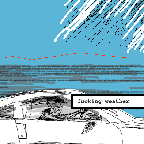
Chinese Cocklepickers is an interactive narrative which deals with the tragedy of the chinese migrant workers who died in Morecambe Bay, in the tragic events of February 2004. There are many separate and interconnected strands to this story: the experience of the workers who drowned, the bosses exploiting their cheap work, the reactions and feelings of the local people, the families in China and their reactions, and lastly the media/political reactions and economics behind the story. These strands are presented as parallel narratives through the story. Each one is small view of the bigger picture, each giving a different perspective. Users can choose their own path through the separate strands, so that they can affect, choose or change the plot. The result, we hope, is that each user experiences the story in a different way, and gains a unique perspective of the story. Design/story: Dave Miller; Programming: Kalle Kormann.
Dave Miller is currently studying a Master's Degree at Ravensbourne College, Kent, UK. His focus is on exploring new interactive story possibilities using networked technology. He's set up a blog to help develop his project and dissertation.
Posted by jo at 05:05 PM | Comments (0)
17 Minutes
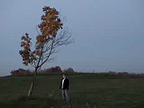
From Personal to Public
"Every 17 minutes, someone commits suicide in the United States." 17 Minutes is a video blog/performance project by Chris Barr. Each day he spends 17 minutes standing next to a tree, collapsing at end of the duration. Using time as a signifer, this ritual offers a place of reflection to the viewer and the artist, and deals with the specific circumstance of his own brother's suicide. As a reenactment it aims to be reminder of the life he is engaged in.
The project plays with the diaristic characteristics of blogs to move personal moments into the public/political sphere.
Posted by jo at 04:23 PM | Comments (0)
9th Annual Subtle Technologies Festival
![]()
Responsive Architectures
9th Annual Subtle Technologies Festival: Responsive Architectures, June 1st - June 4th, 2006, University of Toronto, Toronto Canada.
Recognized internationally as a forum that encourages new insights and collaborations, Subtle Technologies invites artists and scientists to contemplate how art and science can work together and reshape perspectives. The gathering will include four days of presentations including illustrated talks, gallery installations, workshops and discussions. Subtle Technologies events encourage active discussion and draws upon the wide-ranging perspectives of participants and audience members. The extraordinary interest of highly specialized topics and often-unexpected threads woven between presentations make the festival a unique experience.
This year's theme for Subtle Technologies is Responsive Architecture. We are interested in investigating how environments and systems can interact and respond to their occupants. We hope for wide-ranging discussions and presentations that explore dynamic systems and environments at every scale, from molecules to continents. The conference will include a wide definition of architecture that encompasses buildings, mechanical and natural environments.
Examples of possible topics include:
Interactive systems
Smart materials
Buildings that can move and transform
Adaptive environments
Hybrid ecologies
Complex systems analysis
Expanded perception
Within this general theme, sound and acoustics will be a special focus. The 2006 festival is being held in partnership with SoundaXis, a Toronto-wide event inspired by the work of renowned architect-composer Iannis Xenakis.
Specialized topics include:
Resonance
Spatial acoustics
Physics of sound
Psychoacoustics
Sound Installations
We encourage demonstrations and can accommodate a wide variety of presentations. Technical support and honoraria for presenters is included.
Summaries of past presentations are archived on our website. We encourage those interested in submitting a proposal to acquaint themselves with our history of programming.
The festival is open to the public and presentations should be accessible to a non-specialized audience. Presentations typically last 40 minutes, followed by a ten minute question and answer period.
Deadline for Proposals: January 15, 2005.
How to Apply
Use our online submission form.
If you have any questions feel free to contact us at programming[at]subtletechnologies.com
Posted by jo at 09:52 AM | Comments (0)
Radio_Copernicus

Talking Back to Radio
Talking Back to Radio--Radio als Zuhörer Artyści zmieniają radio: Workshops, Installations, Interventions, Netperformances, Concerts and Symposium in Wroclaw; December 6th - December 11th, 2005.
SYMPOSIUM: “Radio – one speaks without being able to hear and many hear without being able to speak.” With this sentence, German media theorist Rudolf Arnheim criticized what he saw as the absurd paradox of radio in the 1930s. As long as radio operates as an one-way broadcast, it allows for no spontaneity. At best, it can serve only as a restricted and highly circumstantial form of communication. Echoing Arnheim’s criticism of the medium was German playwright Bertolt Brecht. Both men wanted to transform radio into a two-way medium, and in doing so close the circle of communication between listener and broadcaster.
The Radio_Copernicus series “Talking Back to Radio – Radio als Zuhörer – Artyści zmieniają radio” takes this concept and applies it to art. What connection do artists have to radio? How does radio change if it adopts aesthetic criteria? To what extent does the medium need to change its image and position in society to be a vehicle for innovative, artistic developments and, as a concequence, develop an advanced radio culture?
Radio_Copernicus organizes an international symposium at the Universiyty of Wroclaw, which examines the subject "artist radio" from different perspectives.
WORKSHOPS: What happens to radio, if artists take control? What is happening to the medium if it ignores the paradigm of marketing, news broadcasting and power rotation playlists? A wealth of alternative “radio activities” by engaged professionals around the world demonstrate that such a radio is conceivable, feasible and in demand. Radio_Copernicus provides a open forum to discuss possible answers to these questions -- not only in its programming, which is open to any form of radio art, but also in dedicated workshops. One such opportunity is offered by the international symposium “Talking Back to Radio”, to be held in Wroclaw, Poland, at the beginning of December. Those taking part in the event will discuss the key issues in the relationship between radio and art, and will receive practical, hands-on guidance from renown radio professionals.
The four workshops will take varying thematic approaches. The results will be presented by participants and their workshop supervisors at the international symposium “Talking Back To Radio” (18:30, Saturday, 10.12.05).
Workshop 1: Free Radio: A Media-Simulation in Three Days with Thomas Kupfer and Lukasz Smigiel
Workshop 2: Soundwalking From the Ear to the Radio Broadcast with Hildegard Westekamp and Lukasz Szalankiewicz
Workshop 3: LIGNA – Radio Art as Intervention and ‘Counter-Public’: Uncontrollable Situations, Unpredictable Productions with Ole Frahm and Torsten Michaelsen
Workshop 4: What is Radio Art? Artistic Approaches in International Comparison with Sabine Breitsameter and Robert Gawlowski
Parallel to the workshops is a nightly program of installations, net performances, concerts and radio plays at BWA Municipal Gallery/Wroclaw. The international symposium “Talking Back to Radio – Radio als Zuhörer – Artyści zmieniają radio” takes place from December 10 – 11. Admission is free in each case.
Posted by jo at 09:33 AM | Comments (0)
Mediamatic Interactive Film Lab @ Impakt & HKU

Local Truth
Mediamatic Interactive Film Lab @ Impakt & HKU; 7|8|9|10|11 december; final presentation 11 december--Mediamatic with the Impakt festival and the Utrecht Academy of Arts organizes a workshop on online databased film. In this 5-day workshop you and 15 other film-, tv-, radio, new media makers from all over Europe use your own footage to make an online interactive film, and explore how to integrate the viewer's choices in a meaningful way.
Thematically the participants are invited to explore their notion of local truth: market forces and political processes can less and less escape their global grids, and media are becoming more and more personal and intimate. Can we only look for truth and authenticity locally?
To make their interactive film, participants use the ever evolving Korsakow software. This workshop starts the 7th of December with speakers that present a selection of interesting interactive film projects. During the next four days you’ll work on your own project withpersonal technical and theoretical support from trainers and teachers. At the end of the workshop a selection of workshop projects will be presented to the audience.
Visit the Mediamatic website for more information and registration. You can also mail workshops[at]mediamatic.nl or call Mediamatic (+31)0206389901.
This workshop is made possible with the support of the MEDIA PLUS PROGRAMME of the European Community.
Posted by jo at 03:35 AM | Comments (0)
November 11, 2005
?Blog?
![]()
Extended Deadline: November 15
The Blog, one of the most spread forms of expression on the web, varying from personal diaries to community weblogs, professional knowledge exchange resources, political campaigns and more. In their different manifestations, blogs (moblogs, videoblogs, photoblogs, etc.), became a phenomenon influencing in many cases upon social and cultural areas: journalism, politics, alternative knowledge sources, literature, art, etc.
The ?Blog? project takes blog as art and as a stage for net artworks investigating the language, the aesthetics, the impacts and the practices of blogs, blogging and the blogosphere.
In this context, it’s worth mentioning the blog.art project –one of the first projects dealing with the notion of blog as art — operating for about a year and publishing blog-defined art projects.
?Blog? project acts (is envisioned to act) as a platform for an open discussion on the topic and as a pool for submitting works. no-org.net invites submissions of art projects making use of blog as a tool, subject, or both as well as texts investigating the blog-art interplay in a broad sense.
Selected texts and artworks will be exhibited (separately) on the no-org.net website. The launch of the project will be accompanied by an opening event and the discussion, that will get documented on the no-org.net website.
sala-manca.net | [h]earat shulaym |
no-org.net
pob 24169 jerusalem (91240)
Posted by jo at 04:38 PM | Comments (0)
Manuel Castells in conversation with

Not A Cornfield artist Lauren Bon
Date: Friday November 11th, 2005; Time: 7:30 PM - 10:30 PM; Location: The Not A Cornfield project site, 1201 North Spring St, Los Angeles, CA, Downtown Cost: Free.
Wallis Annenberg Chair of USC'sof Communication Technology and Society at the Annenberg School of Communication, Sociologist Manuel Castells is internationally renowned for his theory of the Network Society, which describes the spatial form of our time as the 'metropolitan region' - a constellation of multiple nuclear centers, settlements, populations, and activities that are held together as a unit by transportation and communication networks.
Stretching from Ventura to Tijuana, Los Angeles is the 'ultimate region'. A huge urbanized sprawl with many centers in which already extreme social, ethic and economic segregation is increasing and the real estate engine drives the city ever deeper into the desert, causing widespread environmental degradation as it goes.
In this contemporary context the need to develop new forms of livable high density becomes urgent. In particular, if cities are to be saved on behalf of citizens, then innovation will come from urban planners, architects, professionals and concerned citizens forming alliances that take a holistic approach to creating multiple meaningful social spaces all around the metro landscape.
In conversation with artist Lauren Bon - whose Not A Cornfield project reclaims a brownfield site for public use and restores meaning to the historic birthplace of LA - Professor Castells will discuss his groundbreaking analyses and thoughts regarding the state and direction of human experience in the Network Society. [blogged by marc tuters on USC Interactive Media Division Weblog]
Posted by jo at 11:15 AM | Comments (0)
BUSY SIGNALS: TELEPHONIC ART IN MOTION
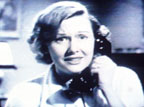
Bring Your Camera Phones!
Pacific Film Archive presents: BUSY SIGNALS: TELEPHONIC ART IN MOTION A two-part series: Wed Nov 16 & Wed Nov 30.
Though classified as a communications device, the telephone really is an instrument of culture. The phone has always shaped the way people relate by collapsing distance, reinventing conversation, even questioning the notion of privacy. But in recent years, especially with the advent of the cell phone, this device has been at the hub of a lively and inventive commerce in data delivery, fashion, recreation, intercourse, and even art. Now we have miniaturized movies dropped into waiting receivers; camera phones uploading stills to Web storage; ringtones merchandised as personal branding; text messaging coming on like a poetry slam. As usual, artists have answered the call, wringing minimalist melody from polyphonics, disrupting the everyday with creative pranks, or simply investigating the meaning of messages from nowhere. Join us for two evenings of Busy Signals: toney performance, cellular trickery, and films about phones. We promise, not a single wrong number.
Wed Nov 16, 7:30, Rotary: Live Performance by Marisa Olson.
Andy Warhol's riotous 1973 quasi-TV show Phoney stars his Factory luminaries, while Christian Marclay's Telephones stars just about everyone famous as he pillages Hollywood films for a montage about the anxiety of human intercourse. Also, works from the British Pocket Shorts, and a live telephonic performance by Marisa Olson. Plus many surprises!
On both evenings, Benjamin Hill and Carrie Burgener from UC Berkeley's School of Information Management and Systems will involve us in a projected mosaic using your camera phone images as raw material.
Wed Nov 30, 7:30, Touchtone: Live Performance by Jon Brumit.
Some filmmakers are closet phonephreaks, and tonight's program brings them
out of the phone booth: works by Eric Saks, Chris Sollars, Golan Levin, Lee Walton, and others. Composer Jon Brumit will conduct live telephonic musical auditions. Once again, bring your camera phones for a projected mosaic using your images.
The Pacific Film Archive theater is located at 2575 Bancroft Way, one block east of Telegraph Avenue, in Berkeley. for more info: 510.642.1412.
Steve Seid
Video Curator
Pacific Film Archive
2625 Durant Avenue
Berkeley, CA 94720-2250
510/642-5253
Posted by jo at 10:53 AM | Comments (0)
Under Scan
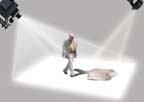
Shadow Video-Portraits
For UNDER SCAN, by Rafael Lozano-Hemmer, thousands of "video-portraits" taken in Derby, Leicester, Lincoln, Northampton and Nottingham (UK) will be projected onto the ground of the main squares and pedestrian thoroughfares of the cities. At first, the portraits will not be visible because the space will be flooded by white light. As people walk around the area, their shadow will be cast on the floor, revealing the video-portraits.
The video sequences begin with the subjects in a still position turned away from the camera. As they appear within pedestrians' shadows, their bodies move and their heads turn to look straight at the pedestrian. When a shadow moves away from a portrait, the portrait likewise reacts by losing interest and looking away.
See it at Lincoln: Nov. 25 to Dec. 4; Leicester: Jan. 13-22, 2006; Northampton: Feb. 3-12, 2006; Derby: Feb. 24 to March 5, 2006 and Nottingham: March 17-26, 2006. [blogged by Regine on we-make-money-not] [Related]
Posted by jo at 10:21 AM | Comments (0)
HTTP Gallery
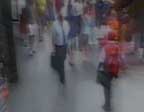
Stanza: Abuse of the Public Domain
HTTP presents Abuse of the Public Domain, the first solo show of networked media art by Stanza--Private View Thursday 8th December 7-9pm; 9th December 2005- 23rd January 2006.
This exhibition features two large video projections, which use live real-time data from CCTV cameras sited in two cities, London and New York. Security tracking data is Stanza's chosen medium for these process-led artworks.
You are my subject uses data from a single fixed camera in New York, focusing on subjects as they pass below it. Authenticity [Trying to imagine the world from everyone elses’ perspective, all at once] draws its imagery from cameras all over London. Other works can be viewed in a web browser via the Internet and turn us all into voyeurs of eerie 'parallel realities'.
“CCTV systems are everywhere in the public domain. Millions of hours worth of data are recorded every day by these cameras. We are all unwitting bit part actors, in the filming of our own lives. Usually we cannot watch. The results are not collected for broadcast back to the public. Rather they are monitored, filtered, distributed and archived without our knowledge or permission. The city has millions of CCTV cameras. One can take the sounds and images off live web streams to offer them back to the public for new interpretations of the city. In essence the city of London can be imagined as the biggest TV station in existence.”
About Stanza: Stanza is a London-based artist, who specialises in net art, multimedia, and electronic sounds. His award winning online projects have been invited for exhibition in digital festivals around the world, and Stanza also travels extensively to present his net art, lecturing and giving performances of his audiovisual interactions. His works explore artistic and technical opportunities to enable new aesthetic perspectives, experiences and perceptions within the context of architecture, data spaces and online environments.
Awards: Videoformes Multimedia First prize France 2005, Netsa Dreamtime 2004, Art In Motion V.First prize USA 2004, Vidalife 6.0 first prize 2003, Fififestival Grand Prize France 2003, New Forms Net Art Prize Canada 2003, Fluxus Online first prize Brasil 2002, SeNef Online Grand Prix Korea 2002, Links first prize Porto 2001, Videobrasil Sao Paulo 2001 first prize, Cynet art 2000 first prize, Dresden.
For more information and images, please contact Stéphanie Delcroix, stephanie[at]furtherfield.org or 0207 700 7859. Open Friday to Sunday 12noon-5pm.
HTTP [House of Technologically Termed Praxis] is one of London's foremost galleries dedicated to showing net art, new media and sound art. HTTP was opened on the initiative of Furtherfield (http://www.furtherfield.org) in the vibrant and culturally diverse Green Lanes area of North London. HTTP works with a wide range of artists and audiences to explore the potential of current network technology and to promote distributed creativity. HTTP is supported by Arts Council of England. Furtherfield is an online platform for the creation, promotion and criticism of net art, new media and sound art. http://www.http.uk.net/
Getting to HTTP
Tube: Manor House
Buses: 341, 141
Train: Haringey Green Lanes.
Past Exhibitions at HTTP
Posted by jo at 10:05 AM | Comments (0)
The E-Mail Time Capsule
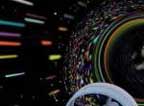
Forbes.com to Store Personal Messages
Most time capsules involve cramming stuff into a metal box and burying it in a hole in the ground. It's a method that works --but it's so primitive. What if you could write an email to yourself, and be assured of receiving it twenty years in the future?
That's what we've done with this email time capsule. Simply fill out the fields below, decide how long you want the capsule to be sealed for, and hit send. We'll do our best to make sure the message gets delivered. [blogged on random]
Posted by jo at 09:14 AM | Comments (0)
November 10, 2005
GPSdiary.org
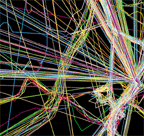
Follow Along
GPSdiary.org is an online archive of an art project, in which artist Thorsten Knaub recorded his daily movements over the course of a year by carrying a Global Positioning System(GPS) receiver on him.
The GPS utilises special satellites in the earths’ orbit to record any change of one’s position on the surface of the earth. Therefore any kind of movement will be charted according to the latitude and longitude grid system, e.g. a walk to the local shop results in a small 'drawing', a day spent at home will be recorded as a dot only but a journey on the London Underground results in a straight line between the tube station where he is out of range of the GPS satellites.
GPSdiary.org makes it possible to view each days’ trajectory individually and hence follow the artists’ daily routine and movements. [via rhizome]
Posted by jo at 05:46 PM | Comments (0)
GeoDrawing
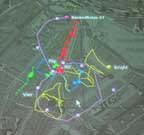
Drawing 8s in the Night
With GeoDrawing, a GPS-based mobile drawing game for the Amsterdam Museum Night, "teams would go into the city where they compete on who would (geo)draw the most beautiful "8" by walking with a GPS and a mobile phone. They could embellish their drawings with photo’s and video’s taken and submitted on the spot. The competitive element was creativity with both the drawing and the media. All submitted media were tagged to the geographic locations where they were taken. The player’s movements, tracks and media could be followed in real-time through a webbrowser." [via pasta and vinegar]
Posted by jo at 05:00 PM | Comments (0)
Embrace

Provoking Shared Experiences
A concept proposal for an interactive bracelet with little informative displays, to provoke shared experiences between wearers in close proximity. Embrace stands for the 'brace'-lets fitting together & representing its users, who 'embrace' one another. The wearable display consists of several nodes: a LCD screen displaying wirelessly sent images, a battery, a camera lens that constantly records images until the user specifically shoots an image, & a scent-palette housing that emits 1 of 5 odors chosen by the owner of the device indicating an incoming image from their 'significant other'. see also fuse for a conceptually similar working prototype. [blogged on infosthetics]
Posted by jo at 04:48 PM | Comments (0)
Re: a new definition

Definitions and Neutrality
"This discussion is starting to get interesting. I too agree with Florian and disagree with Olia that Olia's text is not as good as the texts Olia replaced. I also do not think Olia is keeping to Wikipedia's goal of "neutrality." In fact, many Wikipedia entries fail to achieve "neutrality." Perhaps as interesting, as a scholar I find Olia's position argumentative and the previous entries not argumentative and not "bad." Much of Olia's defense is argumentative, which is out of keeping with Wikipedia's stated goals. If I refer to Wikipedia in a published work, I would have no reason to expect the Wikipedia entry to change, and certainly not so dramatically, and certainly not on the authority of one person. Despite all this, THIS IS WHAT I LOVE ABOUT WIKIPEDIA. There *are* more and less neutral definitions in the world, but they are unstable and unreliable and likely to be overtaken by more opinionated advocates. The Britannica illusion of stable definitions is false and always has been false..." Re: a new definition posted by David Golumbia from gmane.culture.internet.nettime
"an interesting discussion starting up on the nettime list. interesting both in terms of 'definitions' of 'new media' and in terms of the usefulness or otherwise of wikipedia collaborative practices for definining current terminologies... http://www.nettime.org/Lists-Archives/nettime-l-0511/threads.html"--amc [relogged by amc on eyebeam] Olia Lialina's rewrite is here >>; and her original post is here >>
Posted by jo at 03:10 PM | Comments (0)
CYNETart_05fragile

9th International Festival for Computer-Based Art
The 9th International Festival for Computer-Based Art CYNETart_05fragile takes place from November 24-27, 2005 in the Deutsches Hygiene-Museum Dresden. Interactive dance pieces, electronic music, audio-visual concerts and a forum are presented on the three festival nights. One of the main events is the multimedia concert "Boxberg Sinfonie" for projection, orchestra and computer: A completely revised version of Fritz Lang's film "Metropolis" is accompanied by a symphony orchestra playing Bach and by a real-time remix.
The national multimedia youth competition MB21 is the youngest guest of the festival organised by Trans-Media-Akademie Hellerau and The City of Dresden. The prize winning works are on display in the gallery of the Deutsches Hygiene-Museum Dresden on the four festival days. All in all, CYNETart_05fragile presents five performances and different interactive installations in the Deutsches Hygiene-Museum, in the Interaktiver Pavillon near Dresden's Kreuzkirche, in the event gallery ÑLíHoupì and in the Zoo of Dresden. One of them is a group of most unusual ballons flying around in the Deutsches Hygiene-Museum. Equipped with on-board electronics they are linked with each other and they react to the visitors.
Posted by jo at 10:15 AM | Comments (0)
Transmute Collective
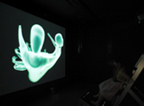
Intimate Transactions Between London and Greece
The Transmute Collective (Keith Armstrong (Dir.), Lisa O'Neill and Guy Webster) and their collaborators announce that Intimate Transactions (a networked interactive artwork) will be next shown simultaneously between the Institute of Contemporary Art, The Mall, London & BIOS (New Synthesis of Urban Culture), Athens, Greece. Date: 12 Nov - Wed 23 Nov 2005; 12 - 8pm UK GMT.
Intimate Transactions is an exciting new form of interactive installation that allows two people in separate spaces to interact simultaneously using their bodies. Each participant uses a physical interface called a Bodyshelf. By gently moving their bodies on this smart furniture they instigate Intimate Transactions, which influence an evolving world created from digital imagery, multichannel sound and tactile feedback.
Intimate Transactions was awarded an Honourable Mention in this year's Prix Ars Electronica in the Interactive Arts Category. Transmute pay tribute to all of the artists, staff and partners involved in making this project possible over the past four years.
Look out for the forthcoming ACID book/dvd, edited by jillian Hamilton: Intimate Transactions: Art, Interaction and Exhibition within Distributed Network Environments. For more details email ITBook[at]embodiedmedia.com
We particularly thank our major partners for this showing: The Australasian CRC For Interaction Design, Arts Queensland, The Institute For contemporary Art, BIOS and the Australia Council New Media Arts Board. Keith and Guy will attend this event courtesy of Arts Queensland, the ICA and BIOS.
This project has been assisted by the Australasian CRC For Interaction Design (ACID), the Australian Government through the Australia Council, its arts funding and advisory body & the Queensland Government through Arts Queensland. Intimate Transactions was developed with support from the Performance Space Headpsace Residency Program.
Posted by jo at 09:06 AM | Comments (0)
November 09, 2005
OKNO brussels
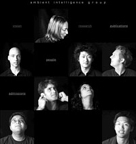
Ambient Intelligence Round-Table
OKNO brussels ::: art and technology ::: round-table on the human/machine interactive experience; Monday, November 14, 2005 -- 8pm; streamed live. Participants: Pattie Maes [MIT, usa] in discussion with Maja Kuzmanovic [FoAM, be]. Disrupting accents by Daniel Franco, urban philosopher [be].
Pattie Maes will present the research projects of the Ambient Intelligence research group [MIT]. The goal of the Ambient Intelligence group is to radically rethink the human-machine interactive experience. By designing interfaces that are more immersive, more intelligent, and more interactive they are changing the human-machine relationship and creating systems that are more responsive to people's needs and actions, and that become true "accessories" for expanding people's minds.
Pattie Maes' sparring partners around the table are Maja Kuzmanovic [FoAM], and Daniel Franco [philosopher]. Together they will moderate the Q & A by technological artists towards whom this round-table discussion is addressed.
FoAM: is a laboratory for the propagation of lived experience, whose members are looking for processes, moments and situations in which experience can be freed from cultural and historical biases. This allows the participants to absorb fresh stimuli. In order to locate these experiences in engaging cultural and ecological contexts, they often work in non-institutionalised public spaces: from roof gardens to intimate living rooms, clubs and overgrown fortresses. FoAM's collaborators dwell most of the time in the murky spaces between the physical and digital, scientific and artistic, natural and technological worlds. They inhabit these spaces to research and develop responsive environments, active materials, generative media, culinary performances and other entangled forms of contemporary creative expression.
Pattie Maes is an associate professor in MIT's Program in Media Arts and Sciences. She founded and directs the Media Lab's Ambient Intelligence research group. Previously, she founded and ran the Software Agents group. Prior to joining the Media Lab, Maes was a visiting professor and a research scientist at the MIT Artificial Intelligence Lab. She holds bachelor's and PhD degrees in computer science from the Vrije Universiteit Brussel in Belgium. Her areas of expertise are human-computer interaction, artifical life, artificial intelligence, collective intelligence, and intelligence augmentation.
Maja Kuzmanovic, has completed the BA in Design Forecasting (HKU, nl) in 1996 and MA in Interactive Multimedia (University of Portsmouth) in 1997. After graduation, she collaborated on a range of interdisciplinary projects in research institutes around Europe, as well as an independent artist-researcher. Her research spanned novel forms of performance and multi-sensory storytelling and responsive media design for virtual and mixed reality. She founded FoAM as a cultural research department in Starlab in 2000. In 2001 FoAM became an independent, distributed entity with cells in Brussels and Amsterdam.
the discussion will be live-streamed on radio OKNO [monday november 14th/from 8pm] more info.
|||||OKNO|||||||||||||||||||||||||||
koolmijnenkaai 30/34 quai aux charbonnages | brussels 1080 | belgium20 tram 18 [walvis] | Metro Graaf van Vlaanderen / Comte de Flandres20 okno is supported by the Ministry of the Flemisch Community and the VGC.
Posted by jo at 03:50 PM | Comments (0)
Harvestworks
![]()
Sensor Building with Miditron
SENSOR BUILDING WITH THE MIDITRON - w/ Eric Singer: Learn to create sensor interfaces to extend and control your Max/MSP/Jitter performance environment, or any other software that accepts MIDI data as controllers. Instead of building everything from scratch, students will work with Eric Singer's Miditron to start with sensors right away.
Eric Singer's MidiTron is a MIDI to real-world interface designed to simplify the process of creating sensor and robotics based electronic art projects. It is easily user configurable and provides 20 terminals of digital and analog inputs and outputs in any combination.
SATURDAY & SUNDAY, DECEMBER 17th/18th, 12-6pm.
The materials fee for the class includes the Miditron plus additional materials (sensors, cables, etc.), that the student will keep. If you own a Miditron already, the materials fee will be $25. Max/MSP knowledge is helpful, but not necessary.
8 hrs of labtime included.
$375/members, $435/non-members, plus $150 lab fee ($125/Miditron, $25/materials). Membership is $75/yr
Call Hans Tammen 212-431-1130 ext 13 in case you have questions, or to sign up.
Harvestworks is a nonprofit Digital Media Arts Center that provides resources for artists to learn digital tools and exhibit experimental work created with digital technologies. Our programs are made possible with funds from mediaThe foundation, New York State Council on the Arts, the National Endowment for the Arts, the NYC Dept. of Cultural Affairs, Materials for the Arts, The Experimental TV Center, the Mary Flagler Cary Trust, the Aaron Copland Fund, The Greenwall Foundation, the Jerome Foundation, Foundation for Contemporary Performance Arts, JP Morgan Chase Foundation and the Rodney White Foundation.
HARVESTWORKS Digital Media Arts Center
596 Broadway, Suite 602 (at Houston St)
New York, NY 10012
Tel: 212-431-1130
http://www.harvestworks.org
mailto:info[at]harvestworks.org
Subway: F/V Broadway/Lafayette, 6 Bleeker, W/R Prince
Posted by jo at 02:15 PM | Comments (0)
network culture

or Transcontemporaneity
"Fredric Jameson's classic description of Postmodernism as the cultural logic of late capitalism is now well over twenty years old. Jameson's analysis is crucial for understanding late twentieth century thinking, but in the intervening years, culture has changed radically.
As part of my Networked Publics fellowship at the Annenberg Center for Communication, I am preparing a series of documents about the cultural dominant that succeeds postmodernism. This material was developed over the last four years with new media architecture collaborative AUDC.
Instead of a theoretical piece, I'll open this discussion with a table outlining some empirical observations about this new condition which we can term "Network Culture," or perhaps "Transcontemporaneity.": [blogged by kazys on varnelis.net]
Posted by jo at 11:26 AM | Comments (0)
Networked Artwork
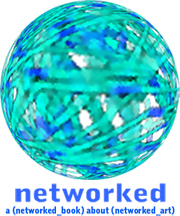
...slowly beginning to attract attention
"The Internet was supposed to bring us all together. Just ten years ago, the world was awash in bold predictions: The Web would obliterate race, gender and nationality. It would break down social barriers. It would usher in a new era of classless communication and interpersonal understanding. Yeah, right. "The Net is still a confused social space," says Andrew Shoben, founder of British artist collective Greyworld, "and for most of us, it's still a very private experience."
In the meantime, however, a diverse group of artists and engineers has quietly been developing projects that use networking technology to connect in the real world. Materials range from cell phones and Global Positioning Systems to ordinary objects such as beds and benches that are connected through a wireless network. Known as networked art, these projects are poised between art and commerce, and they are slowly beginning to attract attention..." From Networked Artwork by Leah Hoffmann, Forbes.com
Posted by jo at 11:04 AM | Comments (0)
Vivisector
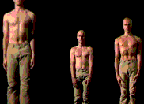
INTERVENTION IN THE SWEATING BODY
With Vivisector dance enters a new dimension in the latest collaboration between choreographer Chris Haring and cross-media artist Klaus Obermaier. Vivisector explores the physical and metaphorical possibilities of the human body, using projections to dissolve, alter and mutate the dancers' forms. Vivisector breaks the linearity of movement and in doing so shows the absurdity of momentum...Based on the video-technological concept of the moving body-projection that made D.A.V.E. an international hit, Vivisector now goes one step further: the exclusive concentration on video light and video projection produces a new stage aesthetic in which light, body, video and acoustic space form an unprecedented unity.
Tuesday 22nd November 8pm
Lakeside Arts Centre, Nottingham Tickets: £10/£7 concessions Box Office: (0115) 846 7777 www.lakesidearts.org.uk
Friday 25th November 8pm
The Junction, Cambridge Tickets: £10/£7 concessions Box Office: (01223) 511511 www.junction.co.uk
Sunday 27th November 8pm
Tickets: £6/£3.50 concessions Box Office: (01206) 500 900 www.colchesterartscentre.com in association with Essexdance
Artist Talk: Klaus Obermaier discusses his cross-disciplinary work Saturday 26th November 2pm The Junction, Cambridge Admission is free but due to limited capacity please call (01223) 511511 to confirm your place.
Posted by jo at 10:41 AM | Comments (0)
INFRActures
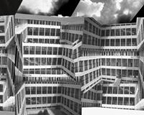
Transcending the Sensory Perceptible
INFRActures is an exhibition project transcending the sensory perceptible at the convergences of sound art and architecture. Artists Edwin van der Heide, Cevdet Erek, mxHz.org and STEALTH.[u]ltd have been commissioned to create four new works which make tangible what is not registered by our senses within an urban environment, such as ultra- and infra-sonics, and different perceptions of time and spatiality. Cities as Rotterdam and Istanbul make up the source material and points of departure for the installations, which are interactive in character and allow for a participative and layered audiovisual experience.
* Edwin van der Heide: Sound/Light/Street * STEALTH.[u]ltd: Street/Appropriation/Struggle * Cevdet Erek: Avluda | In The Courtyard * mxHz.org: TICS [THIS INAUDIBLE CITY SOUNDS: Reading through Pamuk's Istanbul]
Date: Friday 2 to Sunday 18 December 2005
Curator: Nat Muller in collaboration with Stephen Kovats
INFRActures has been made possible with the support of ThuisKopie Fonds, Stichting Cultuurfonds van de Bank Nederlandse Gemeenten, VSBfonds and Prins Bernhard Cultuurfonds Rotterdam.
TANGENT_FRACTURE (INFRActures vernissage)
Date: Thursday 1 December 2005, 17:00-19:30 hrs
Location: V2_, Eendrachtsstraat 10, Rotterdam
Admission: free
The exhibition is inaugurated by an opening intervention of artist and architect Kyong Park, and framed by two live sound performances of sound artist Cevdet Erek and media artist mxHz.org, taking you beyond the boundaries of the audible. The INFRActures vernissage is the first in V2_'s new series of monthly TANGENTS live and interactive streamed events.
laurie halsey brown: beingthere.v2.r'dam.05
Date: Sunday 18 December 2005, 15:00-17:00 hrs
Location: V2_, Eendrachtsstraat 10, Rotterdam
Admission: 5 euro (seating limited!)
Many Rotterdam architects tend to leave the city due to a shortage of local projects. Rotterdam profiles itself as a city of architecture but how does this image chime with everyday reality? Artist laurie halsey brown organizes during the finissage weekend of INFRActures a bus tour through the city that includes an onboard experimental documentary of local architects discussing the validity of the city’s slogan “The City of Architecture”, with stops at several sites built by local architects and access to a public intervention project placed throughout the city. The tour begins and ends at V2_
V2_, Institute for the Unstable Media
Eendrachtsstraat 10, NL-3012 XL Rotterdam
PO Box 19049, NL-3001 BA Rotterdam, NL
Tel + 31 10 206 72 72 | Fax + 31 10 206 72 71
E-mail info AT v2.nl
Posted by jo at 10:07 AM | Comments (0)
MTAA
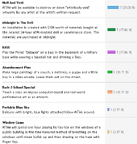
10 Pre-Rejected, Pre-Approved Performances
MTAA's 10 Pre-Rejected, Pre-Approved Performances: a list of performance-based artworks that have been rejected by curators at various venues worldwide. An on-line vote via the MTAA website will determine which performance will be created. Documentation of the performance and voting process is shown as the final work.
10 Pre-Rejected, Pre-Approved Performances ill be included in ARTISTS SPACE: Empty Space with Exciting Events Performance in conjunction with Performa05, December 13 - December 17, 2005. On-line voting starts November 8, 2005 and ends November 22, 2005.
Posted by jo at 08:23 AM | Comments (0)
ORTPLAY@ORT
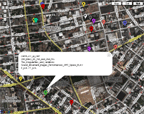
Can I order my eggplant?
ORTPLAY@ORT (330 Ellery St., 1st + 2nd Floors), as a part of BAP (Bushwick Art Projects)--Sat. Nov. 12, 2005, approximately 4 - 11 p.m.
music and sound, installed, performs. dance improvises. space gets invested. a climate occurs. text is produced and pronounced. projects on screen, an instigation, an animation, fashion. play. two floors, a rooftop, nesting spaces like Russian dolls unfold against and into each other. live. work. play.
o.blaat (Keiko Uenishi) premiers a new region-specific installation/live performance, 'Can I order my eggplant?' (berenjena). She will explore Chinese take-out restaurants on her bike in her Bushwick neighbourhood, desperately looking for her favorite 'eggplant'!
join our txtmob! if you have a mobile phone which can receive text messages, you can get instant updates & secrets from ORTPLAY throughout its performance/salon hours.
Posted by jo at 08:05 AM | Comments (0)
Owning netart for free
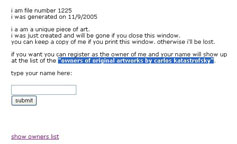
Go for the original, not the copies
The dichotomy between an original (authentic) work of art and its copies isn't a new one. Walter Benjamin adressed it a long time ago and stated that the work's aura (its distinctive characteristic) gets lost when technically reproducing it. This discussion became a bit obsolete when digital culture (and its artifacts) became common in our contemporary world. When looking at a net art piece, how can you conceptualize an original (and its copies) when the work is online, accessible to everyone at the same time? Ubiquity doesn't go along with unicity, at least not at a first glance.
This debate has become old, so much has been said and written around the lost of "the original" (its death by means of the digital) that nobody is interested in it lately. Benjamin couldn't expect this turn of events, but we solved the problem. No original, no copies, just information accessible to everyone.
But what if someone wanted to subvert this status quo? What if an artist missed a time when a work of art was a unique object that one could own? That is what Carlos Katastrofsky's "the original" is all about. This netart project allows you to be the owner of a unique (one of a kind) netart piece. The confusion arises. How can one be the owner (in the traditional sense) of netart? The truth is one can´t and in this lies the interest of "the original". Katastrofsky allows you to be the owner of a unique, numbered, but not signed (the irony continues...) work of art; of something that isn't an object and that will disapear from your screen as soon as you close the window. Your original work of art will forever be gone and the only memory of it will be a print (if you decided to take the artist's advice and print it) and your name in a list of "owners of original artworks by carlos katastrofsky".
This is an extremely ironic project. It allows you to traditionally own a net art piece, own it like any objectual art piece. But the irony lies in the fact it isn't an object, and what you can own is nothing more than a copy (a print out) of that non existing object, another irony (what is a copy of a net art piece?)... In the end there is nothing of an object here, just a process, a set of rules that leads you to the point of questioning unicity, ownership and the object-like nature of a digital art work.
The Original
2005
Carlos Katastrofsky
http://aqua.subnet.at/carlos/projekte/netart/original/
Posted by luis at 06:00 AM | Comments (0)
November 08, 2005
The Kitchen
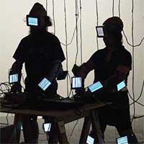
Transparent Processes + Listen up!
November 9, 8pm @ The Kitchen, NYC; Curated by Nick Hallett: This evening of live visual music, expanded cinema, and nouveau psychedelia features work in which sound and image stem from the same source. Performers include Ray Sweeten and the collaborative groups LoVid (Tali Hinkis and Kyle Lapidus), I Love You (Seth Kirby and Ana Matronic) and the duo of Sandra Gibson and Luis Recoder. Avoiding digital technology, these artists create synesthetic lightshow environments by means of antique equipment, consumer electronics, and home-made instruments in ways that make evident the relationship between process and result.
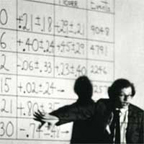
Listen up! Lecture as Performance: Coco Fusco and Bernar Venet; November 18 (Fri) 7pm @ The Kitchen, NYC; Curated by PERFORMA. Presented as part of the PERFORMA 05 Biennial--Since the artist Filippo Tomaso Marinetti created his Futurist “serate” in 1909, in which he ‘declaimed’ the Futurist manifesto, many artists have used the lecture format as a staging device to communicate radical ideas about art and politics directly to audiences. In Listen up! Lecture as Performance, PERFORMA responds to the widespread contemporary interest in transforming the lecture form into performance.
In addition to recreating a live conceptual art performance by Bernar Venet from 1968, and presenting a new work by Coco Fusco from 2005, the evening presents documentation of art historical precedents to the use of the lecture as performance by artists including Joseph Beuys, FT Marinetti, and Kurt Schwitters.
Venet’s Neutron emission from muon capture in Ca40, which was first presented at The Judson Church Theater in New York in 1968, will be re-worked as Astrophysics with High Energy Light. Coco Fusco’s A Room of One’s Own (2005) is a remarkable window onto the process of special training sessions for women to learn interrogation techniques. Bush’s ‘War on Terror’ leads Fusco to a training camp where she and five women undergo a course in interrogation, conducted by former U.S. military officers.
Posted by jo at 06:02 PM | Comments (0)
DOUBLE VISION:

Evolutionary Patterns & the Lonely Owl (Mutation #1)
DOUBLE VISION presents Evolutionary Patterns and the Lonely Owl (Mutation #1)--When: November 19 [Sat] 7:30PM (doors close at 8:15PM); Cost: 5-10$ suggested donation; Where: MadHorse Loft, 2200 Adeline St. (Ste. 125), Oakland, CA 94607; Info: 510-535-2504.
Bay Area intermedia performance group DOUBLE VISION is presenting an evening of mutating dance, music, video, and installation. Audience members transmit genetic codes, play cryptic games, and witness the 21st Century debacle of the wise and mysterious owl. Interactive technology and old school human bodies fill in the void between neuron and neurosis. Come play!
Cast of artists include: Claire Barratt / Cilla Vee, Sean Clute, Amanda Crawford, Nick Fox-Gieg, Simran Gleason, Jessica Gomula, Dave Holton, Pauline Jennings, Jason B. Jones, Chris Kruzic, Geoff Kuffner, Amy Leonards, Amy Lewis, Peter Matthews, miss gawker & the tweeker, Amy Nielson, Patricia Svilik, Tim Thompson, Nicole Zvarik.
DOUBLE VISION is an intermedia collective of performers, musicians, dancers, and video-artists. Together, our group creates immersive environments utilizing unconventional spaces and transforms conventional spaces through unconventional means. By experimenting with different methods of collaboration through the adaptation of social systems, transvergence of scientific models, and mapping of algorithmic structures, DOUBLE VISION unifies multifaceted art forms and ideas.
DOUBLE VISION was formed in December, 2003 by Sean Clute and Pauline Jennings as an means to work with others interested in questioning and altering the landscape of dance, music and video. Their first major collaboration came in the form of Involution 2, a cross-country, NY and CA event held at 23 Windowz, Brooklyn, NY. Their interactive dance and animation work Disembodied Head has been performed at the Mills College Signal Flow Festival, WORKS/San Jose, SPARK (KQED), and will be televised on Meaning in the 21st Century, a national PBS broadcast. DOUBLE VISION commonly collaborates with other performers in and outside of the Bay Area, including video artist, Nick Fox-Gieg (LA), Lux (Amoeba Technology, NY), and Zemi-17 (Bali).
During its brief existence, DOUBLE VISION has curated and performed pieces in New York, Los Angeles, Oakland, San Francisco, Albuquerque, and the WWW.
Posted by jo at 05:08 PM | Comments (0)
HER NOISE
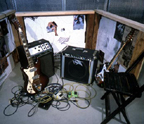
Sounds Investigate, Inspire, Uncover
Her Noise is an exhibition featuring five newly commissioned works by international artists whose practice shares the use of sound as a medium to investigate social relations, inspire action or uncover hidden soundscapes. New works by Kim Gordon with Jutta Koether; Emma Hedditch; Christina Kubisch; Kaffe Matthews and Hayley Newman all involve high levels of participation and are set in motion only when used by visitors or performers forming a base for events, live music and performances. [review]
In Reverse Karaoke [AuToMaTiC mUsIc TeNt] Kim Gordon and Jutta Koether aim to demystify the process of music making by creating a space in which audience members can record a track along with the pre-recorded sample of Gordon’s voice. The installation doubles as a performance space for a series of performances including Jenny Hoyston (Erase Errata), Heather Leigh Murray, Christina Carter, Ana Da Silva (The Raincoats).
In her installation Mini Flux Hayley Newman reproduces, in miniature, over a thousand objects used in the Sixties Fluxus movement's musical scores. The installation becomes a score in itself through Newman's invitation to guest artists to devise performances using the objects. Guest artists include The Bowman Brothers, Gluzberg and Bruce Gilbert.
Christina Kubisch has for many years been developing electrical walks which make audible the otherwise undetectable sound waves generated by the electromagnetic signals that surround us. Visitors are invited to navigate Kubisch’s maze of wires at South London Gallery, containing sounds from city walks using the specially designed headphones. Across town, visitors can pick up the headphones from the Goethe Institute to discover the hidden soundscape of the area according to Kubisch’s map.
In We’re Alive, Let’s Meet Emma Hedditch sets up a series of get togethers that will take the form of weekly meetings, workshops and talks with guests including film maker Vivienne Dick, Tobi Vail and Alison Wolfe (of riot grrrl bands: Bikini Kill and Bratmobile).
Hedditch has also collaborated with the show’s curators on the Her Noise Archive which combines a research area, listening posts and a viewing space filled with documentation of both historical and contemporary luminaries working in the field of sound installation and performance. The space contains books, fanzines, records, catalogues as well as exclusive on camera interviews and concert footage with artists including Pauline Oliveros, Maryanne Amacher, Diamanda Galas, Marina Rosenfeld, Thurston Moore, Kevin Blechdom, Kembra Pfahler, Kim Gordon, Lydia Lunch, Peaches and many others filmed in the process of developing Her Noise and aimed at forming a research archive which will become publicly accessible in London after the end of the Her Noise tour.
While lying on Kaffe Matthews Sonic Bed Laboratory the visitor becomes physically affected by a spectrum of sound vibrations shifting underneath and around as they lie. The 12 channel sound system immersed in the bed plays a specially constructed sound work, vibrating through and moving around the visitor. Sonic Bed Laboratory plays music to feel rather than just listen to.
This exhibition is the largest component of a HER NOISE programme of installations, events, performances and screenings by a wide network of artists whose practice involves the use of sound as a medium.
Curated by Lina Dzuverovic and Anne Hilde Neset, Electra
10 NOV – 18 DEC 2005
South London Gallery
65 Peckham Road
London SE5 8UH
Tel: 020 7703 6120
EXHIBITION CATALOGUE
Her Noise catalogue published by Forma,
Editors: Lina Dzuverovic & Anne Hilde Neset
Artists: Kim Gordon & Jutta Koether, Emma Hedditch, Christina Kubisch, Kaffe Matthews, Hayley Newman, Marina Rosenfeld
Contributors: Jan Avgikos, Christoph Cox, Drew Daniel, Anna Dezeuze, Louise Gray, Alan Licht, Thurston Moore, Rob Young
This catalogue forms an invaluable resource, highlighting the often overlooked contribution of women artists to the development of genres as disparate as Fluxus, performance art, punk and sound based installation. Through a wealth of images, essays and interviews the catalogue explores how the energy of independent music communities and open-access composing techniques can reinvigorate the exhibition environment.
All texts in English / 230mm °— 170mm, 68 pages, soft cover, illustrated colour throughout. ISBN: 0-9548288-1-X
Distributed by Cornerhouse Publications
Published by Forma forma.org.uk
South London Gallery
65 Peckham Road
London SE5 8UH
http://www.southlondongallery.org
Tel: 020 7703 6120
Her Noise is curated by Lina Dzuverovic and Anne Hilde Neset and produced by Electra (http://www.electra-productions.com) in association with Forma (http://www.forma.org.uk). The project is funded by Arts Council England, PRSF, The Henry Moore Foundation, The Elephant Trust, Women In Music, Feminist Review Trust with additional support from The Goethe Institute and Tate Modern. Media partner: The Wire Magazine.
Posted by jo at 09:35 AM | Comments (0)
Technologized Bodies/Embodied Technologies
![]()
LEF + Art Interactive/CAA06
CALL FOR PARTICIPATION: JANUARY 1, 2006 DEADLINE; BOSTON CAA CONFERENCE at ART INTERACTIVE GALLERY; co-curated by Legier Biederman and Dave Burns.
Works on video that convey and/or solicit embodied subjects and/or embodied responses, and thus potentially rupture and/or problematize the notion that acts of viewing cohere us as the discrete and transcendent origins of vision and knowledge.
As the speed and intensity of technologically mediated modes of being have accelerated in recent years, technology not only has transformed our ways of doing things, it has conditioned our experience of ourselves and our relationship with others profoundly. It has transformed the attitudes and practices of creative expression as well as the criteria we utilize to evaluate art and media. Questions that arise: What are the specific intersections among visuality, embodiment, and the technological in the history of Western Art? What place do artists' or art viewers' bodies have in the violently revised nexuses of power relations that arise with shifts in technological processes of imaging, communicating, creating, identifying, and knowing?
How do artists perform their embodiment as resolutely technologized--technologized in such a way that their flesh (or the flesh of the bodies of knowledge conveyed or solicited) takes its texture and materiality from that of the screen/projection? How might the performance of technologized embodiment take its depth from the profundity suggested by the puncture-wound opening of the screen/projection in the dark space of the gallery?
So, in contrast to theories of new media or interpretations of technologies that insist on the obsolescence of the body--its replacement with the pure information of digital screens or digital codes activated on these screens--how do experimental media works explore bodies for their capacity to activate rather than suppress the object or subject produced/reproduced? When considering "bodies" in this context, why is the physical human body always referred to as the ideal example? Cannot a body potentially refer to any vessel of knowledge or ideas and languages constrained by, often superficially, designed parameters? This exhibition will attempt to rethink bodies (human and inhuman bodies, bodies of knowledge, of thought, of discourse, or history, etc) and technology (the tools used to make or do or practice, but also recalling the Greek techne, the acts themselves) in the widest sense of the terms: "Technologized Bodies/Embodied Technology" is a direct call to bodies--somebody, any body.
LEF is a working group of artists, scientists, engineers, scholars, educators and students that belong to the Leonardo Network. LEF develops joint actions between Leonardo and other scholarly organizations, including CAA, and promotes the work of artists and art historians in the art-science and art-technology interdisciplinary fields.
Send to:
LEF Exhibition/CAA 2006
Legier Biederman
1021 York St
San Francisco, 94110
Any Questions? Contact:
Legier Biederman, bieder[at]humnet.ucla.edu
Dave Burns, pixelate[at]pacbell.net
Posted by jo at 09:12 AM | Comments (0)
digital rattles

sound/image=binary algorithms
digital rattles covers works from south american artists -an argentinean, member of the brazilian group influenza and a colombian resident in spain and a spaniard who belongs to the london group ix software. they all coincide in one thing, developing what it is now called soundtoys, which are, plainly speaking, sound and visual based objects for navigators to play with. it could be said that they are sound games, but the suggestive word 'rattle' would describe it even
better.
the digital rattle is a tool that shows very clearly how pointless it is to differentiate between sounds or images that are codified. both are represented by binary algorithms, a single line of ones and zeros. this shared identity and its impossible separation, allows artists to work with images and/or sounds. in fact some modern sound editors (and here i mean the software) have a strong visual content which facilitates professional and amateur composers with little computer knowledge, edit music without problems. it is the undefined nature of the binary sequences that makes all this possible. their design may switch on sounds, static or moving images or even the introduction of this catalogue.
in this sense, the sound-games are very interesting digital objects. they show the hybrid nature of the internet's art -and in the same way code.art. they prove that its crossbred condition can result in anything. with the digital rattles, particularly, the player stops being a mere navigator to become a modest composer of small ephemeral sound pieces.
a sample of the developments in web.art or software.art can be found in this exhibition. digital rattles can be executed without actually being connected to the net as in the case of lore (transformation l) by enrike hurtado and pegajoso by santiago ortiz.
with map by rafael marchetti, produced for influenza, has been developed under the metaphorical idea of simulating the surfing of the net to a fly over a topographic plane with several stops. the user may choose to land on a station and move a rattle, or continue flying over the surface in a way that depending on whether it is touched or not, sounds or not. moved by the desire to reach port it may stop and in doing so, fill the journey with a background rattling. thus, one produces a double enjoyment, landing and flying.
pegajoso by santiago ortiz reproduces a small rattle that turns on itself automatically but allows user interaction by a simple movement of the mouse. just like baby rattles themselves, pegajoso doesn't require much talent, and it can be handled by anyone. in this case, a nucleus is moving around a cube blindly with no reference, generating sound by simply crashing against the frame.
enrike hurtado together with ixi software, shows a work without internet connection, lore (transformation l) easy to navigate. it maintains a constant background hum that the prosumer -the consumer who thinks of himself as a semi-professional- can modify easily by selecting other frequencies on the computer screen. far off from other works, much closer to the logical editing of sound and its results, lore avoids altogether the hurdle of recording the user's composition, sticks itself to the making of sounds. anyone with a certain air of permanence but with a ephemeral spirit will enjoy it.
an exhibition that hopes to incite the game of sound editing, through visual interfaces that can be tickled by anyone.
artworks by enrike hurtado, rafael marchetti and santiago ortiz; curated by nilo casares; technical assistance-fotonoviembre 2005; organizing-fotonoviembre 2005; catalog text-nilo casares.
opening::[20h00m/08.11.2005] schedule::[08.11.2005)(15.12.2005] monday till friday::[11h00m a 13h00m)(18h00m a 21h00m] saturday::[11h00m a 13h00m)(18h00m a 20h00m].
place::círculo de bellas artes, de santa cruz de tenerife, castillo::45.34 922246496
rafael marchetti studied fine arts in buenos aires and has been studying programming since 1989 and web design since 1996. he has gained the third prize in the digital art category for the sergio motta cultural award at sao paulo, brazil and first prize in the sculpture category at the 3rd salon in buenos aires, argentina. in 2001 raquel rennó and rafael marchetti started their art experimentation and research on the digital medium called 'influenza', whose works were exhibited in galleries and art festivals throughout south america and europe influenza's last work, non_sensor was developed in 2004/2005 with the help of unesco and the institute cyprès-pratiques artistiques and sciences cognitives, run by professor louis bec.
santiago ortiz is an artist, mathematician and researcher for arts, science and space representation. he explores the building of common spaces for the different areas of knowledge. he also handles communication techniques, creativity, expression and representation where it is combined narrative and literature, digital space, space in architecture and expository space. he runs seminars and workshops in spain, portugal and south america. co-founder of blank, an art and digital culture magazine. it is part of the research and development team of medialabmadrid. he lives and works in cabo verde and madrid.
enrike hurtado mendieta: since 2001, enrike hurtado mendieta and thor magnusson have worked on ixi, an independent research project that explores the new ways of interacting with experimental electronic music. ixi has focused his research mainly on the development of music software and physical interfaces. the project has received some awards and has been apart of international festivals and conferences. the project's results can be found in their software package which can be down loaded completely free from their web and also in their teaching and personal work.
Posted by jo at 08:55 AM | Comments (0)
Ultrasound 2005
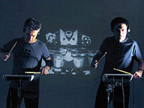
UK | Finnish Partition
Mon 21 - Sat 26 Nov 2005, The Media Centre and Bates Mill, Huddersfield, England. Ultrasound 2005 presents a diverse programme of live performances, installations, workshop and talks by UK and international artists working in new interdisciplinary ways across the interrelated fields of new media, contemporary electronic music, software production, new technologies and audiovisual performance.
We are pleased to announce the 'Finnish Partition' of the festival, programmed in collaboration with Helsinki based artist, organiser and curator Juha Huuskonen. The 'Finnish Partition' represents a cross-section of the new and emerging creative talent practising media arts in Finland today, supported by established names such as Pan Sonic.
The festival takes place at The Media Centre and Bates Mill, two contrasting venues. The Media Centre is home to over 60 creative industries enterprises, while Bates Mill is a traditional Mill complex just outside Huddersfield town centre. The performances at Bates Mill are located in the old 'Blending Shed' a 5,000 sq ft industrial space.
Ultrasound Outline Programme:
Live Performances
Pan Sonic [Finland]
http://www.ultrasound.ws/pan-sonic.html
Grey Zone [Finland]
http://www.ultrasound.ws/greyzone.html
Memnon [Finland]
http://www.ultrasound.ws/memnon.html
Sue Costabile [USA]
http://www.ultrasound.ws/costabile.html
AGF [Germany]
http://www.ultrasound.ws/agf.html
Aymeric Mansoux [France]
http://www.ultrasound.ws/mansoux.html
O Samuli A [Finland]
http://www.ultrasound.ws/oa.html
Marloes de Valk [Holland]
http://www.ultrasound.ws/de-valk.html
Owl Project [UK]
http://www.ultrasound.ws/owl-project.html
Jaap Blonk [Holland]
http://www.ultrasound.ws/blonk.html
Golan Levin [USA]
http://www.ultrasound.ws/levin.html
Zachary Lieberman [USA]
http://www.ultrasound.ws/lieberman.html
The World of PIKU [Finland]
http://www.ultrasound.ws/piku.html
Pardon Kimura [Japan]
http://www.ultrasound.ws/kimura.html
The Sancho Plan [UK]
http://www.ultrasound.ws/sancho-plan.html
Installations
Scrollbars by Jan Robert Leegte and Edo Paulus [Holland]
Kick Ass Kung-Fu by Perttu Hämäläinen, Mikko Lindholm, Ari Nykänen [Finland]
Workshop
Tiletoy: A Modular Electronic Game Prototype by Tuomo Tammenpää & Daniel Blackburn [Finland/UK]
Open software/open hardware: TileToy is an open project. Both the source code and the hardware will be made available via open licenses. The aim of TileToy is not just to create something that we ourselves can use to create interesting games and demos for, but as a platform that anyone can use to create unique content. Making the software open will allow people to create their own applications and games and feed these back into the community to spark further innovation. The open hardware will also allow people to make their own TileToys cheaply without paying a third party potentially leading to new projects that branch off to make new versions of TileToy based on the original hardware.
Further additions to the programme will be announced soon. Please visit the website or sign up to the electronic mailing list.
Contact: Tel: +44 [0]870 990 5007
Email: info[at]ultrasound.ws
Posted by jo at 08:35 AM | Comments (0)
Bump
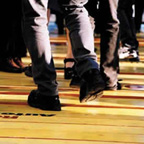
association.creation
Bump--In the project "bump", two wooden bridges in two different cities form the meeting point for large public events. When someone steps on one of these bridges, this person's weight triggers an impulse that is transmitted through a data transmission cable to the wooden bridge in the other city, thus moving the corresponding plank by a few centimeters.
A tactile interface versus the disembodiedness of network worlds.
Two bridges in public space; the inhabitants of one space cannot see the others, but they can sense them and make contact with them. The deformation of space becomes the interface. The interface is called "bump", is ready for the masses to come. Every pressure exerted causes resistance that comes through on the other side. There is a knock from underneath, the slats rise, power transmission via network - "sensations on the move".
"If you move along a city's compact walls, when you least expect it, you see a open and a different city appears. Then, an instant later, it has already vanished. Perhaps everything lies in knowing what words to speak, what actions to perform, and in what order and rhythm." (Italo Calvino)
"bump" creates a in the urban interface, a place where there is no more solid ground under your feet.
A in the urban surface.
"Now there is knocking from below and the boards rise up. Below is another city, reflecting the same irregularity, linked via data transmission line. What is going on there? Undifferentiated mass movements, a stampede of hundreds of feet at rush hour? What about late at night: two or three pairs of feet. A perceptible rhythm. Perhaps a message? Or just a game? We sense the illusion of proximity: directly below the board which raises up, we presume a force which approximates our own.
But there is only the apparatus, the pneumatic piston, the control valve, the sensor. Closeness is only an illusion; the distance is not abolished. The thin pine board is a wall hundreds of kilometers thick. A casual encounter turns into a lasting irritation of the sense of direction: west is below, below is east. How close can we get together?" (Christian Kühn)
A catwalk - 1.5 by 20 meters - is installed in the public space of each city. If a person steps onto this catwalk their weight triggers an impulse which is transferred to the other city by means of a data-line. There a pneumatic piston raises the corresponding board by a few centimeters. At the same time, the principle of the effect can be grasped through a video conference transmission - and visual contact can be made with the "other side."
How close do we wanna get today?
The free-standing bridge on the street refers to something absent: approaching one another, mutually sensing, sensuously experiencing one another. The Internet has brought us all closer together, yet with all our fascination with incorporeal, virtual space, we must not forget the quality of what is missing when we go into the Internet. The world has become larger for "bump" users. Sensing as an elemental experience gives us a feeling for distance and closeness. Collective experience is the prerequisite for common impressions and imprints in a game with an anonymous opposite. Interaction becomes communication.
Sensations on the move
"The spacelessness and the disembodiedness of the virtual world returns to the sensuous, tactile world, which means that crossing the border of an 'abstract' medium creates a new actionist reality that would be unimaginable in a reality without a virtual opposite. This enables an intensification of the perception that was previously mourned as loss. Perhaps a new medium is born with this virtu - reality? "bump" affords the 'virtual world' a new field of action and the sensuous perception of impulses from previously unimaginable networks." (Friedrich Achleitner)
An intelligent urban fixture, accessible
"The telematic arrangement of "bump" is prototypical for intelligent urban fixtures: beyond the specifically local experience in two cities, the interaction and communication of the people in both places through the telematic furnishing are the prerequisite for experiencing telematic simultaneity." (Gerfried Stocker)
The telematic bridge is imprinted with logos from companies that enable Internet communication. "bump" as an image and a part of the commercialized world in which we live, and which we cannot elude. "bump" as a furnishing of a city that you traverse. "bump" has proven itself as a transparent and functional medium. The many people who have enthusiastically stepped on it call it a sensation that awakens associations and creates connections.
bump: to hit or collide with a jolt, ~ into: fig. to meet someone unexpectedly; swelling, lump, bulge; ~ of locality: sense of direction
1998 BUMP: Opening of the Ars Electronica 99 by the mayors of Linz and Budapest on the bridge
ESTABLISHED in 1997 by: Christian Smretschnig, Michael Bieglmayer, Roland Graf, Werner Schmid.
Technical directors: Christian Troger, Elmar Trojer.
From Ars Electronica website.
Posted by jo at 08:20 AM | Comments (0)
Proximity Lab
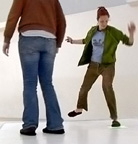
Footprints
Proximity Lab is a participatory installation and experimental interface platform designed to visualize relationships between users and mediated spaces. The 8-foot by 16-foot walkable surface is fitted with RFID technology. Participants wear shoes fitted with RFID tags, enabling the system to track and record their positions in real-time. Images projected directly onto the floor are accompanied by stereo sound as a continuous response to the actions and interactions of participants.
Proximity Lab can discern the individual identities of participants regardless of how or where they move. Conceived as an experimental physical interface system, it allows architects with diverse intentions and aesthetic goals to create repeatable experiments in physical interaction. By Evan Karatzas. [blogged by Regine on we-make-money-not]
Posted by jo at 08:15 AM | Comments (0)
November 07, 2005
The Musical Gestures Toolbox
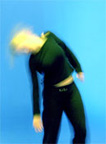
Bodily Movement and the Music Theory Paradigm
The University of Oslo Department of Musicology is developing the Musical Gestures Toolbox, a collection of applications with useful features for video and audio analysis. The toolbox is built with Max/MSP/Jitter from Cycling '74, and will be available as standalone applications for Mac OS X and Windows, as well as the original patches.
Features: * Video capturing from USB/FW-cameras * Playback of video files (any QuickTime-readable format) * Adjustable resolution and playback rate * Brightness, contrast, saturation controls * Zoom, offset and displacement controls * Cropping functions (drag and crop) * Automatic cropping based on contraction * Computer vision analysis * Save snapshots and image sequences * Save video from the analysis * Contraction and centre of gravity * Audio analysis: spectrogram, sonogram, spectral centroid, noisiness, loudness...
"...there are many different kinds of gestures associated with music, but it could be useful to consider gestures in view of the following three main categories:
* Sound-producing gestures, such as hitting, stroking, bowing, blowing, singing, kicking, etc. Mental images of such gestures, including the associated modes of execution such as fast, slow, hard, soft, short, long, etc., are usually indissociable from our notions of musical sound, evident in music-related metaphors (e.g. "hammering", "sweeping", "caressing", etc.) and mimicry (e.g. playing "air drums" or "air guitar").
* Sound-accompanying gestures, including all kinds of movements we can make to music such as marching, dancing, and more vague sound-tracing gestures such as following the melodic contours, rhythmical/textural patterns, timbral or dynamical evolutions, etc. with our hands, arms, torso, etc.
* Amodal, affective or emotive gestures, including all the movements and/or mental images of movements associated with more global sensations of the music, such as images of effort, velocity, impatience, unrest, calm, balance, elation, anger, etc., gestural images and concepts which are also encountered in dance.
These categories of gestures often overlap, and a gesture may belong to more than one category, e.g. energetic drumming may be perceived both as sound-producing gestures and as emotive images of joy or elation. Musical gestures thus encompass a large territory stretching from details of sound-production to more global emotive and aesthetic images of music, and also include considerations of cultural-stylistic vs. more universal modes of expression. In all cases, we believe musical gestures manifest the primordial role of human movement in music. For this reason, we speak of embodied perception and cognition in music in the sense that we as listeners relate musical sound to mental images of gestures, i.e. that listening (or even merely imagining music) also is a process of incessant mental re-enactment of musical gestures.
We believe the idea of embodied perception and cognition could represent a change of paradigm in music theory and other music related research, research which has often tended to exclude considerations of bodily movement from its conceptual apparatus in favour of focus on more abstract, notation-based elements of music. In our project, the focus on musical gestures provides us with a coherent and unifying perspective for what we see as a much needed renewal of music theory and other music research. Fortunately, recent developments within the cognitive sciences, music technology, and technologies for capturing and representing gestural data, converge to give us very favourable circumstances for this shift of focus towards musical gestures."
Posted by jo at 11:54 AM | Comments (0)
Virtual Marathon
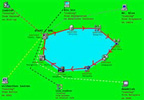
Run the Internet
Virtual Marathon is a game designed to let the players gain a new perspective of the Internet. The players become ‘virtual runners’ and run through different game servers hosted physically around the world. Through the course of running, the players running speed changes with the different servers. The players feel their (physical) relationship with the different web servers. Location becomes apparent, instead of being flat and smooth, Internet becomes a textured space.
As in a real race, you will get to train and then compete against the other players. However, for those who are not up to it, an option allows players to 'run' at leisure and enjoy the view along the way...This work is an experiment in blurring the boundaries between games, sports, and technology. Videos. [blogged by Regine on we-make-money-not]
Posted by jo at 11:07 AM | Comments (0)
eMoto

Expressing Emotions in a Digital World
eMoto is a mobile messaging service for sending and receiving affective messages. The application extends on both the input and output channels when sending text messages between mobile phones. The aim is to convey more of the emotional content through the very narrow channel that a text message otherwise provides. Emotional communication between people meeting physically in the "real world" make use of many different channels, such as facial expression, body posture, gestures, or tone of voice, little of this physicality of emotions is used in a similar digital context. In eMoto users therefore use affective gestures to convey the emotional content of their messages which are then translated and communicated in colors, shapes and animations.
eMoto is a joint project between SICS, The Swedish Insitute of Computer Science and Stockolm University/KTH. The design team includes: Petra Sundström, Anna Ståhl, and Kristina Höök. [via information aesthetics]
Posted by jo at 10:51 AM | Comments (0)
Mice squeak into song
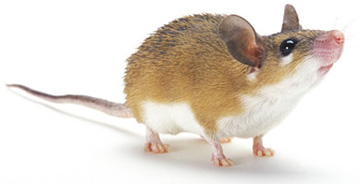
© 2005 Nature Publishing Group
Male mice produce songs to woo their mates that are too high-pitched for humans to hear. Click here to listen to mouse vocalizations processed by computers into an audible range for people. Read article here.
Posted by jo at 09:20 AM | Comments (0)
CALL FOR APPLICATIONS
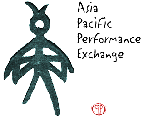
Video-Perfomance Summer Residency at UCLA
CALL FOR APPLICATIONS! ASIA PACIFIC PERFORMANCE EXCHANGE PROGRAM [APPEX] 2006--UCLA Center for Intercultural Performance (CIP), Department of World Arts and Cultures (WAC); July to August 2006 - Los Angeles; Deadline for submissions: November 10, 2005.
The Asia Pacific Performance Exchange (APPEX) is an international artists residency program that promotes cross-cultural dialogue and interdisciplinary exploration; develops rigorous strategies for art making that reflect the nuances of cultural differences; and fosters new ways to create, combine, and interpret artistic expressions. THE PROGRAM APPEX is a six-week intensive residency. For five days a week, artists will engage in all-day master classes, studio workshops, experimentation, and collaborative projects. On weekends and evenings, participants will be introduced to the vibrant arts and culture context of the host city through specially planned field trips and concerts. Each Fellow will be provided with travel expenses, shared accommodations, and meals for the duration of the residency.
WHO SHOULD APPLY Traditional and contemporary performing artists from Asia and the United States are invited to apply. Special care will be given in the selection process to ensure a balance across disciplines. Artists who are active in the community as educators, artistic directors, and cultural workers are encouraged to apply. APPEX 2006 is made possible by a grant from the U.S. Department of State Bureau of Educational and Cultural Affairs, and the Ford Foundation.
UCLA CENTER FOR INTERCULTURAL PERFORMANCE (CIP), Department of World Arts and Cultures (WAC), Glorya Kaufman Hall 120 Westwood Plaza, Ste 188 Los Angeles, CA 90095 ph: 1-310-206-1335; fax: 1-310-825-5152 cip[at]arts.ucla.edu.
Posted by jo at 08:59 AM | Comments (0)
DiY SURVIVAL HANDBOOK

Do It Yourself Survival
Do it yourself survival is a collection of essays, tips and case studies collated from an online call for participation by C6. The eclectic mix presented within these pages shows the breadth and current diversity of art/activism practice today from around the world. Whether that is creating wireless networks, pissing on national monuments or building cardboard friends, it is certain that these submissions show that practitioners are taking their work to new spaces and audiences, redefining, through the engagement with the community, what we have considered to be ‘art’.
Have you ever wanted to stop annoying mobile phone conversations encroaching on your space? Or to learn how to turn discarded computers into a running network? Or to set up your own street television? Or even how to discover how to fund your art projects with unheard of strategies? Now you have the chance to learn how!
DiY SURVIVAL is a compilation of cutting edge strategies, methods and techniques of DIY art, delivering a wide range of practices, actions, events, enterprises and issues which all have to do with the art of DIY, with forms of media subversion and the intelligent sabotage of cultural markets.
DiY SURVIVAL HANDBOOK delivers a mix of Theory, Case Studies and "How To..." whose aim is to circulate radical knowledge, to disseminate practical know-hows and to promote collective awareness against the ego-trip of The Artist.
Among the topics: pissing on monument as form of urban intervention; how to create a wireless node; mobile art gallery; Strategies of audience engagement; techniques of mobile phones hijacking; the creation of subversion in the supermarket; brandalism and street art; Trashware; street Television; collaboration as art practice, plus essays on avant gardes, Media Pop Art, net art, the hyperconnected multitude, teaching cultural activism and much more.
DIY SURVIVAL, a snapshot of the DIY art slash activism field, an instant book which photographs individual and collective realities involved in redesigning the tactics of DIY art around the globe.
Contributors:
Anna Banana, bluloop, bravenewbrum, Gordon Brown, C6, Ruth Catlow, CCTV Nuts, Hernani Dimantas, Eric Doeringer, Ryan Griffis, The Institute for Infinitely Small Things, International Union of Free-Thinkers, HACKLAB_pg, Tsila Hassine, Amanda Janis, Loca, Luna Nera, Motherboard, Nonna Papera, Gabor Papp & Ricardo Contreras, Robert Praxmarer, Leonardo Ramos, slavina feat ctrl C+ ctrl V, Truck art, The vacuum cleaner, Marcus Verhagen, Ricardo Miranda Zuñiga
Printed on Demand by www.lightningsource.com in the Uk and USA. [via netbehaviour]
Posted by jo at 08:45 AM | Comments (0)
Flock Browser
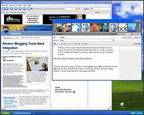
This Browser Promotes Creativity
"Web browsing used to be mostly about just that: Surfing site after site for information and goods. But lately, more people are using the Internet as much to produce and share things as to consume them. A new browser called Flock seeks to address the new reality of enhanced online creativity and community.
It's a souped-up version of the Mozilla Foundation's Firefox browser, with features added to help users create Web journal entries and share favorite Web sites. Although Flock is still in an early preview mode, meaning it is crash-prone among other problems, it offers a good sense of what to expect." From REVIEW: Flock Browser Promotes Creation by ANICK JESDANUN, seattlepi.com. Also Super 'Firefox' previewed: What the Flock? by Nick Farrell, Inquirer. [via netbehaviour]
Posted by jo at 08:40 AM | Comments (0)
November 04, 2005
Two-Legged Molecule
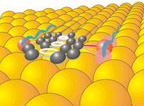
Molecule Walks This Way
"Armies of the molecular walkers could be used to store large amounts of data in relatively small spaces or to do blazingly fast abacus-style computation."
Scientists making molecular-scale mechanical devices have been mining the past for ideas. This makes sense because things move much faster at the molecular scale. The enhanced speed opens up new possibilities for mechanical computation devices like the ancient abacus.
Researchers from the University of California at Riverside and Kansas State University have created a two-legged molecule that can walk in a straight line on a flat copper surface without a track.
The structure of the molecule ensures that only one leg at a time is in contact with a surface, and as the leading leg lands the trailing leg lifts from the surface and swings forward. Copper is a crystal, and a copper surface has three directions of symmetry, or orientations where copper atoms line up. Energy supplied by a heat source or a nudge from microscope probe starts the molecular walker (representing an abacus bead), which then follows one of these directions of symmetry (representing an abacus line).
Armies of the molecular walkers could be used to store large amounts of data in relatively small spaces or to do blazingly fast abacus-style computation.
(Unidirectional Adsorbate Motion on a High-Symmetry Surface: "Walking" Molecules Can Stay the Course, Physical Review Letters, October 14, 2005) [via Technology Research News]
Posted by jo at 03:45 PM | Comments (0)
Arch-OS
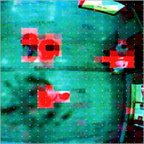
Software for Buildings
Arch-OS constructs a virtual architecture from the activities that take place within the Portland Square Development (Plymouth, UK). This "software for buildings" has been developed to manifest the life of a building and provide artists, engineers and scientists with a tool for developing transdisciplinary work and public art. Embedded technologies capture audio-visual and raw digital data from the building through: • the Building Energy Management System (BEMS) • computer and communications networks • the flow of people and social interactions • ambient noise levels.
This data is then manipulated (using computer simulation, visualisation and audio technologies) and replayed through projection systems incorporated into the architecture and broadcast using streaming internet technologies. Developed by the Institute of Digital Art & Technology. [blogged by Regine on we-make-money-not]
Posted by jo at 11:35 AM | Comments (0)
The Air Around
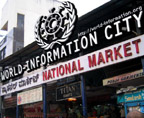
Invitation to Air Your Voice
Rajivan.Ayyappan invites you to contribute to his sound installation--The Air Around--from your geographical location.
"The Air Around is a radio/telephonic installation. It's made of an FM network that receives sounds through telephones—mobile, landline or internet phones—from around the world and integrates them into a soundscape. The installation has a central computer with a list of participants and their phone numbers. It would dial a number, remain open to engage the participant, hang up after a period of time, start another number and so on. These interactions would be transmitted to the The Air Around installation site.
The central theme of The Air Around is this: Access a whole lot of people who are in different locations and time zones through the internet and integrate them, live, into the new context of a synthesized soundscape installation. Our plan is to have a list where as many people are ready to take the call.
Therefore I want you to be in The Air Around's list to receive a call from the installation. What I would like to have from you is a 30 sec to 3 or 4 minutes of sound event that are voiced, played back or performed online by you. There are no rules for what you must do. Strictly no rules. You can just pick up the phone, identify your number or name and behave as if you have a microphone in hand. Your interaction with the call will be one of the sound events in the installation. It will be transmitted at The Air Around site.
The Air Around installation will be active for 3 days, 3:00pm to 6:00pm (India. Standard time zone: UTC/GMT +5:30 hours) starting 14th November and ending on 16th November 2005.
If you are keen tell us the dates & times when it would be possible to call you. The call will be made from the installation, to your land line or mobile. You will not be charged with any phone call rates. It will be paid by The Air Around project. Please mail me for clarifications and planning. I could send you more details regarding the procedure. Love to hear from you." Rajivan.Ayyappan rajivansa[at]hotmail.com
The installation is a part of World-Information City conference, organised by Waag Society (Amsterdam), Institute for New Culture Technologies (Vienna), Sarai CSDS (Delhi), Mahiti and Alternative Law Forum (Bangalore). [Related]
Posted by jo at 10:27 AM | Comments (0)
xxxxx
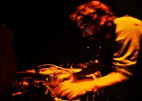
Atomic Culture Within Radically Externalised Computation
xxxxx call for papers, texts and spoken word recordings expanding the thematics of xxxxx and extending towards the performative; xxxxx call for related demonstrations and screening material such as documentation or short film/video; xxxxx call for live audio performance; xxxxx call for actions, outdoor events, workshops.
xxxxx will exercise rigorous development of the concerns of the post_crash event [London 2005] centering on speech, screening and audio performance at the ICA London and with related subevents in East London during March 2006.
xxxxx exposes a radical new space for software/computation and examines links to theories of endodata, holographic programming and auto-destructive art by way of the absolute destruction embedded within the history of computation, and furthers the expansive address of computation to the current universe; atomic culture within radically externalised computation, outside the observed system.
Papers will broach performance issues with finegrained input from participants. Performances will advance the collision of theory with practice within a third delineated space, again with an emphasis on constructivist noise, audible systematics and process, destruction. Collaboration is the new order of the day with works produced by chunked interdisciplanarians.
In this instance xxxxx builds from multiple components and sources, varying modes of revelation. The format of parallel performances/presentations with screenings will disinter xxxxx's rich thematics across a range of spaces. Further exterior distributed xxxxx ad-hoc subevents [such as walks, talks, and workshops] will be programmed around the main event throughout March 2005.
xxxxx the sign of the double integral
xxxxx substance and software
xxxxx final revelations for a holographic binding OS [VALIS]
xxxxx melancholia, [auto] destruction and m
xxxxx supreme abstraction + machinic representation
xxxxx the computational revolution in art
xxxxx contemporary monadology
xxxxx the executable's song
crash the game of life and los alamos trinity site
All submissions for projects, proposals or papers should be indicated by a Uniform Resource Locator (URL) in standard protocol, emailed to xxxxx[at]1010.co.uk by 20th December 2005.
Posted by jo at 09:48 AM | Comments (0)
4Pieces for Object, Sound, Space and Body -
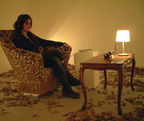
'Radio,' 'Window,' 'Metronome,' 'Darkness'
Akitsugu Maebayashi's new sound installation 4Pieces for Object, Sound, Space and Body - 'Radio,' 'Window,' 'Metronome,' 'Darkness,' is now exhibited at NTT ICC Museum in Tokyo. Looks like it's based on Radio Room (photo).
When you sit and wear a headphone in Radio Room, you start hearing sound from the radio in front of you. Then you start hearing the sound of leaves on the floor, and now you realize you are listening to the sound from the trees outside the room. The careful design of the sound space provides a unique multimodal experience...His installation is part of the exhibition called Possible Futures: Japanese Post-War Art and Technology.
Nikkei recently wrote a nice article summarizing Maebayashi's works including: Radio Room, Disclavier, Audible Distance, Sonic Interface, [I/O] white room, [I/O] warehouse, [I/O] distant place, Velocity, and Motto Darwin. If you want, check out the article to at least see various photos. [blogged by manekineko on we-make-money-not]
Posted by jo at 09:15 AM | Comments (0)
The Catalogue

People as Trackable Units
Chris Oakley's video The Catalogue deals with the retail environment, surveillance technology, RFID and data brokers, where access to consumers' data has been extended beyond our purchasing habits and lifestyle choices to the predictions of our future health prospects via analysis of the data from our weekly shop.
Utilising footage from a department store manipulated through motion tracking and screen overlays that graphically represent the goods bought, The Catalogue places the viewer into the position of a remote agency, observing humanity as a series of trackable units whose value is defined by their spending capacity and future needs. Video. First seen in February 2005 at Transmediale. [blogged by Regine on we-make-money-not]
Posted by jo at 08:00 AM | Comments (0)
November 03, 2005
On the BBC Annotatable Audio project...
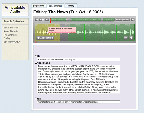
Towards User-Created Annotation and Metadata
"...The project we undertook was focused on Annotatable Audio (specifically, but not exclusively, of BBC radio programming) - and we decided to look in an unorthodox direction - towards the possibilities of user-created annotation and metadata. We decided that we wanted to develop an interface that might allow the collective articulation of what a programme or speech or piece of music was about and how it could be divided up and described. Our first ideas looked for approaches similar to del.icio.us, Flickr or our own Phonetags - which create collective value by accreting the numerous annotations that individuals make for their own purposes. But after a fascinating discussion with Jimmy Wales, we decided to think about this in a different way - in which (just like Wikipedia) individuals would overtly cooperate to create something greater and more authoritative..." From On the BBC Annotatable Audio project... by Tom Coates, plasticbag.org.
Posted by jo at 11:04 AM | Comments (0)
Jane McGonigal
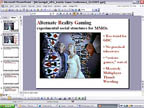
ARG Slides and Graveyard Games, NYC
Jane McGonigal recently gave a design-track lecture called Alternate Reality Gaming: Experimental Social Structures for MMOs at the Austin Game Conference. "The unofficial title of the talk was "Too weird for GDC." Also, the culmination of the talk was a lively 100-person game of massively multiplayer thumb wrestling. The slides are now posted here." [Related]
On Saturday November 5, 2005, Jane's Graveyard Games will be in New York City so you can meet the living and play with the dead. You're invited rain or shine to Brooklyn’s own Cypress Hills Cemetery to get to know your local dearly departed, pay your respects, and learn Tombstone Hold 'Em — the secret poker game you can only play in a cemetery.
Posted by jo at 10:13 AM | Comments (0)
CodeZebra: Sifting Time, Shifting Space
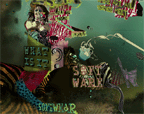
An Exhibition from the CodeZebra Archive
Code Zebra: Sifting Time, Shifting Space is an exhibition, panel discussion and fashion/costume show taking place in Toronto, Canada from November 5-26, 2006.
CodeZebra is a collaborative project led by Sara Diamond. CodeZebra draws upon debates about the relationship between art and science, the behaviors and characteristics of the inhabitants of those disciplines to create a series of provocations. CodeZebra includes spoken word and dance performances, club nights, games, workshops, and software development. In 2003 Diamond locked up pairs of artists and scientists in Habituation Cages for 24-hour periods and asked to discover new inventions, art works and concepts while real time video streams, documentary footage and online chats captured their every move. Such events and processes are captured in DVD form and on the CodeZebra website and are the core of this exhibition. CodeZebra OS software uses data visualization to provide analysis of dialogue and conversation taking place on the Internet. Responsive garments and costumes of CodeZebra bring communication, display and social camouflage back to the body. [Related]
Exhibition: November 5-26, 2005; WARC Gallery Co-presented by the Goethe-Institut, 401 Richmond St.W. Suite 122 Toronto, Ontario 416 977-0097. Presentation of Code Zebra curated by Nina Czegledy. Opening--Saturday November 5th, 5:00 pm; Artist's Walk through followed by reception.
Panel Discussion:
Saturday November 26, 3-5 pm; Goethe-Institut, Knowelt Hall, 163 King St. W. Toronto, Ontario 416 593 5257: Sara Diamond, Ontario College of Art & Design; Dr. John Dubinski, University of Toronto, Dr. Markopoulo-Kalamara, Perimeter Institute; Andy Patton, Artist; Co-moderators Sara Diamond and Nina Czegledy.
This panel of artists, scientists and curators considers the ways that current questions of space/time have opened new parameters in scientific research, visualization, popular culture and art and curatorial practice. The panellists will discuss their discoveries and reflect on the ways that art and science provides new insights into the operations of space and time whether at the universal or human scale.
Sara Diamond is an artist and researcher. She will frame the panel discussion and discuss her own work. In 2003 CodeZebra included a series of twenty-four hour Habituation Cages in which artists and scientists were locked up together and asked to invent new processes or products. Over the twenty-four hours time became a malleable medium, raising questions about linear, parallel and simultaneous forms of time and space, although constrained, became limitless.
Dr. John Joseph Dubinski mixes an award-winning career in astronomy with his work as a visualization and simulation scientist, studying problems of galaxy interactions and cosmology. He teaches and researches in the Canadian Institute for Theoretical Physics in Toronto. He is currently developing a current project Gravitas, a synthesis of art and science.
Dr. Markopoulou-Kalamara is a broadly talented researcher who recently shared First Prize in the Young Researchers competition at the Ultimate Reality Symposium in Princeton, New Jersey and is currently at the Perimeter Institute. Her research interests include Pre Quantum gravity, quantum cosmology, and discrete structure of space, causality, string theory, topological quantum field theory, quantum computing, category theory and logic.
Andy Patton is an artist and curator who recently assembled the exhibition Dimensionality. It takes the assumption of perspective coming to an end, or mutating under new environmental pressures -video games, computer animation, 3-D computer models- as its generative trope. Artists in the show declare an involvement with information-a space that's only convincing if it streams rapidly by, before its too-generalized surfaces can be inspected. As Patton states, "Star Trek was wrong: space is the initial frontier."
Nina Czegledy, media artist, curator and writer, has collaborated on international projects, produced digital works and has lead and participated in workshops, forums and festivals world-wide. Resonance, Digitized Bodies and the Aurora projects reflect her art&science interest. She exhibited as part of ICOLS and the Girls and Guns Collective and curated over 35 media programs presented internationally. Her academic lectures lead to numerous publications. Czegledy is the president of Critical Media, Senior Fellow of KMDI, University of Toronto, member of LEA auhors and Leonardo SpaceArt Network. A key advisor to the UNESCO DigiArts Portal and the current Chair of the Inter Society for the Electronic Arts (ISEA).
CodeZebra Fashion and Costume Show, the Closing Party:
CodeZebra Fashion and Costume Show, the Closing Party--Saturday November 26 6 pm, WARC Gallery, 401 Richmond St. W. Suite 122 Toronto, Ontario 416 977-0097.
Put on your spots and stripes and let the fur fly! Join us for a thematic closing cocktail party where models fluff and preen in samples of responsive garments and costumes from the CodeZebra collection.
Sara Diamond Biography: Sara Diamond is an artist, researcher and educator who was born in NYC. Her work as a video and installation artist began in the early 1980s and investigated problems of social history and memory. It resides in collections including the Museum of Modern Art and the National Gallery of Canada. She is currently a software and experience designer. She writes extensively on the history and practice of media art. Diamond led Media and Visual Arts and created the Banff New Media Institute at The Banff Centre. She has moved recently to Toronto, to become the President of the Ontario College of Art and Design.
Posted by jo at 09:08 AM | Comments (0)
The Hubscape
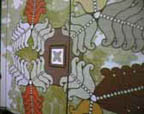
Flooding the Hub with Meaning
Xperception has created an environment where users of the printing hub of the Faculty of Architecture at the University of Sydney can gain a sense of knowledge about the labs and other surrounding areas. They flood the hub with meanings by incorporating an ambient installation, called The Hubscape, with a projection and lighting.
The system was inspired by the Activity Wallpaper Ambient Visualization which presented the users of a public space with information that was relevant to them in the form of a non obtrusive wallpaper. The shape and the intensity of the colours of the Hubscape wallpaper are influenced by factors such as: the timetable/scheduling of the classes, the sound levels, temperature and entropy within each lab but also the current incoming/outgoing network traffic data and the external temperature.
Above each printer the group installed lights. The speed of rotation animation of each light cluster is based on the printer queue size at their corresponding printer. The shorter the queue, the slower the rotation animation, for example. Besides, when a file is sent to one of the printers, its size is a measure of the number of bytes. This is represented in the installation by the relative brightness of the lighting devices.
Sounds a bit complicated, but have a look at their website and it will get much clearer.
The work will be presented at IE2005, Australasian Conference on Interactive Entertainment, 23-25 November 2005, Sydney. [blogged by Regine on we-make-money-not]
Posted by jo at 08:47 AM | Comments (0)
AwareCuffs
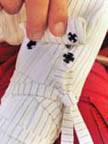
Off the Cuff WiFi Detection
AwareCuffs, the 2nd item of the AwareFashion collection, inform the wearer about wireless hotspots in her environment. Just by glancing at the cuffs, a person can check if wireless LAN is available. Small light patterns that appear on the cloth indicate if wireless LAN is available and the quality of service.
One cuff has an attached pocket and flexible transparent glass fibres are woven into the cloth. The wifi sensing technology is hidden in the small pocket. The circuit board in the pocket displays the quality of service by LEDs in different colors. The LEDs are connected to glass fibres, the light travels through them and small light spots appear at the end. When the technology pocket is detached the cuffs solely consist of cloth and glass fibres and can be washed. This concept also makes it possible to easily replace the technology function of the cuffs.
By Richard Etter and Diana Grathwohl. Other works by Richard Etter: The shirt that senses switched-on mobile phones and Melodious Walkabout. Related: Hotspot Bloom. [blogged by Regine on we-make-money-not]
Posted by jo at 08:45 AM | Comments (0)
November 02, 2005
idades

Virtual Ball Game
idades--by Antonio Urquijo de Simón, Carolina Padilla Villarraga, Daniel Desiderio Páez Castillo, Jordi Puig Vilà and Philip Morris--is a communication network of installations placed in transit spaces. In each of them, a spectator can recognize his or her simulated silhouette projected onto a screen and discover that his or her movements effect the trajectory of a virtual ball that bounces as it touches the edges of the silhouette. This triggers a game played by the body of the spectator, along with other passersby who enter the visual field of the camera.
The ball acts as an "interconnection device" which, as it collides virtually with the body of the players, promotes in them a corporal response to keep it in movement. The installation includes a camera used as a sensor, a computer connected to the camera that cuts the image of the people, a projector that displays the game, situated behind the interaction zone, and a screen, displayed in such a way as to ensure the normal circulation of people. Showing at the FILE Festival in São Paulo, through November 20, 2006. [blogged by Regine on we-make-money-not]
Posted by jo at 11:46 AM | Comments (0)
Sal Randolph
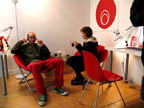
Opsound and Whereyouare
Last night at Upgrade! Boston, Sal Randolph presented two projects, Opsound and Whereyouare. Opsound is a gift economy in action, an experiment in applying the model of free software to music. Musicians and sound artists are invited to add their work to the Opsound pool using a copyleft license developed by Creative Commons. Listeners are invited to download, share, remix, and reimagine. Opsound is currently installed in the Glowlab: Open Lab exhibition at Art Interactive.
![]()
Whereyouare is an experiment in the collective documentation of neighborhoods. Randolph began the project with the idea of documenting her own neighborhood, Williamsburg, Brooklyn, whose quirky and ephemeral beauties are currently endangered by a wave of new development. Everyone is invited to participate by documenting any neighborhood they love. Those with material from neighborhoods which have now been damaged or destroyed by Katrina are especially encouraged to contribute.
Posted by jo at 11:29 AM | Comments (0)
Electronic Literature Collection
![]()
Call for Works
The Electronic Literature Organization seeks submissions for the first Electronic Literature Collection. We invite the submission of literary works that take advantage of the capabilities and contexts provided by the computer. Works will be accepted until January 31, 2006. Up to three works per author will be considered.
The Electronic Literature Collection will be an annual publication of current and older electronic literature in a form suitable for individual, public library, and classroom use. The publication will be made available both online, where it will be available for download for free, and as a packaged, cross-platform CD-ROM, in a case appropriate for library processing, marking, and distribution. The contents of the Collection will be offered under a Creative Commons license so that libraries and educational institutions will be allowed to duplicate and install works and individuals will be free to share the disc with others.
The editorial collective for this first volume of the Electronic Literature Collection, to be published in 2006, is:
N. Katherine Hayles
Nick Montfort
Scott Rettberg
Stephanie Strickland
This collective will review the submitted work and select pieces for the Collection.
The editorial collectives for each volume will be chosen by the Electronic Literature Organization’s board of directors. The tentative editorial collective for the second Collection, to be published in 2007, includes Matthew G. Kirschenbaum, Marjorie C. Luesebrink, and Noah Wardrip-Fruin.
Literary quality will be the chief criterion for selection of works. Other aspects considered will include innovative use of electronic techniques, quality and navigability of interface, and adequate representation of the diverse forms of electronic literature in the collection as a whole.
For the first Collection, the collective will consider works up to 50 MB in size, uncompressed. Works submitted should function on both Macintosh OS X (10.4) and Windows XP. Works should function without requiring users to purchase or install additional software. Submissions may require software that is typically pre-installed on contemporary computers, such as a web browser, and are allowed to use the current versions of the most common plugins.
To have a work considered, all the authors of the work must agree that if their work is published in the Collection, they will license it under a Creative Commons Attribution-NonCommercial-NoDerivs 2.5 License, which will permit others to copy and freely redistribute the work, provided the work is attributed to its authors, that it is redistributed non-commercially, and that it is not used in the creation of derivative works. No other limitation is made regarding the author’s use of any work submitted or accepted.
To submit a work:
1. Prepare a plain text file with the following information:
* The title of the work.
* The names and email addresses of all authors and contributors of the work.
* The URL where you are going to make your .zip file available for us to download. The editorial collective will not publish the address of this file.
* A short description of the work — less than 200 words in length.
* Any instructions required to operate the work.
* The date the work was first distributed or published, or “unpublished” if it has not yet been made available to the public.
2. Prepare a .zip archive including the work in its entirety. Include the text file from step (1) at the top level of this archive, and name it “submisson.txt”.
3. Upload the .zip file to a web server so that it is available at the specified location.
4. Place all of the text in the “submisson.txt” file in the body of an email and send it to collection[at]eliterature.org with the name of the piece being submitted included in the subject line.
The Electronic Literature Collection is supported by institutional partners including the Center for Programs in Contemporary Writing (CPCW) at the University of Pennsylvania, ELINOR: Electronic Literature in the Nordic Countries, Maryland Institute for Technology in the Humanities (MITH) at the University of Maryland, The Richard Stockton College of New Jersey, and The School of Journalism and Mass Communication at the University of Minnesota.
Posted by jo at 11:12 AM | Comments (0)
Lynn Hershman
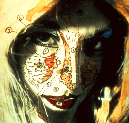
Sci-Femme Retrospective
In the early-1980s, American artist Lynn Hershman developed the first interactive video art disk, which featured Lorna, an indecisive agoraphobe living a 'remote control life.' Viewers navigated the thirty-six chapters encapsulating Lorna's seventeen minutes on film to create personalized stories. Now this and other formative cyberfeminist works by Hershman are on view in a touring retrospective opening November 5, at Seattle's Henry Art Gallery. Hershmanlandia surveys thirty-five years of new media art, film, and video work. Besides working with digital avatars and surveillance technologies, Hershman has crossed over into the realm of feature filmmaking with two movies critics dubbed 'feminist science fiction.' Starring iconic actress Tilda Swinton, these experimental comedies revolve around themes of artificial intelligence, cloning, and virtual identity. Recently, Hershman has bridged the gap between her media art and film by translating a character from her 'Teknolust' into the web-based persona, Agent Ruby. This sensitive avatar verbally responds to users' typed queries, so come with questions prepared. - Matt Wolf, Net Art News, Rhizome.org
Posted by jo at 10:59 AM | Comments (0)
Three Threats to the Survival of New Media
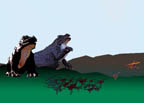
version 1.4 by Jon Ippolito
"... To be a historian of new media art is a precarious career choice. It's a lot easier to be a historian of old media, if only because the artists you study are no longer likely to turn around and contradict your theories; Picasso historians had a much easier time talking about his work once he was pushing up daisies instead of painting them. But if dead artists are a boon for historians, dead media are not. In fact, as soon as the media you study become obsolete, it's a bit of a stretch to call yourself a "historian of new media."
The bad news I have for new media historians is that the objects they study are in danger of evaporating out from under their studious gaze. On three separate battlegrounds, dinosaurs fattened on broadcast economies threaten to trample the newer species evolving in today's electronic networks. In some cases this attempt is deliberate: Microsoftus Rex and TimeWarnerSaurus have little interest in encouraging the unimpeded evolution of media. In other cases, as I hope to show, even new media advocates--including many of you in this room--unwittingly buy into hierarchic models of preservation, property, or professorship that endanger the unfettered evolution of digital art..." From Three Threats to the Survival of New Media by Jon Ippolito.
Posted by jo at 10:40 AM | Comments (0)
criticalartware
![]()
Dan Sandin Interview
Since the late 1960's Dan Sandin has developed artware systems integrating digitial + analog computers, customized circuits, home{brewed|built}-hardware, video games + virtualReality. Sandin, a professor at the University of Illinois at Chicago, founded the Electronic Visualization Lab (EVL), created the Sandin Image Processor (I.P.), developed the CAVE virtual reality (VR) system + various other [artware systems/technologies/projects/pieces]. His Image Processor (built from 1971 - 1973) offered artists unprecedented abilities to [create/control/affect/transform] video + audio data, enabling live audio video performances that literally set the stage for current realtime audio video art praxis.
To facilitate the open release of the plans for the Image Processor as an [artware/system/toolset], Sandin + Phil Morton created the Distribution Religion. As a predecessor to the open source movement in the tradition of free software, this approach allowed artists to engage with these hardware systems + continues to [interest/inspire] [artisits/developers]. In order to honor the innovative {recent futures|parallel hystories} of the Image Processor + the Distribution Religion, criticalartware has converted the deadTree Distribution Religion into a single PDF file + a web-based version, for release to the {criticalartware} community.
criticalartware interviews Dan Sandin, [discussing/illuminating] the community + development of the early moments of video art in Chicago, artware, performing live audio video, virtual reality, open source, righteous NTSC outputs, the video revolution + the changes + similarities that [bridge/differentiate] then && now. criticalartware freely offers this interview as {text|audio|video} data to be downloaded via the interweb + exchanged as shared cultural resources.
Posted by jo at 10:22 AM | Comments (0)
JEFF TALMAN
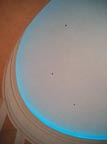
IN TRANSIT
International artist Jeff Talman will mount a new installation--In Transit--in an exhibition that explores the sonic resonance of the InterContinental Hotel atrium. In this site-specific sound work Talman exposes the nuances embedded in the ‘silence’ of the 4-story, dome-capped space.
In Transit features the actual resonant frequencies of the atrium extracted from the room tone or ‘silence’ of the site. Installed in the hotel atrium, the installation feeds the site resonance back into the space. Because the resonance is perfectly tuned to the site it is naturally amplified by the space. The results are a re-resonating sound field in which the inherent sonic ‘presence’ of the atrium itself is brought forward for the listener as intuitive notions of sound and spatial perception are enhanced.
Regarding the title, Talman noted, “We are constantly in transit – moving through spaces – with too many other concerns to spend much time reflecting on where we are, where we have come from, and where we are going. When we do reflect on our surroundings, we acquire the sense of a place largely through visual perception. But our place-sense is also highly dependent on the self-sound of a site, of which we have a much lower consciousness, perhaps only an intuitive grasp. By emphasizing this unique place sound I hope to make available a larger, instinctive sense of site that is fundamental to our perception of the world.”
In the InterContinental Hotel – Chicago, exploring the sound of ‘silence’: NOV. 7 – 13, 2005
Talman’s other new soundspace installation, ‘Absolute Elsewhere,’ which is based on similar properties of site resonance, opens three days later on November 10 in St. James Cathedral, which is near the hotel. The two installations coincide with the Nineteenth Conference of the Society for Literature, Science and the Arts, which is one of the installations’ sponsors along with the University of Illinois-Chicago, and Emerson College, Boston where Talman teaches. He is represented by bitforms in New York City.
Posted by jo at 10:05 AM | Comments (0)
November 01, 2005
VIDA 8.0

Art & Artificial Life International Competition
FIRST PRIZE (10.000 euros): AP0201, Martin Howse, Jonathan Kemp; U.K.: The desert of Southern California is a surreal wasteland of military bombing ranges and toxic waste, beautiful vistas and endangered species, and now three peculiar artificial life entities. UK Artists Martin Howse and Jonathan Kemp built these stark, semi-official looking devices at a research station run by the Center for Land Use Interpretation. In this arid landscape, Howse and Kemp hacked out what might be confused for remote meteorological stations, but are actually far more ambiguous devices. They harvest and store solar power, communicate with each other through wireless, listen to military jets, birds, and the wind, and constantly modify their own code. Their small computer displays tells us nothing -- we have no way of entering their processing or conversation. They are functionally inscrutable, while nonetheless communicating a sort of technical authority. While their location is available as GPS coordinates it's hard to imagine what one would gain by visiting them, and knowing the American Southwest they would probably be peppered with bullet holes anyway. Quixotic as they appear, they nonetheless present a challenge to our self-importance, as oblivious to our curiosity as are the desert tortoises or cacti that share their space.
SECOND PRIZE (7.000 euros): LIVEFORM:TELEKINETICS (LF:TK)--Michelle Teran & Jeff Mann, Germany/Canada: Corkscrews whirl and spin, toasters with arms made from knives and forks wave rhythmically in the air, tea-strainers open and close their mouths in harmonic accompaniment. A joyful gathering of everyday kitchen equipment, appear to dance together to the beat of the music. But on the surface what looks like just 'too much' happiness and fun becomes sobering. It is disturbing to realise how easily a whole value system which promotes functionality, seamless productivity and efficiency, from the world of business communications machinery has been absorbed and accepted as the 'normal' tools, behaviours and etiquette for network communications within our personal and social lives. LiveForm:Telekinetics clearly shows us how our communications with the people we care for and love are being limited by the tools we have uncritically accepted. The enchanted objects celebrate through the social mediums of music and play, new communication languages, new networked social experiences, and the creative social processes in the production of the objects themselves, reminding us what it is we have been missing all this time.
More about the awards >>
Posted by jo at 09:02 AM | Comments (0)
